On the Toronto Council agenda for May 22, 2024, there was a motion asking for Transportation Services to investigate changes in traffic regulations on Dundas Street in anticipation of coming work on Spadina Avenue and at Spadina Station. This will replace streetcars with buses for a period from late June to mid-December, 2024, and the buses will not operate on the streetcar right-of-way.
Community Council Decision Advice and Other Information
The Toronto and East York Community Council requested the General Manager, Transportation Services to report directly to the May 22, 2024 meeting of City Council on recommended temporary parking, loading and traffic amendments on Dundas Street West that would support timely and reliable streetcar service on Dundas Street West between Spadina Avenue and McCaul Street during construction at Spadina Station.
Summary
During the June to December 2024 closure of the 510 Spadina streetcar for construction at Spadina Station, the Toronto Transit Commission (TTC) wishes to enhance alternate routes for customer movement to and through the Chinatown neighbourhood. One key alternate route is the 505 Dundas streetcar. Unfortunately, this streetcar is frequently delayed by acute traffic congestion between Spadina Avenue and McCaul Street. To improve timeliness and reliability of 505 Dundas streetcar service through Chinatown during the Spadina closure, TTC is requesting that Council temporarily modify left-turn prohibitions, reduce on-street general-use parking, and add no stopping restrictions in strategic locations and timeframes along Dundas Street West between Spadina Avenue and McCaul Street. Designated loading zones may also help to reduce conflicts with streetcar service while supporting local businesses.
Transportation Services has replied to this request with a recommendation for changes in parking, stopping and turning restrictions on Dundas between McCaul and Spadina. Current curb lane restrictions are for no parking or stopping only in peak periods, with a mixture of paid and unpaid parking allowed at other times. There are also various turning restrictions (see the reply for details). The proposed changes are:
- Between McCaul and Spadina, Dundas would be a No Stopping zone in both directions at all times.
- Between University and McCaul, the peak direction (eastbound AM, westbound PM) would be a No Stopping zone.
- Left turns eastbound and westbound at Dundas and Spadina would be banned between 7 am and 10 pm on all days.
A coach loading zone will be preserved in front of the Art Gallery (south side of Dundas, west of McCaul), and “consultation will be undertaken with the Chinatown BIA to identify areas where loading zone could be designated”.
Council amended the staff recommendation to asked for a “report back to the Toronto and East York Community Council by the fourth quarter of 2024 on the effectiveness of these changes for streetcar operations and a recommended long-term plan for parking, loading and traffic regulations on Dundas Street West between Spadina Avenue and McCaul Street.”
How much these changes will contribute to the Dundas car’s operation remains to be seen. There are already peak period restrictions on Dundas, and so there would be no change at those times. As always, the question of enforcement in practice vs regulation in theory is a problem. Moreover, 505 Dundas service is much less frequent than the combined services on King, and transit’s presence on Dundas is nowhere near as dominant. At most times, the scheduled service is every 10 minutes, and the most frequent service, 7 minutes, is on Saturday afternoons.
There is much more to the 505 Dundas route than the short section east of Spadina, and any review of the route should look at it over all. The travel time between University and Spadina, even on “bad” days, is under 10 minutes and the likely saving of any restrictions will be at best 4 minutes, likely less. Focus on a single segment will not address wider problems along the route.
The remainder of this article looks at travel times for 505 Dundas cars in April 2024 as a “before” point of reference, and to high light other areas where cars are (and are not) delayed.
End-to-End Travel Times
The times shown in the charts below use screenlines just south of Danforth and Broadview in the east, and at Bloor and Dundas in the west. The purpose is to avoid distortion from congestion within the terminal loops and the approaches to them. Westbound stats are shown on the left, eastbound on the right. Saturdays and Sundays are charted separately.
Several points to note:
- Data grouping is based on the time a car crossed the origin screenline. For example, any trip that crossed the line south of Danforth on Broadview between 1:00 and 1:59 pm is counted in the 1 pm stats.
- The longest average weekday trip times occur from mid-afternoon through early evening.
- There is some variation in averages for each week in April likely due to short-lived local conditions such as construction enroute. In both directions, the longest times occur in week 4, April 22-26
- Saturday averages peak late in the afternoon at levels comparable to weekdays. Sundays are only slightly better. Congestion on this route is not a weekday-only problem.
- The standard deviation values for the data lie generally from 5 to 10 minutes indicating the degree of variation in times for a majority of trips. This affects how individual cars might arrive at terminals as well as variations in layovers they will take before departure. An SD value of 5 minutes suggests that about two thirds of the service will take ±5 minutes of the average time to cross the route.
- Week 5 contains only Monday-Tuesday April 29-30. Other weeks have a full Monday-Friday set of data.

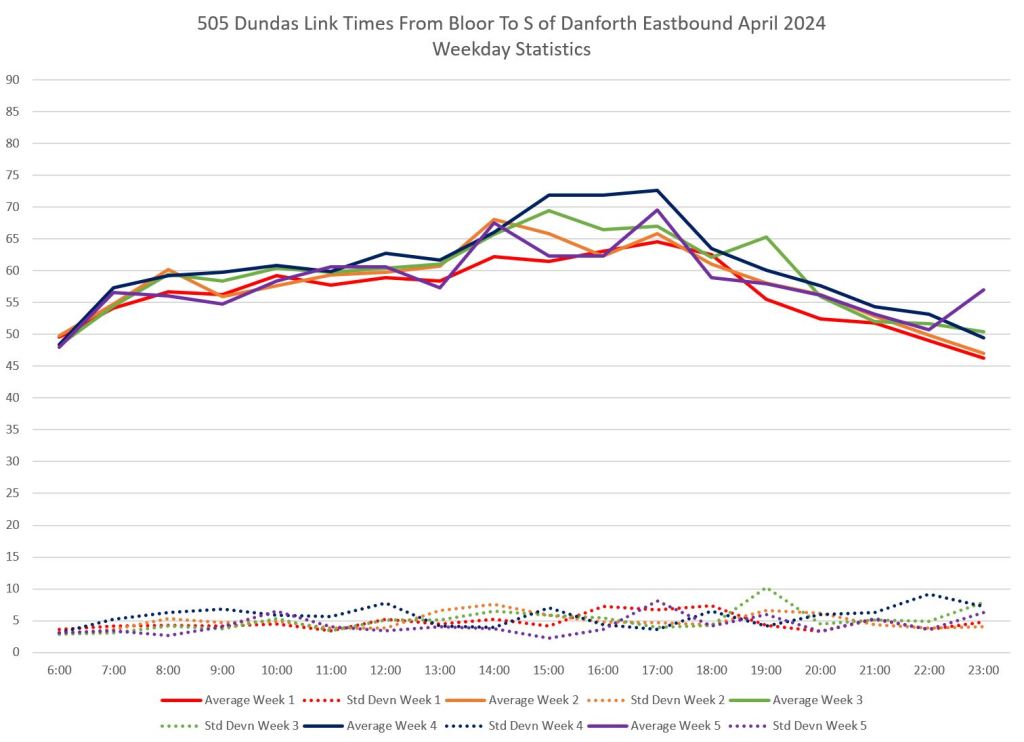
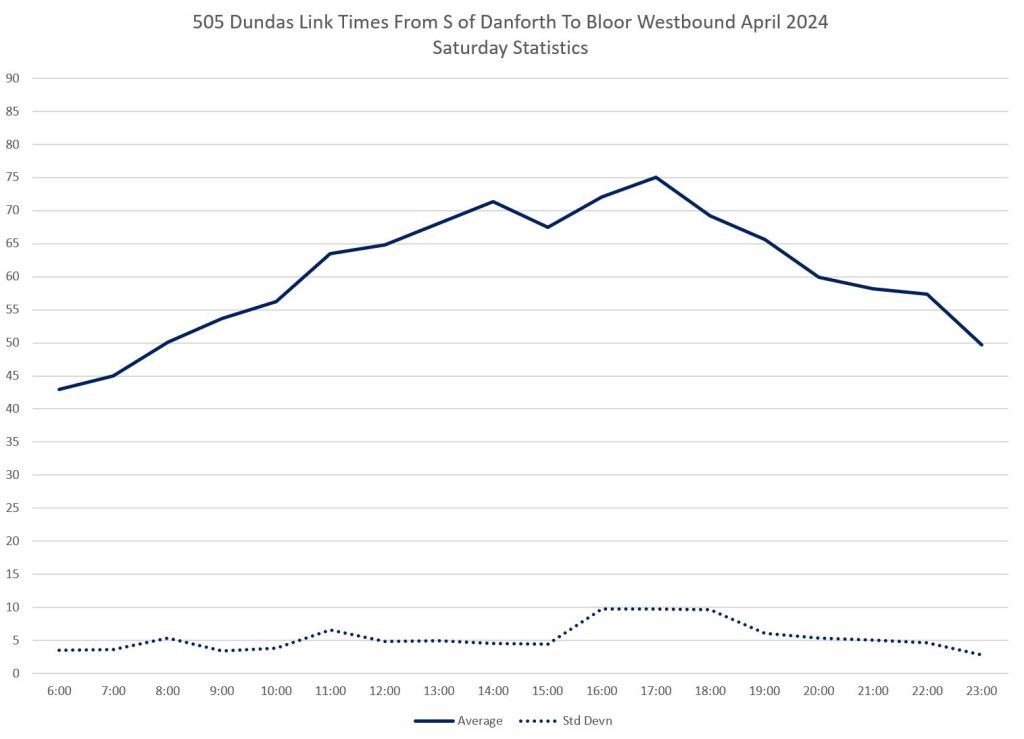
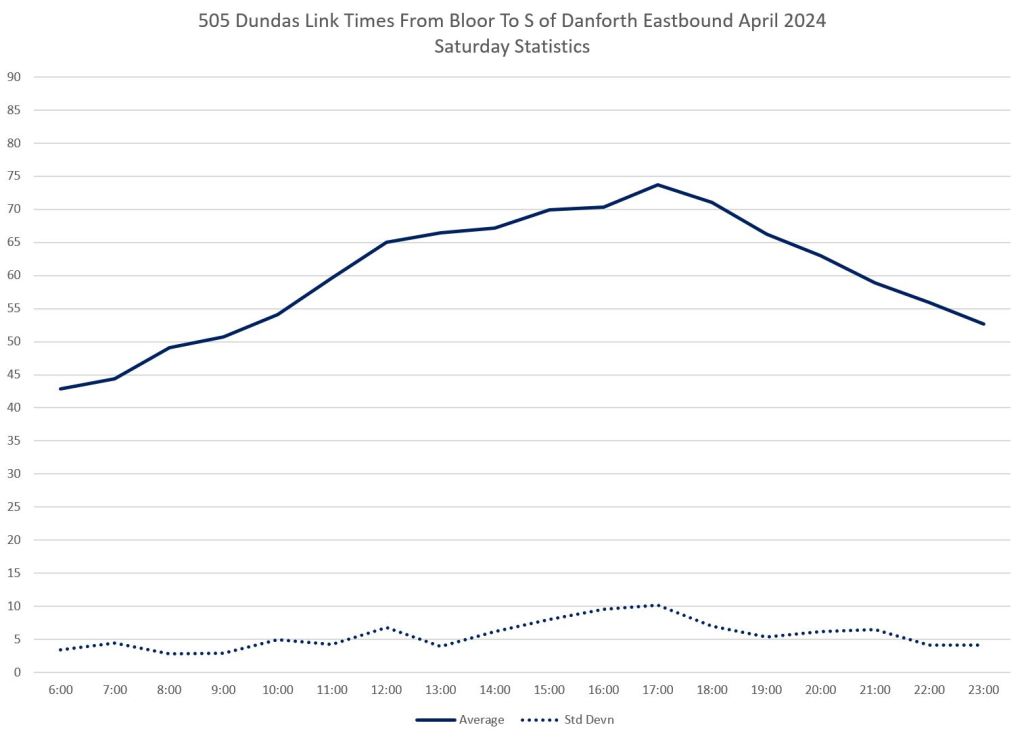
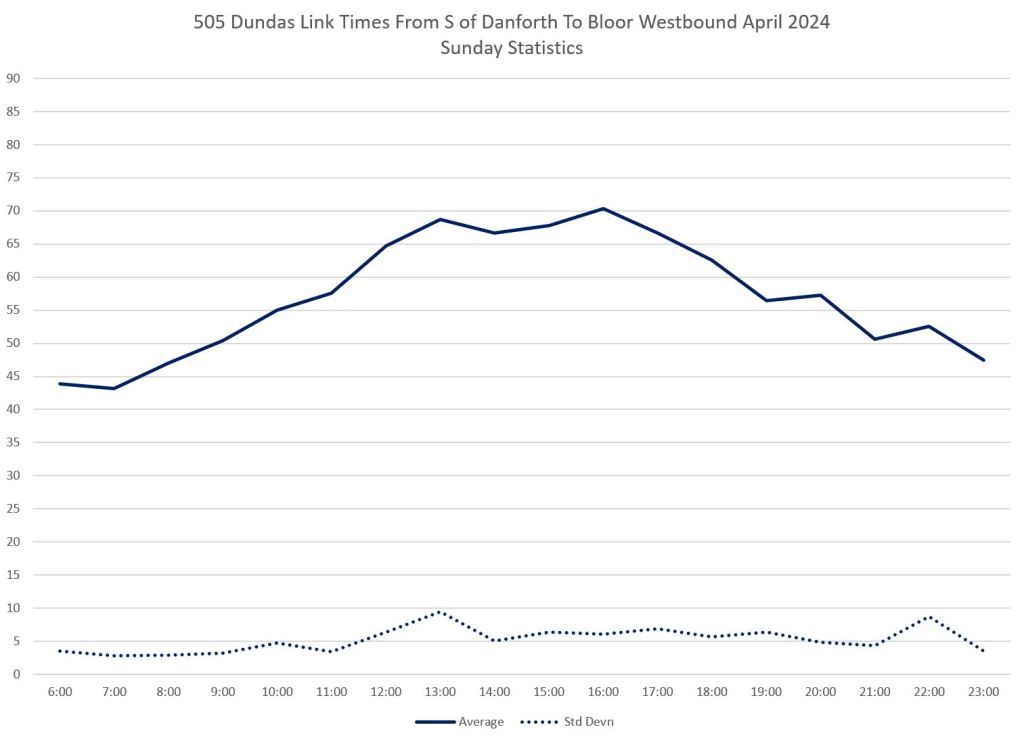

Looking at the eastern and western portions of the route shows that there is more variation over the day west of Yonge than east of it, particularly for westbound trips. The standard deviation values for the west side of the line are generally higher and that this is consistent for much of the day even though traffic conditions would vary. Something other than “traffic” might be at work here.
(Note that the full route charts above have a maximum Y value of 90 minutes, while the part route charts below use 60. In the following section looking at short route segments, the maximum Y value is 30 minutes.)
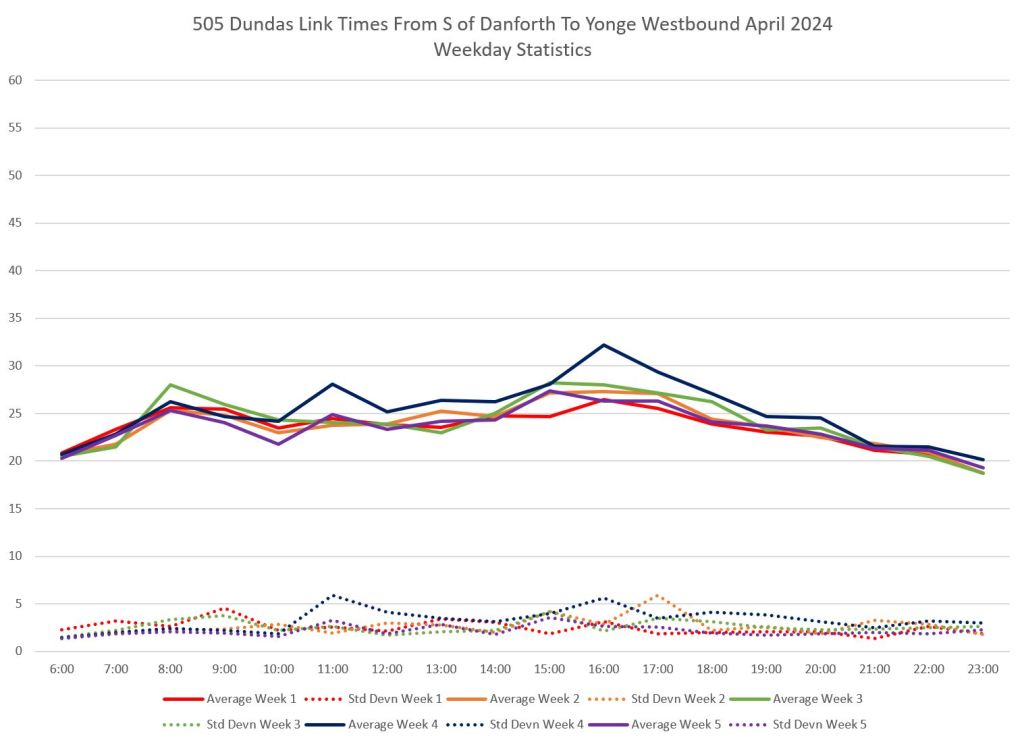

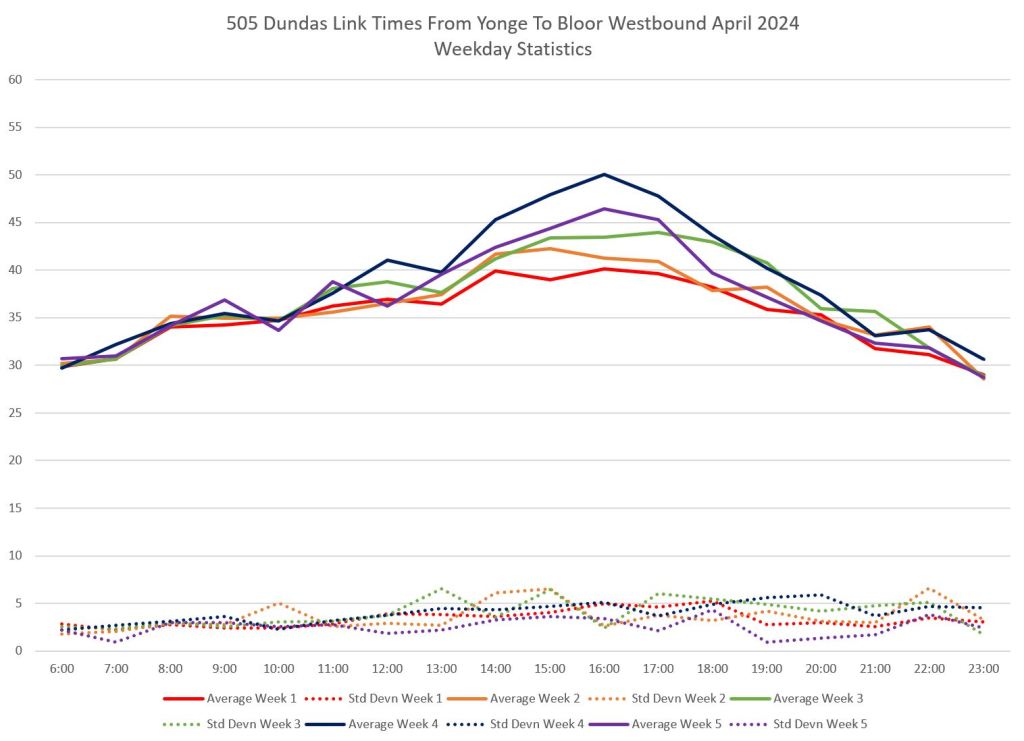
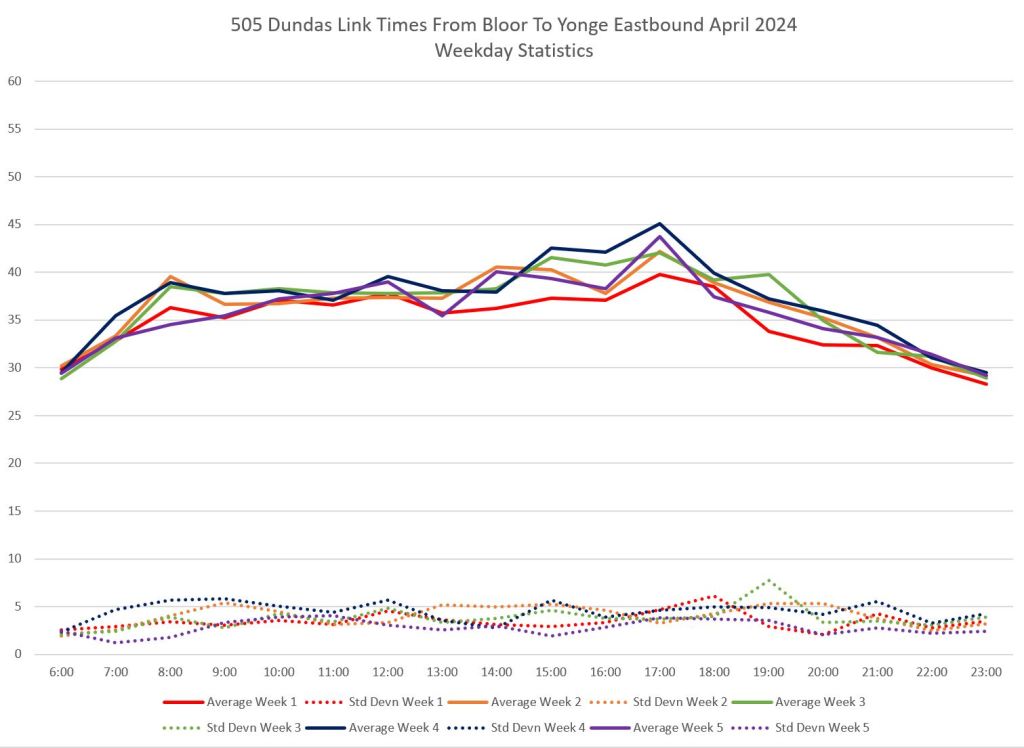
Route Segment Link Times
The following charts show the weekday statistics for sections of the route. In some cases, the lines across the charts are flat indicating that travel time averages stay more or less the same all day. Other times show clear increases that appear in most or all weeks’ data. Westbound times are on the left, eastbound times on the right.
A striking factor in charts of the route segments is that some of them show little variation over the entire day, and peak period effects are small in many cases. The cumulative effect of many small running time changes plus a few key segments with larger ones produces the much larger variation over he entire day shown above.
In several cases, the PM peak rise in travel times begins in the 3-4pm slot and this does not always persist through the wider peak to 6-7pm. In previous studies of Dundas and other streets, a common issue was the conflict between peak traffic conditions that might exist from 3-7pm with a desire by merchants to minimize the No Stopping period. This can produce longer travel times on the shoulders of the peak when traffic volumes are high but parking throttles street capacity.
Where a value spikes within one hour and for only one of the five weeks, this usually corresponds to a major delay that pushes up averages for that interval. Chronic conditions show up over 1 or more hours in multiple weeks. Where delays appear in some, but not all, weeks, this usually corresponds to a temporary condition such as a construction project blocking part of the road that would otherwise be open.
Week 4 (Apr 22-26) shows up for several segments with longer than average times. This indicates effects that are not due to a single event such as a temporary lane closure. Later in the article, I review data for this week in more detail.
Danforth Avenue to Yonge Street
The eastern section of 505 Dundas is less affected by delays because much of the route is on streets with free-flowing traffic. However, there are exceptions.
- During the early PM peak, before parking restrictions kick in, delays occur northbound on Broadview to Danforth in some weeks.
- The section from Parliament to Broadview has longer travel times during the PM peak and both shoulder periods. This is particularly striking in week 4 when all of the Queen Street services diverted via Dundas around repairs on the bridge at the Don River.
- Although riders of the 505 Dundas car are familiar with slow operations westbound toward Yonge Street, this does not show up as high peaks in the average times. However, those averages do bounce around through the entire day. This area is reviewed in detail later in the article.
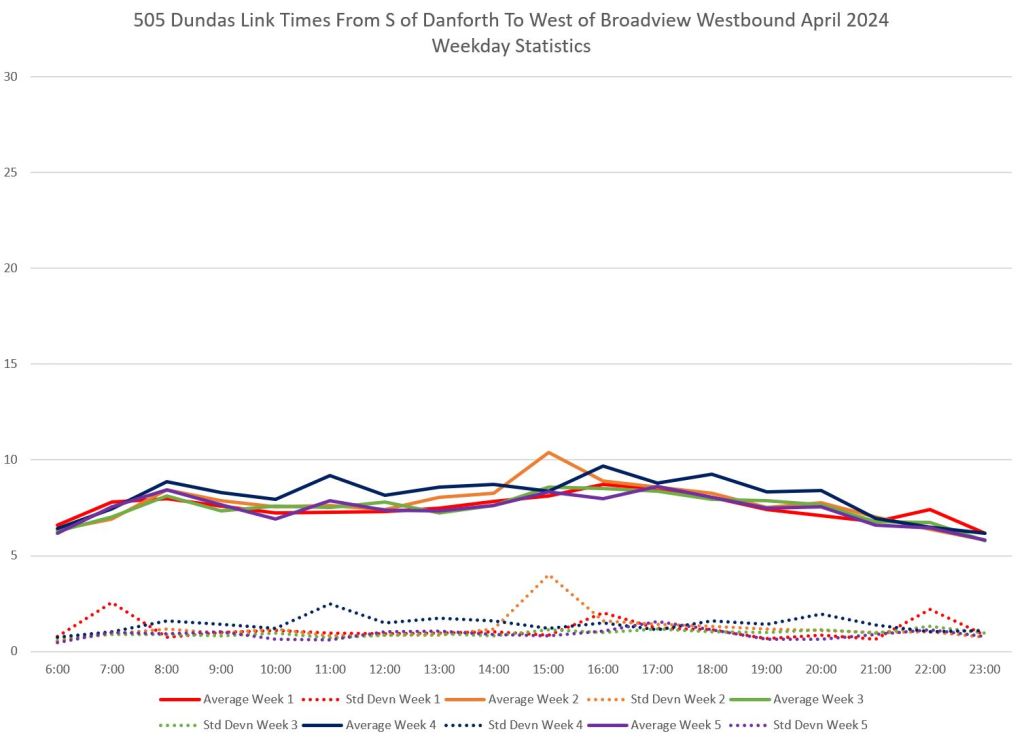
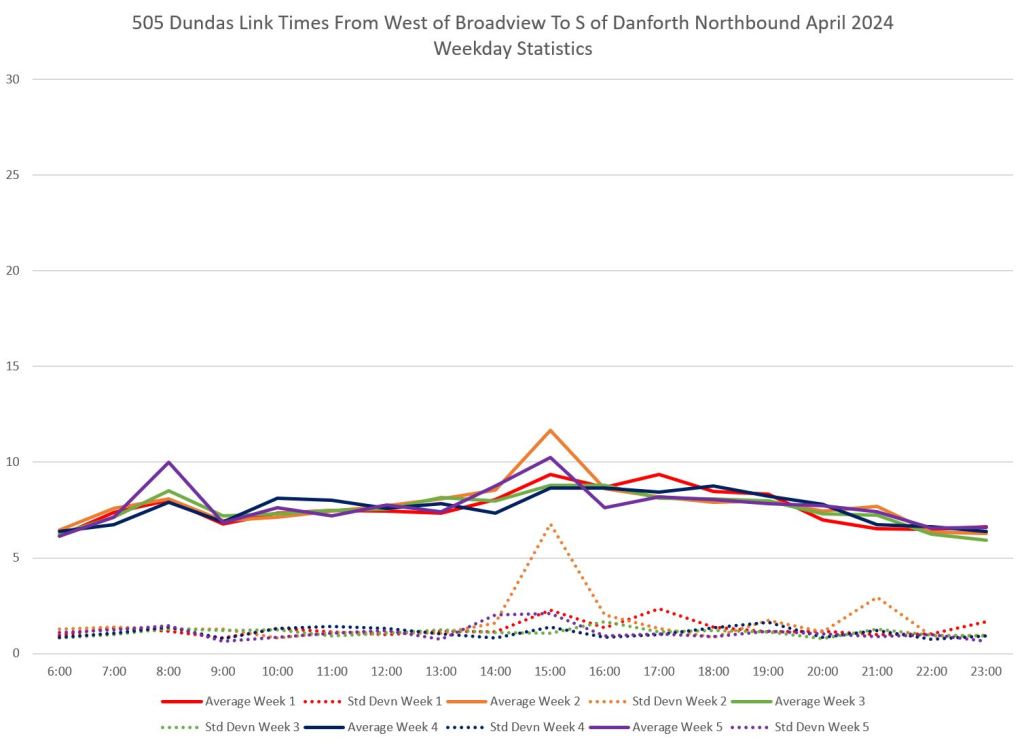
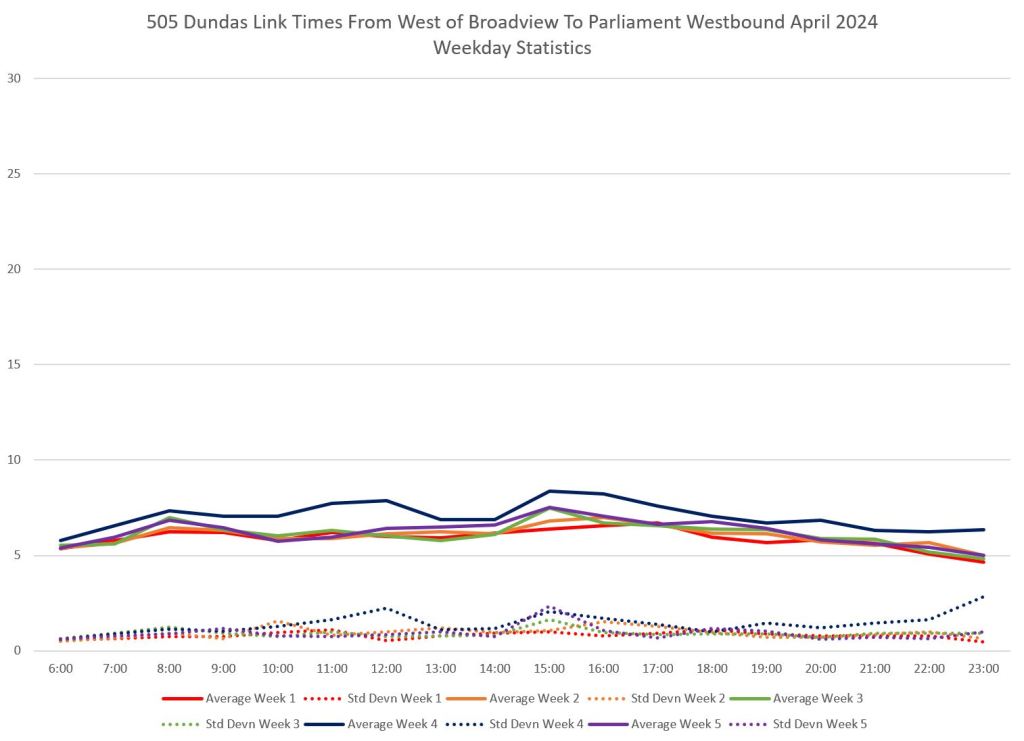




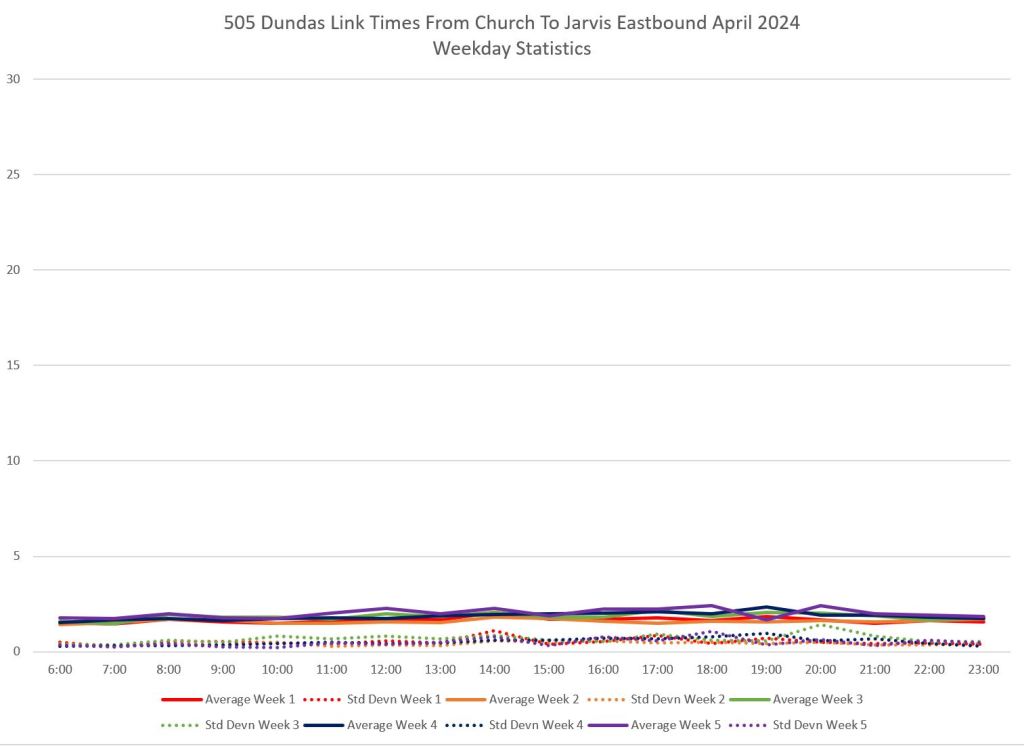
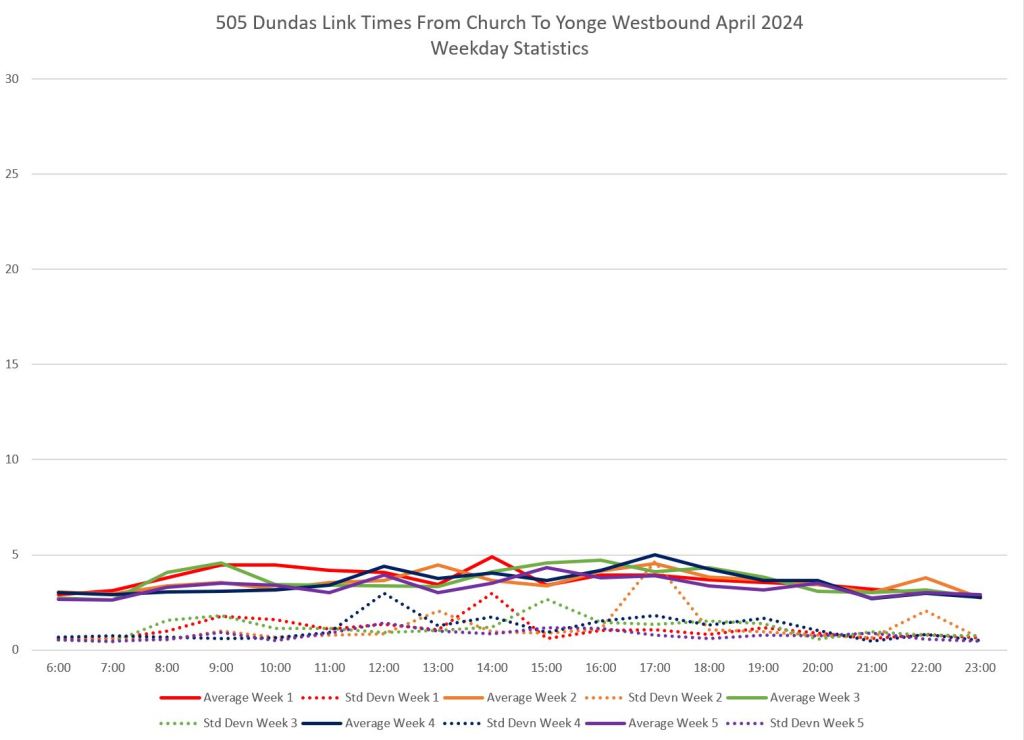
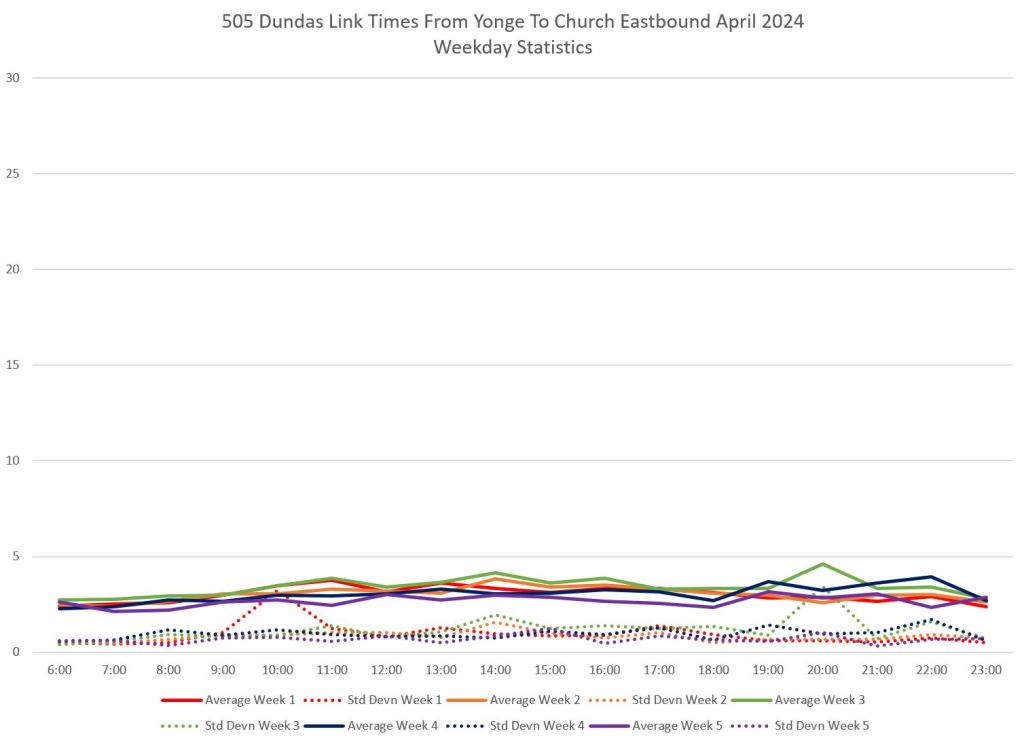
Yonge Street to Bloor West
The west side of 505 Dundas operates in a more congested environment than the east side, although this is not uniform along the route. The important point here is that there are many small contributions to overall travel delays along this route and “fixing” one short segment will have a limited effect. Given the on-again, off-again nature of some delays (they do not appear consistently in each week’s data), understanding what causes them will be key to designing remedies.
- Travel times eastbound from Bay to Yonge, a short distance, rise after the AM peak and the averages move around a fair amount for such a short stretch. This area is plagued with curb lane blockages.
- The section from University to Spadina westbound shows higher travel times from late morning to early evening, although in the data here this appears mainly in the latter half of the month. Eastbound travel does not show the same effect.
- From Spadina to Bathurst westbound, there is also a rise in travel times in the latter weeks, but it is confined to the PM peak and its shoulders.
- From Ossington to Bathurst eastbound, there are small peak effects in both the morning and afternoon
- From Ossington to Dufferin westbound, there is congestion during the midday.
- From Dufferin to Lansdowne westbound, travel times rise during the PM peak.
- In the same area, eastbound travel times rise after the AM peak.
- From Roncesvalles to Lansdowne eastbound, travel times are longer in the PM peak.
- From Roncesvalles/Dundas north to Bloor/Dundas, travel times rise in the PM peak. Some of this is due to queuing of streetcars on the approach to Dundas West Station Loop.
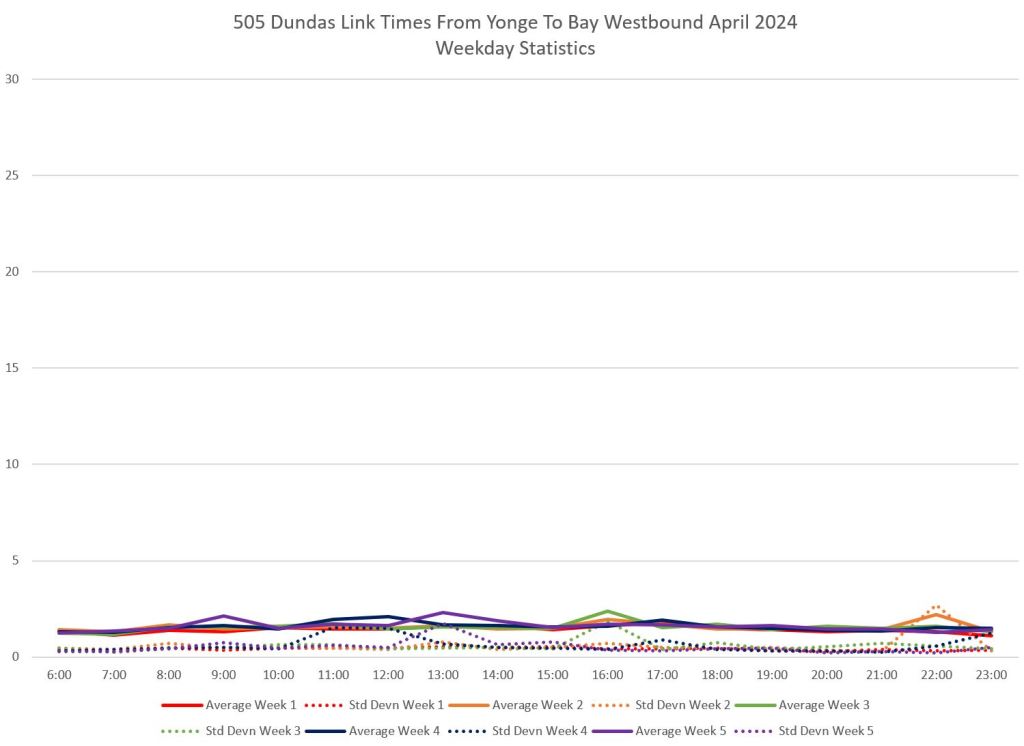

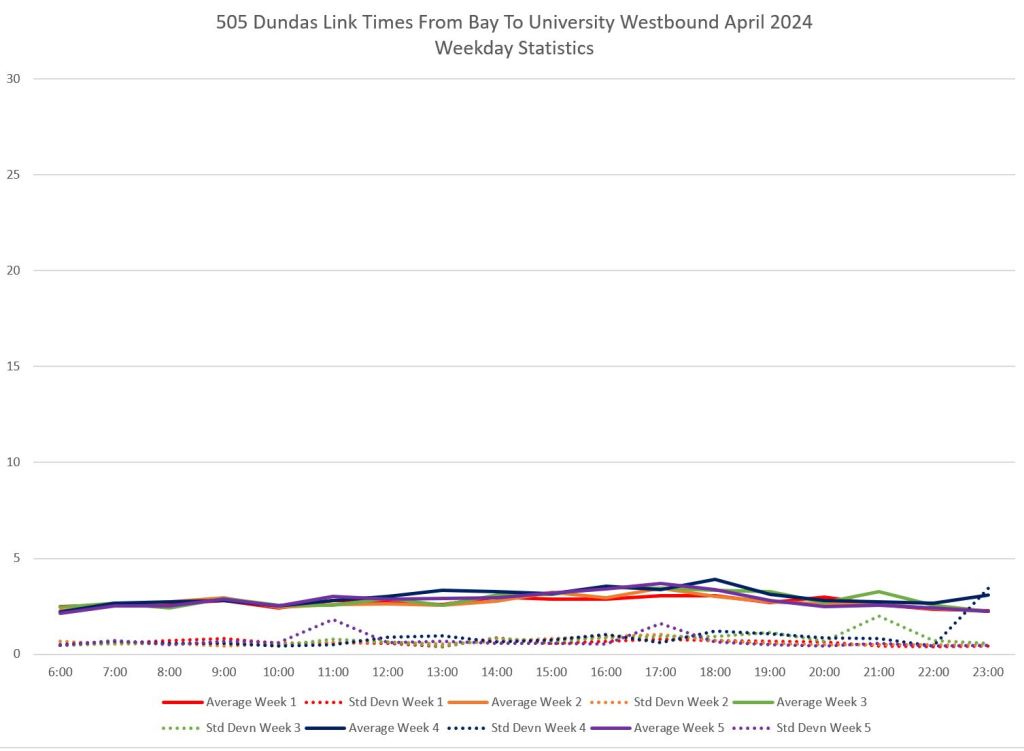
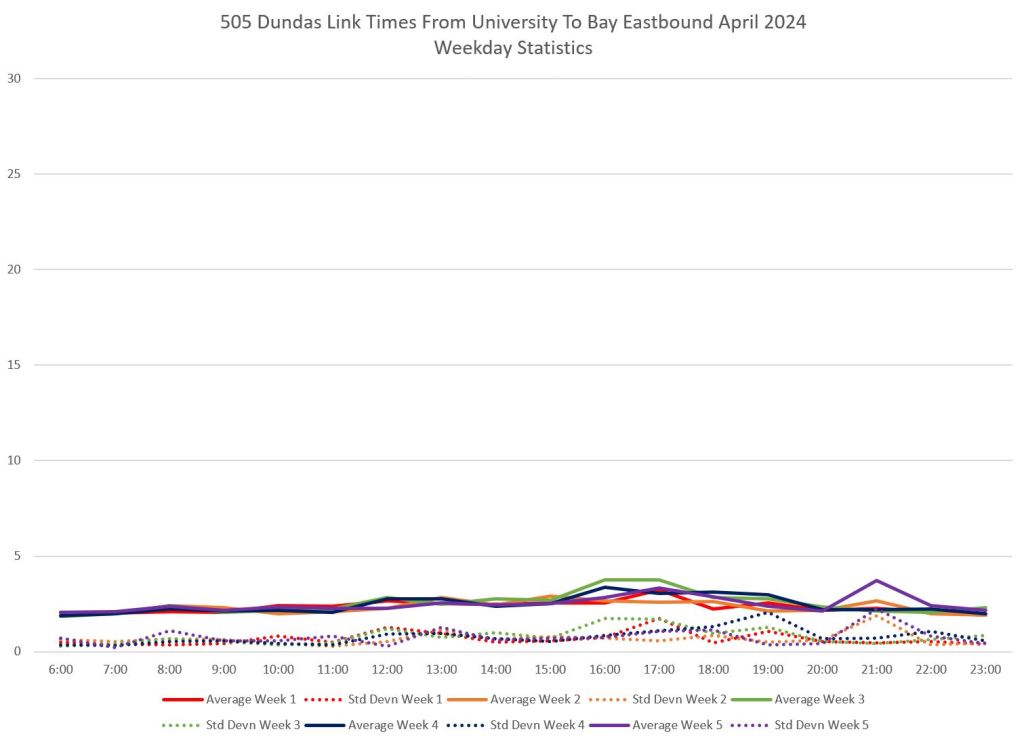
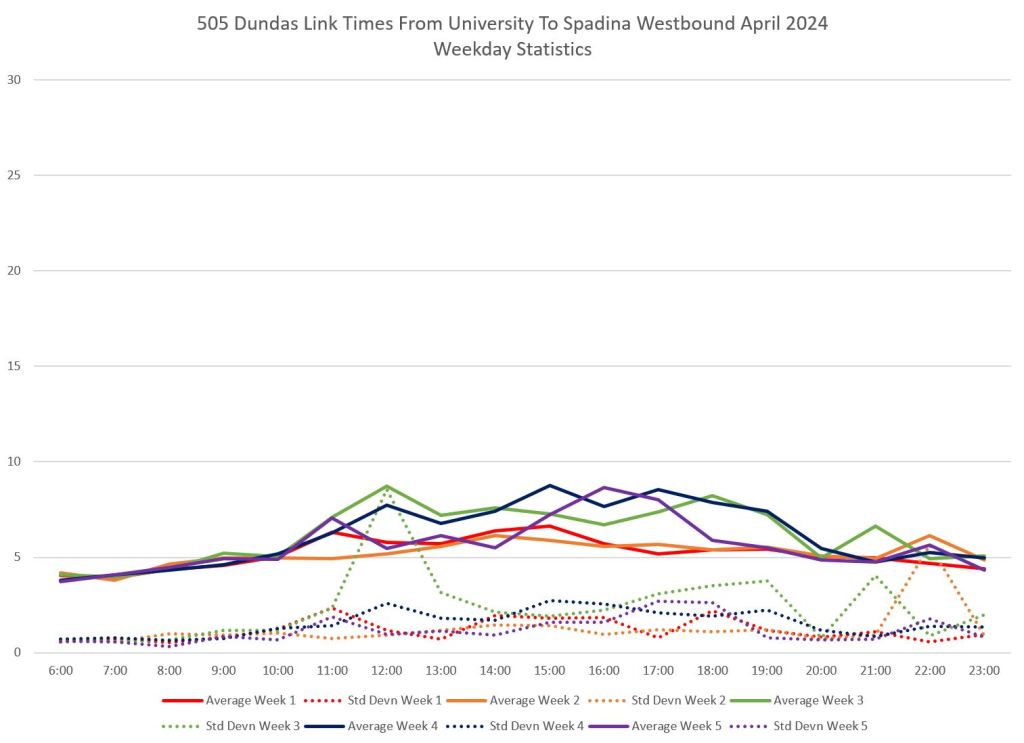
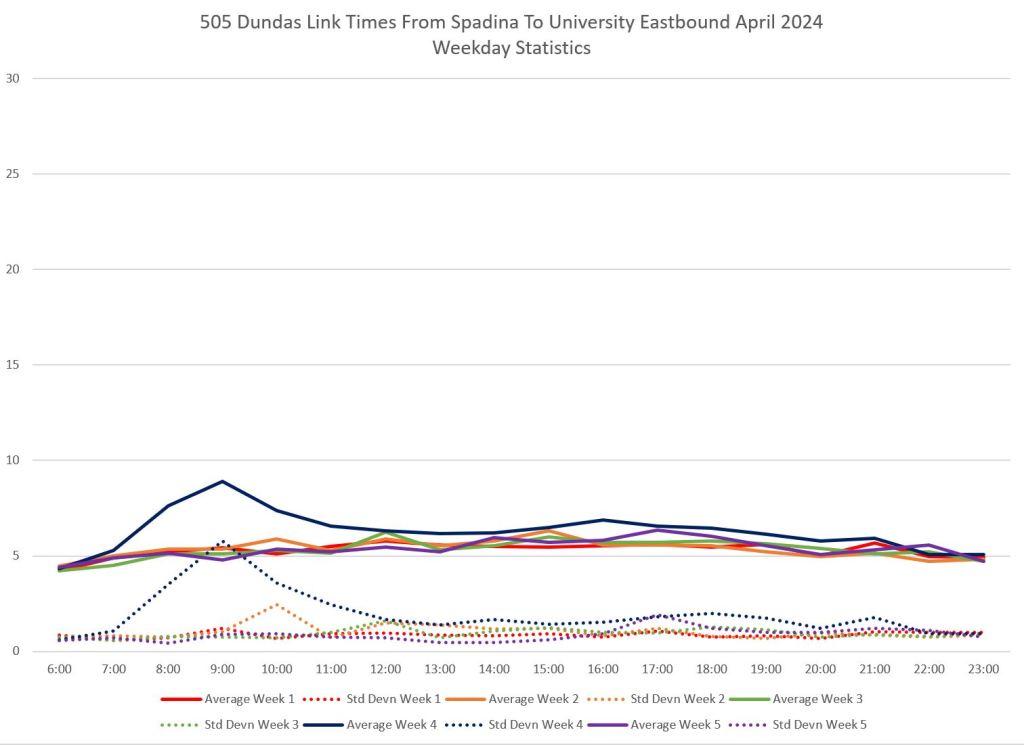
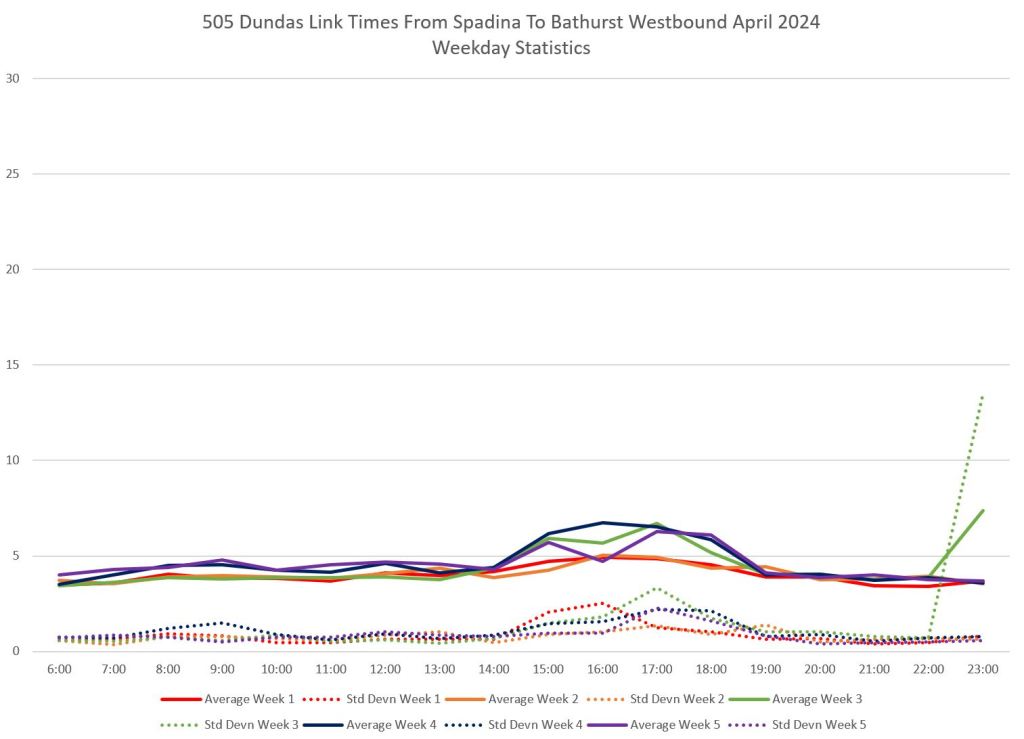

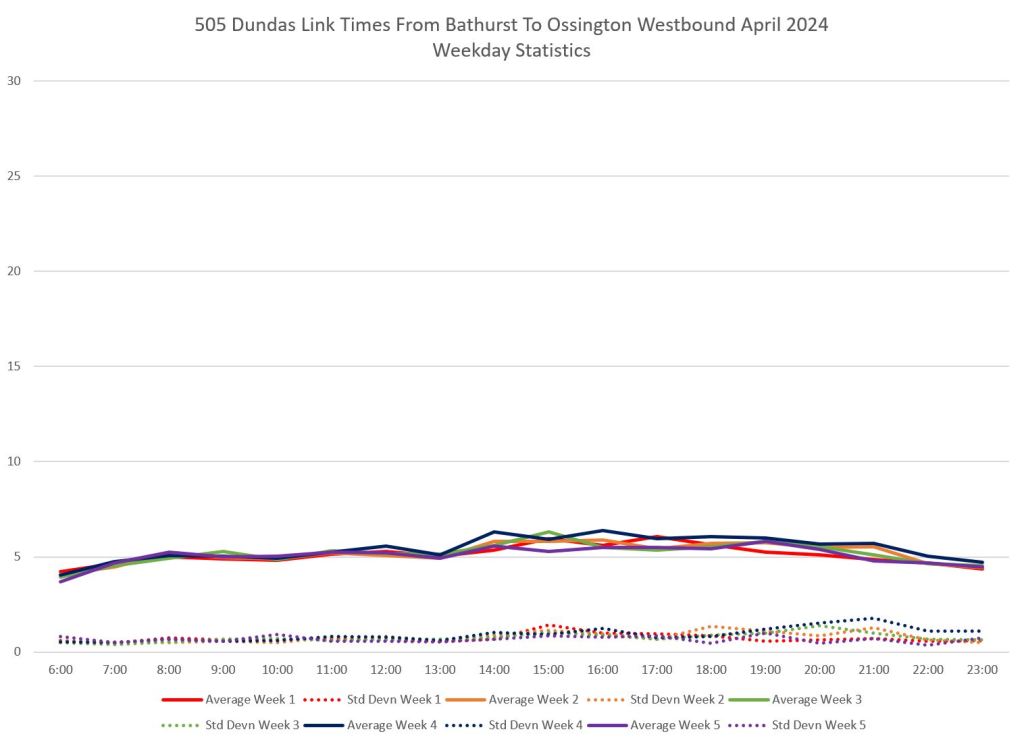
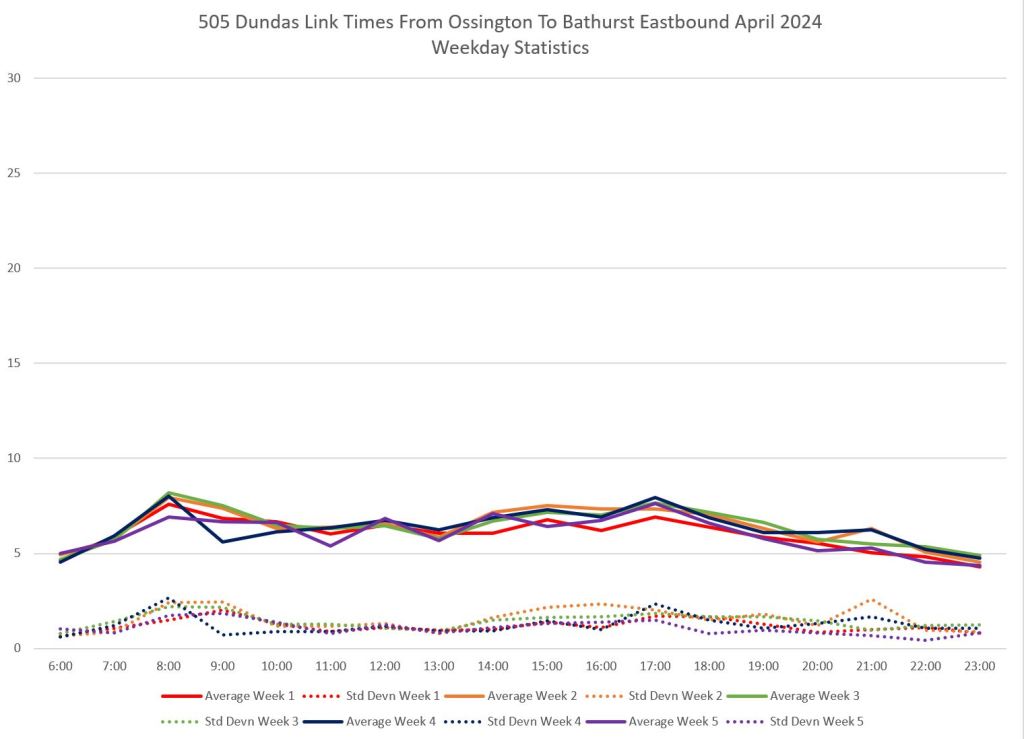


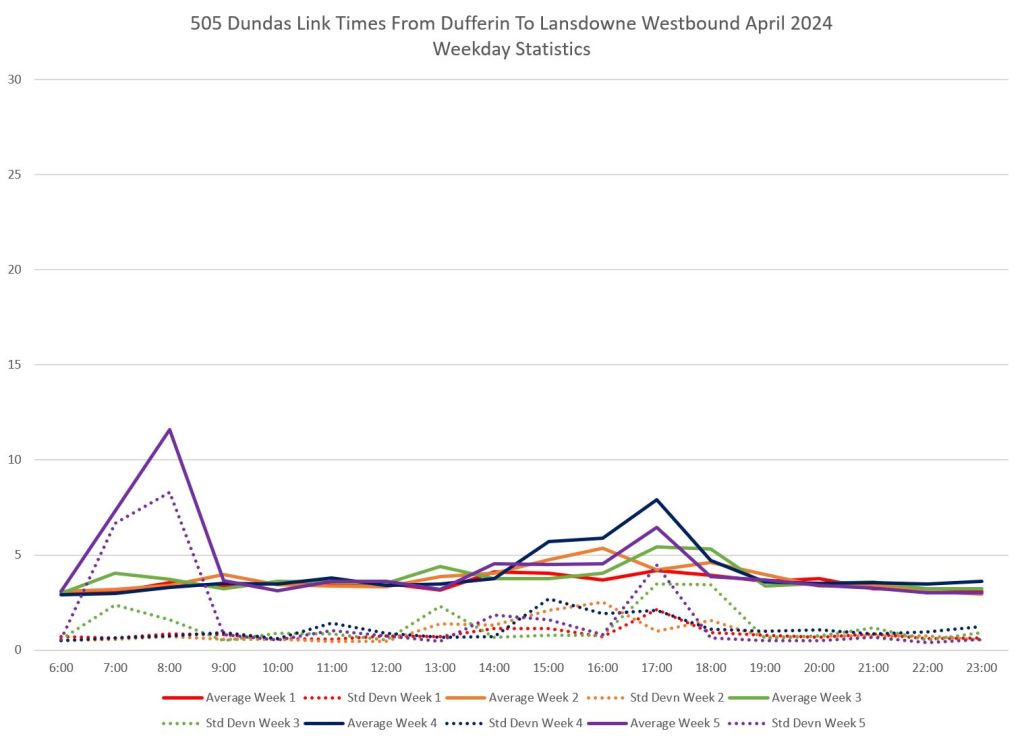
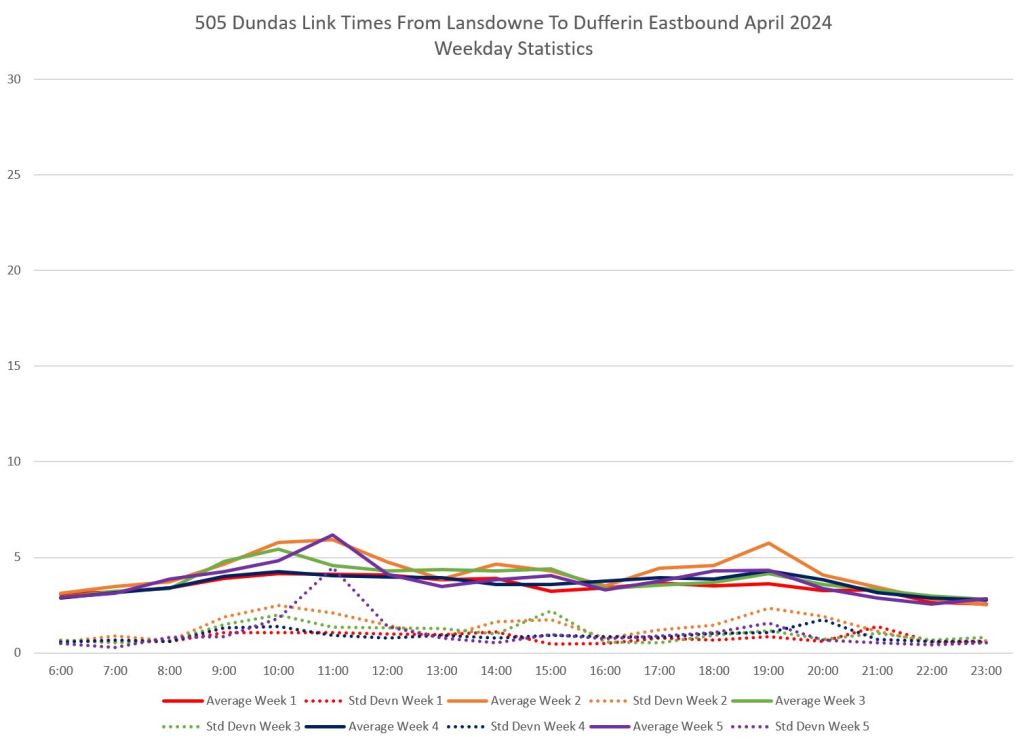
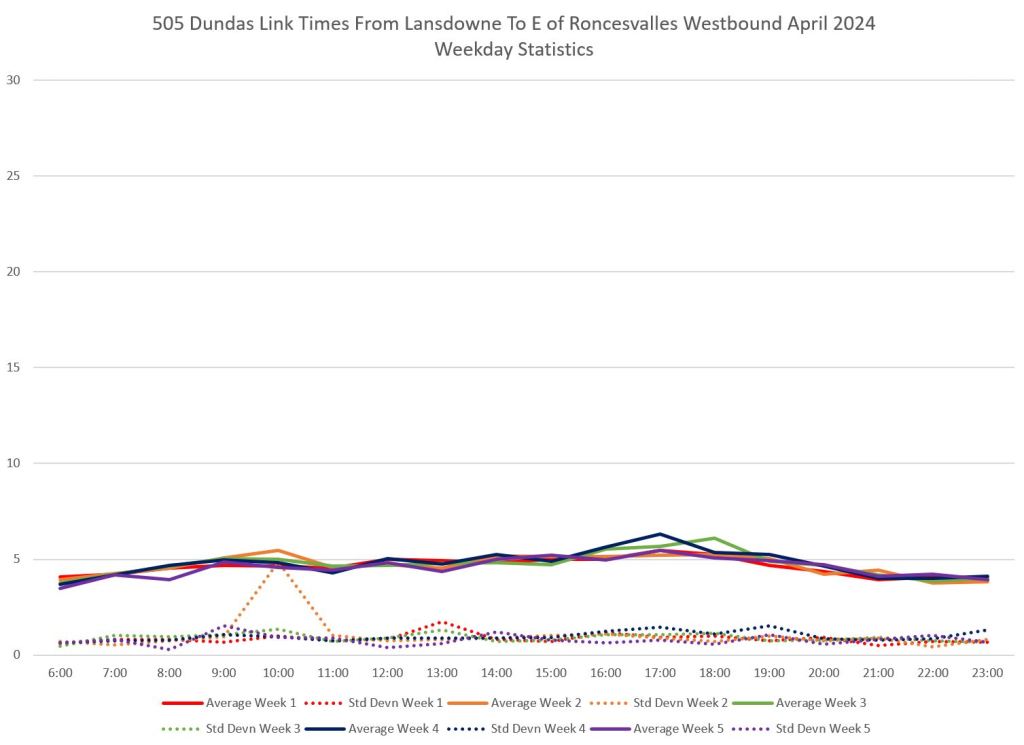
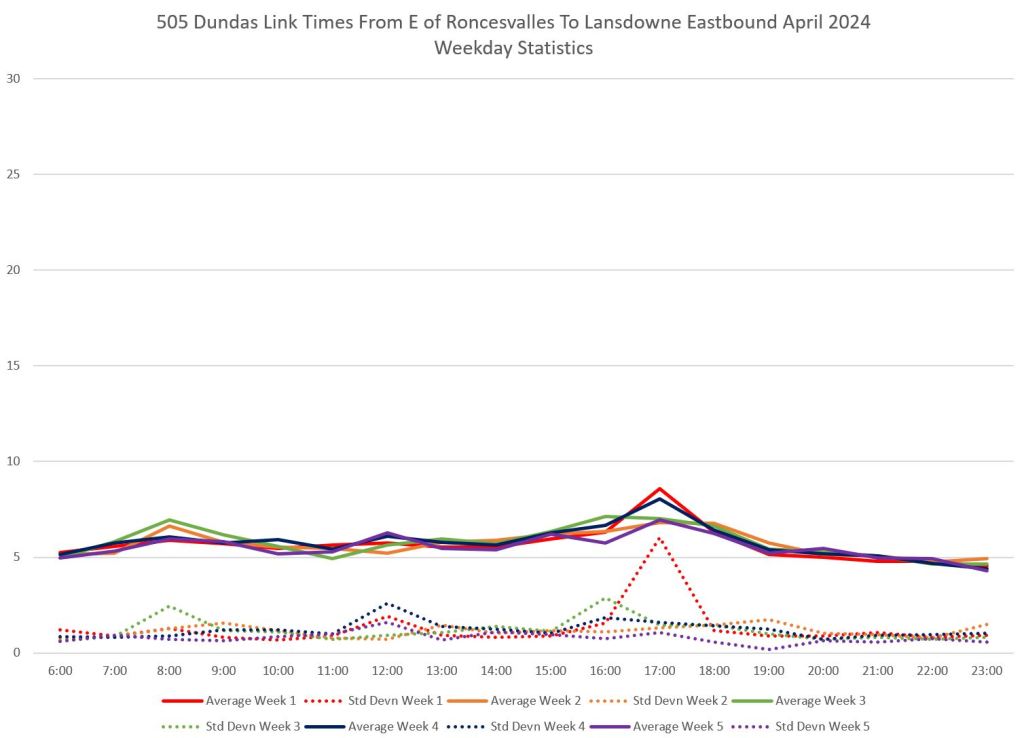
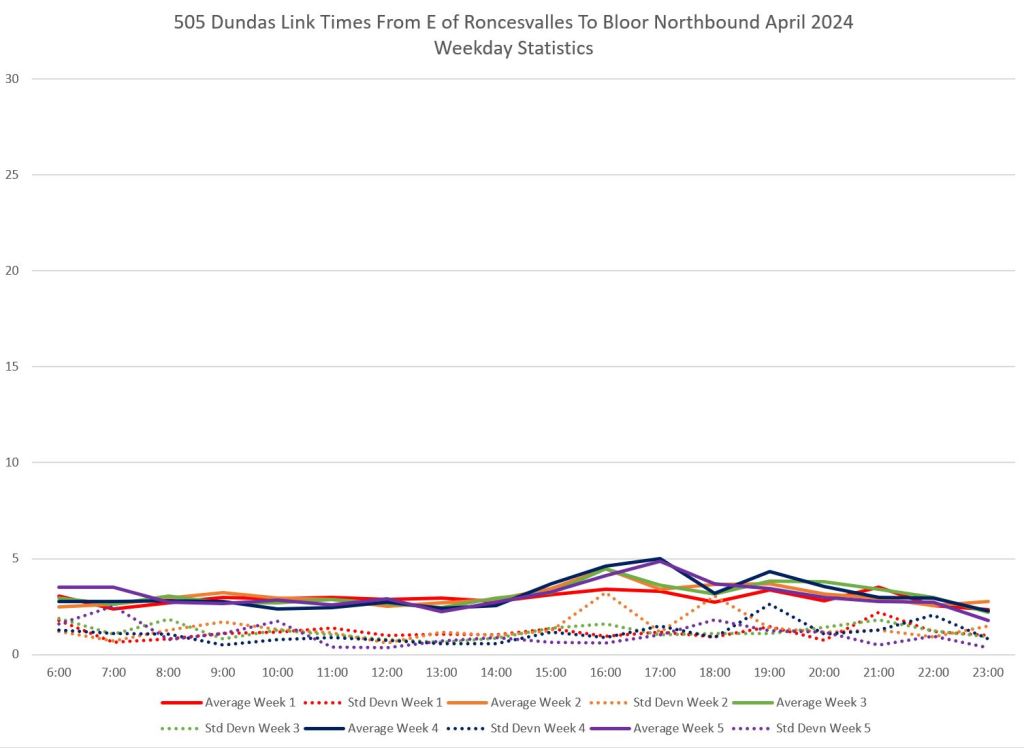
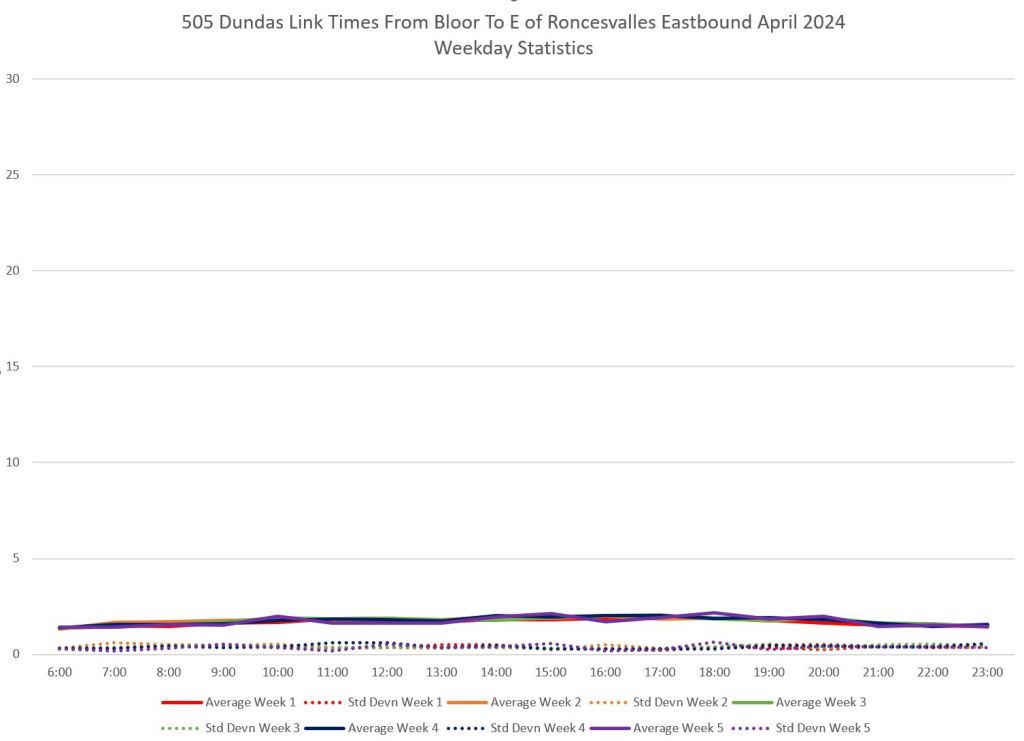
Yonge & Dundas
The charts below show travel times approaching Yonge from both directions: westbound from Church and eastbound from Bay. Note that the screenline is in the middle of Yonge Street, and so these times include dwell time at Yonge serving the stops and waiting for a green signal.
This is a complex intersection. Signals at Yonge have three phases: east-west, north-south and all-walk. No turns are allowed at any time, and pedestrians cross with traffic in the two directional phases.
The eastbound approach from Bay is straightforward with no intervening laneways or streets. However, westbound cars leaving Church Street must slow for the turn at Dundas Square (the old Dundas connection to Yonge) where 505 cars veer north to follow the Dundas Street jog. They immediately encounter a traffic signal at Victoria Street which is as likely to stop them as not.
Victoria Street does not permit through traffic north to Gould, and so most vehicles northbound on Victoria turn left into Dundas. Depending on traffic volumes, the result can be that space opened up by a westbound green signal at Yonge is backfilled from Victoria and streetcars can be delayed waiting to get through.

The curb lane on both approaches to Yonge is often blocked by vehicles making the street effectively a single lane.
In these charts, each dot is one vehicle’s travel time, and the lines are best fit interpolations between them. Although many data points lie in the three-to-four minute range, values of five and greater are common. These are not confined to peak periods, but occur through most of the day reflecting the constantly busy nature of this intersection.
Weekends can be as bad as, and sometimes worse than weekdays depending on events in the downtown area. This was particularly notable on Saturday, April 6 which is examined in more detail later in the article.

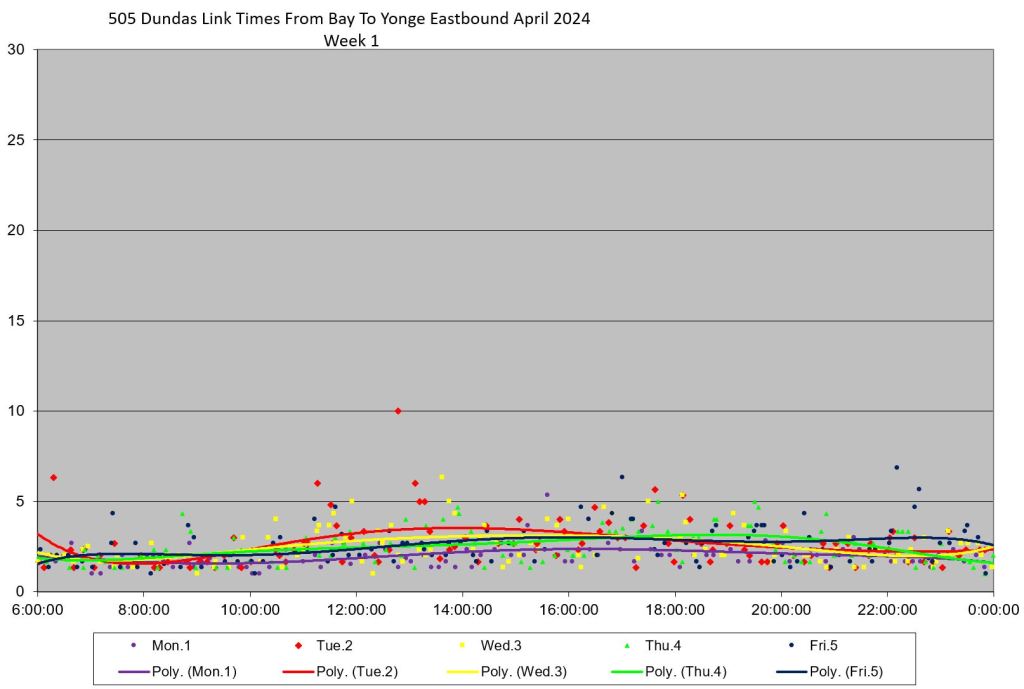
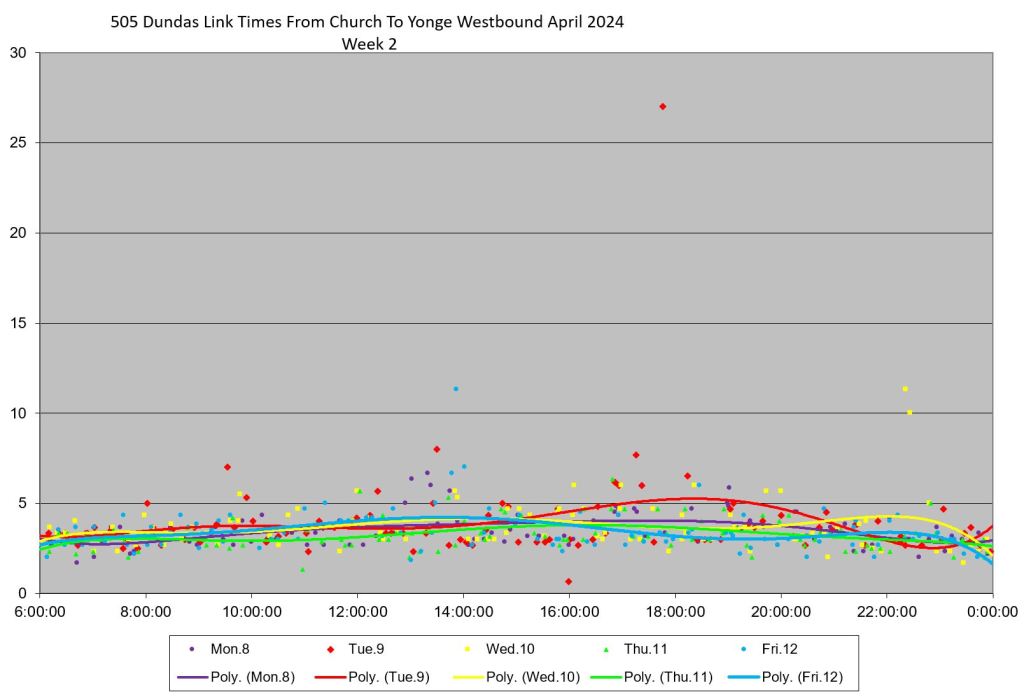
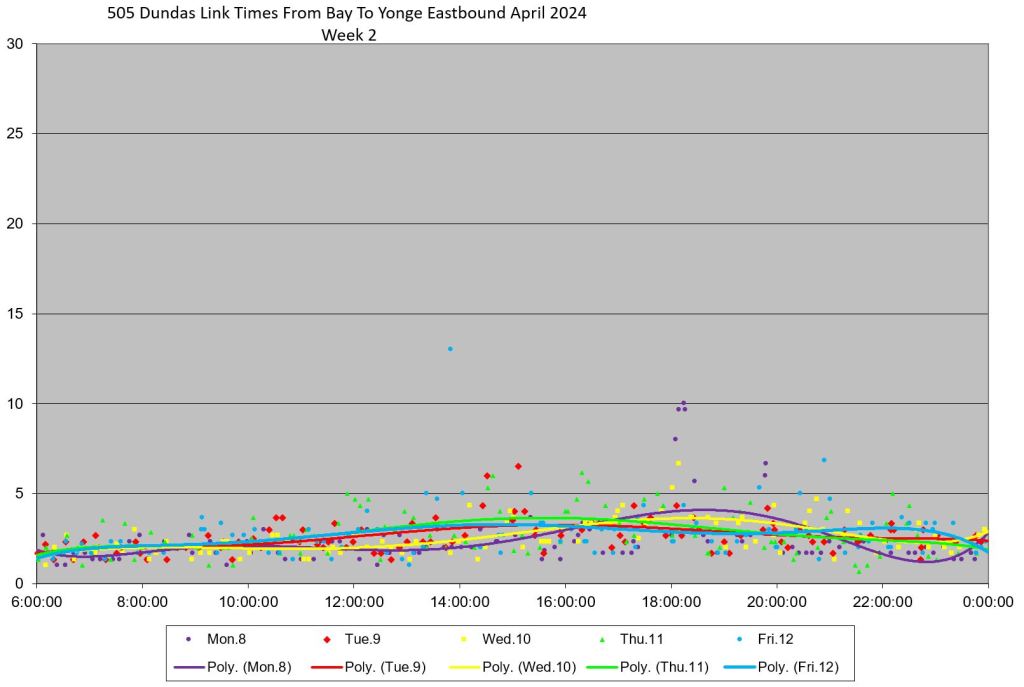
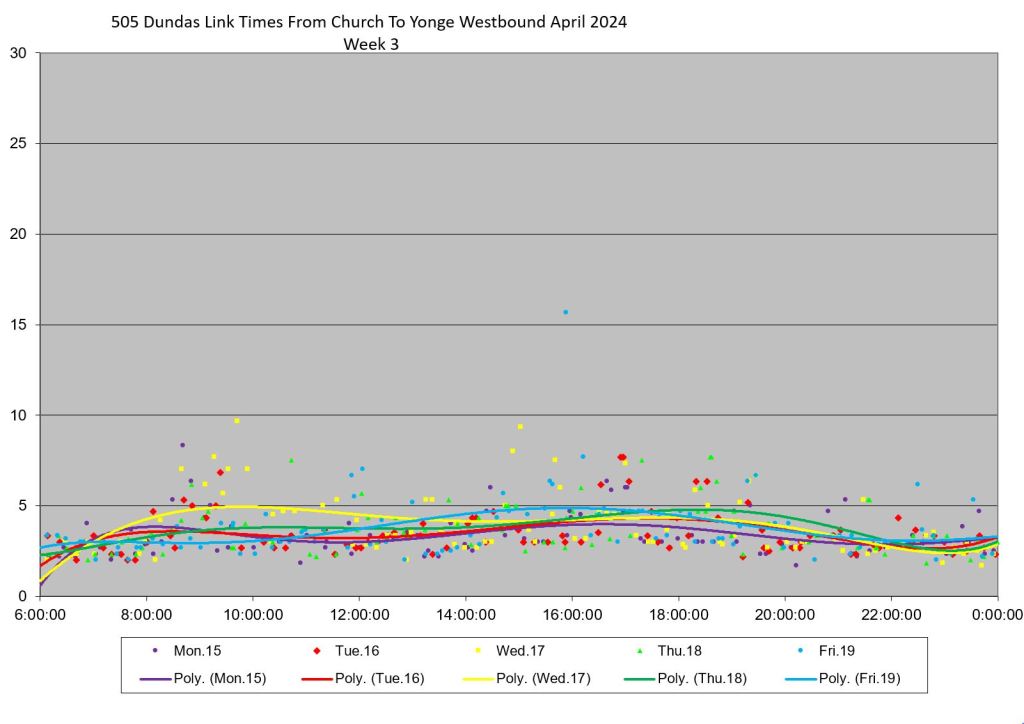

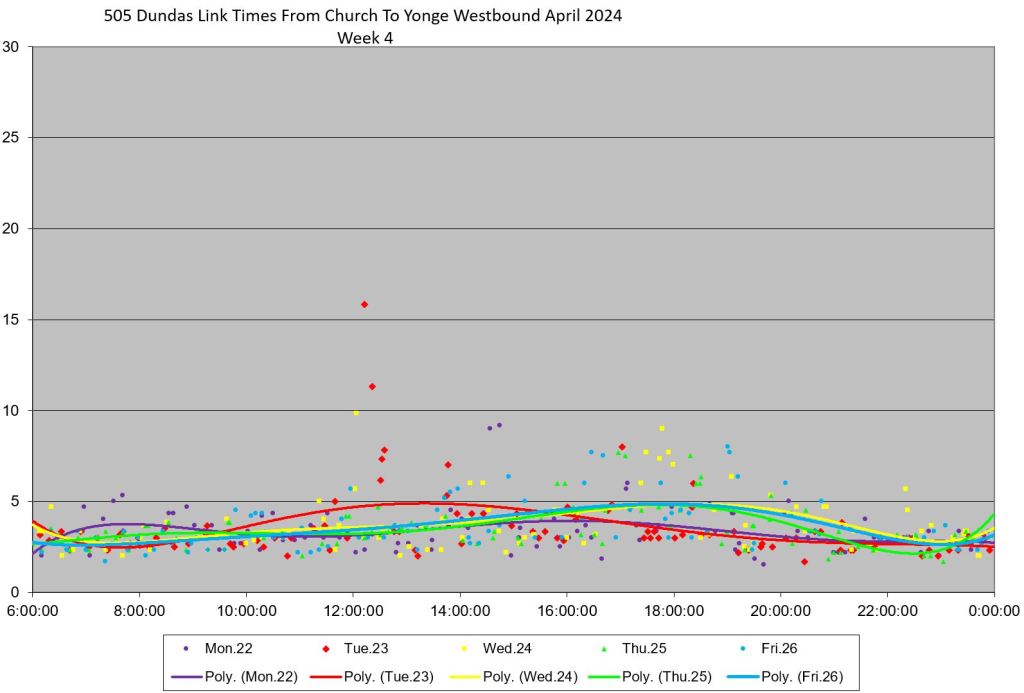
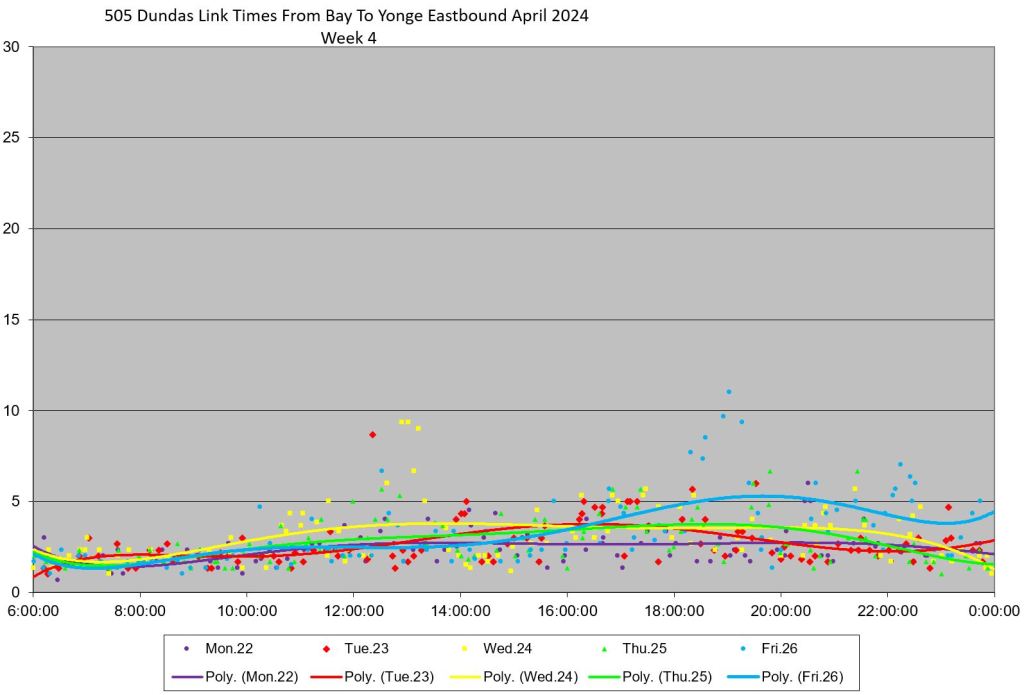
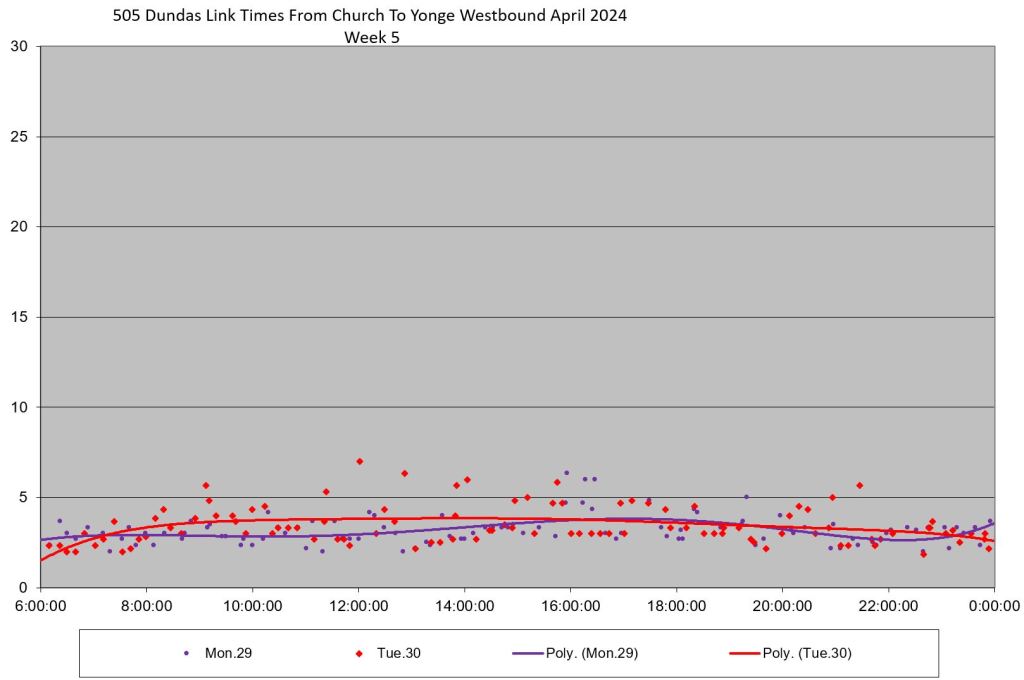
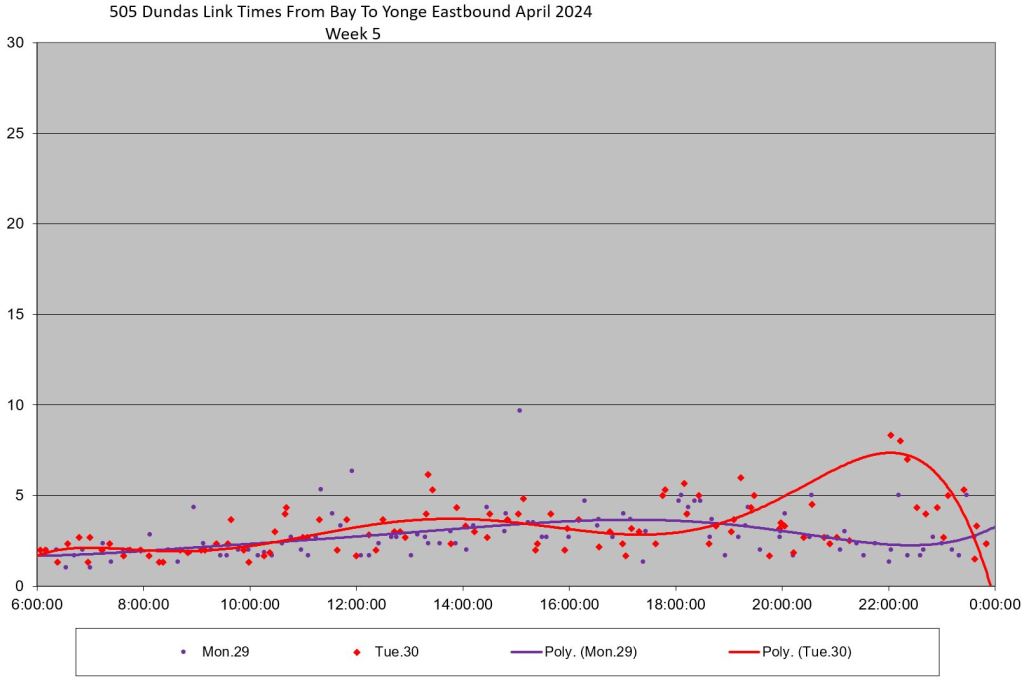
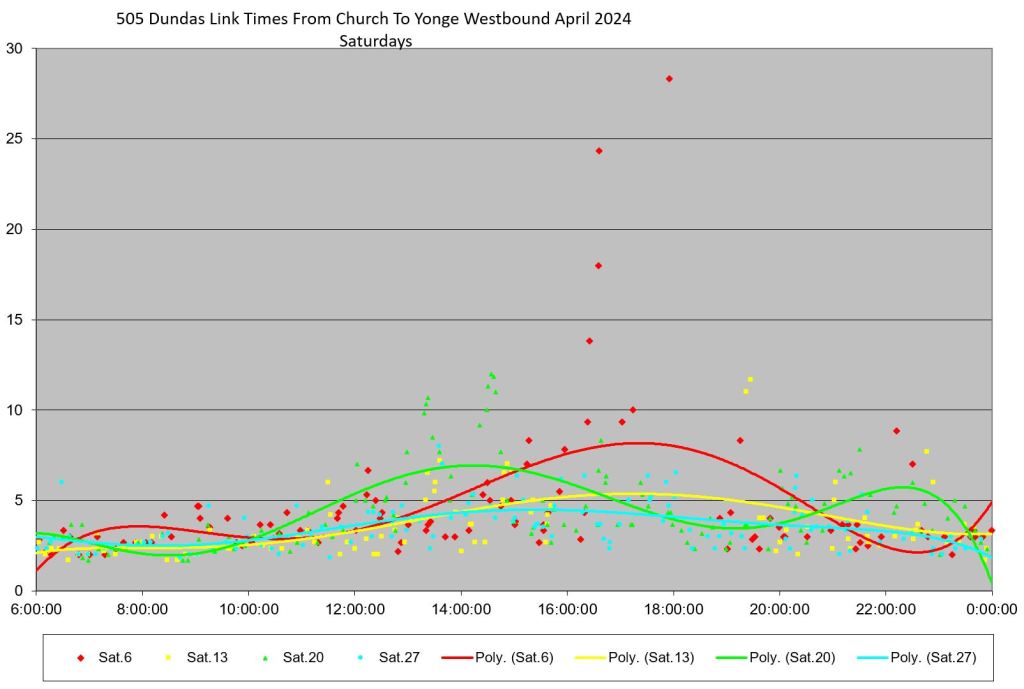
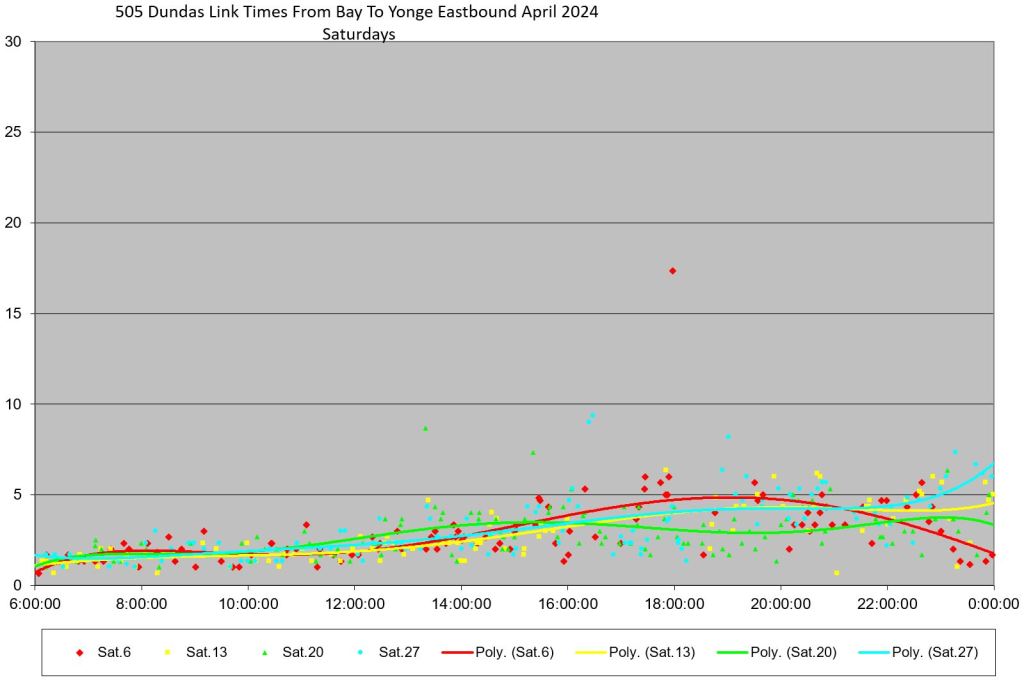
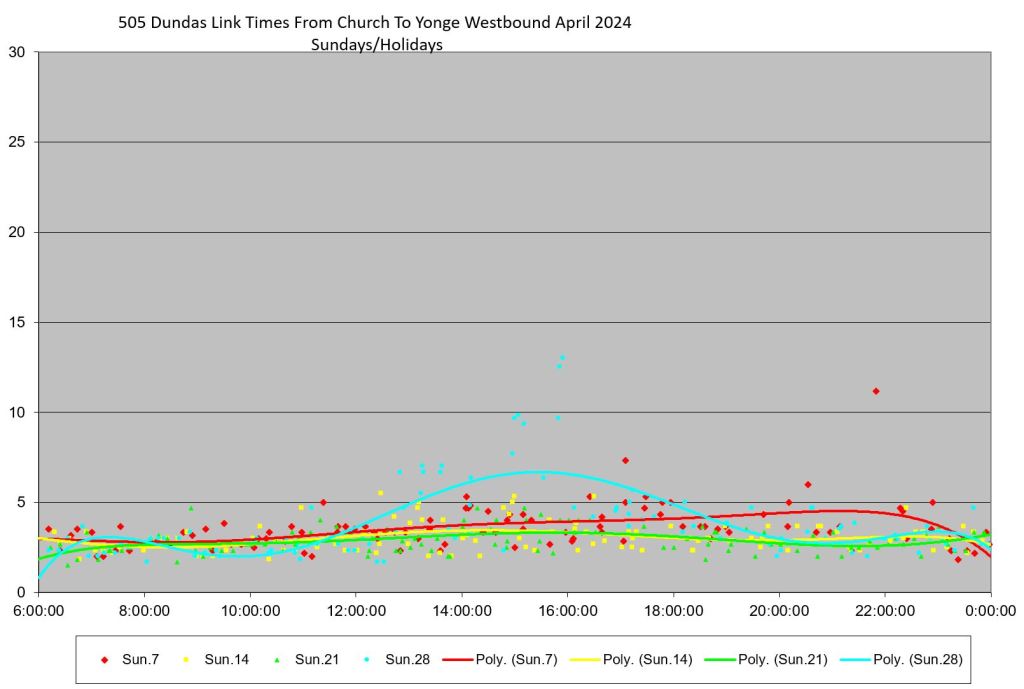
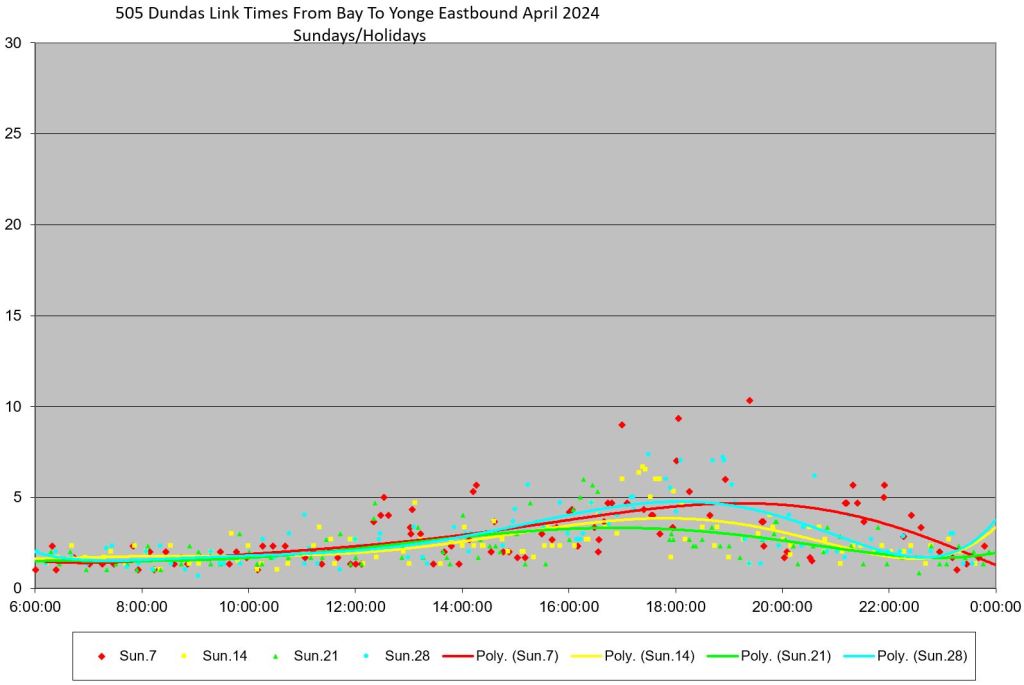
Daily Operational Details
This section reviews operations on Saturday-Sunday April 6-7, Wednesday April 17, Tuesday-to-Thursday April 23-25, and on Saturday April 27. The charts show movements of all streetcars back and forth on the route and illustrate problems with bunching, delays and gaps on many parts of the line. Few of the delays are from stoppages such as blockages or breakdowns, as opposed to slowdowns caused by traffic conditions.
Time runs from left to right over eight charts per day with three hours on each chart. Vehicle speed is shown by the slope of the lines with more horizontal sections reflecting lower speed. Gaps and bunching are shown by spacing between the lines. Westbound trips move upward, and eastbound trips downward.
Delay locations are spread across the route, but the events do not occur at the same time and location on every day. Short turns are used in many cases to regulate service, often successfully, although events can compound to work against these efforts.
As several of the segment charts above showed, week 4 (April 22-26) was particularly bad for Dundas, although there was no single location where a “fix” might have been possible to improve service. Wednesday, April 17 is included here to show service on a day when the route was less stressed for comparison.
Saturday, April 6
Events of note:
- There is a gap, followed by a bunch of three westbound cars at Broadview Station at about 8:30am. Review of data for 504 King shows that there was a backlog of King cars preventing 505 Dundas cars from entering the loop, and the queue extended south of Danforth.
- The trio is spaced out by short turning one car westbound at Lansdowne (pink line, about 9:30am) and another on the return trip eastbound at Parliament.
- As the day goes on, bundles of cars form, notably a quartet of cars leasing Dundas West just after 1pm which was joined by a car entering service to make a quintet travelling across the city.
- Short turns of some of these and other cars was an ongoing response to congestion, although it was an uphill battle to maintain service.
- Two major service interruptions between 4 and 7pm required diversions. Four cars were held westbound at Bay between 4:30 and 5pm. Most cars diverted via Church or Bay, College/Carlton and Bathurst between 6 and 7pm.
- Through the evening, various short turns were used to sort out the service, but problems continued including congestion eastbound from University to Yonge between 10 and 11pm.
- Queuing on the approach to Broadview Station is evident just after 11pm causing a gap and bunch of cars westbound. As with the delay at 8:30am, this was caused by multiple 504 King cars backlogged onto Broadview from the loop which can only hold one King car at a time.
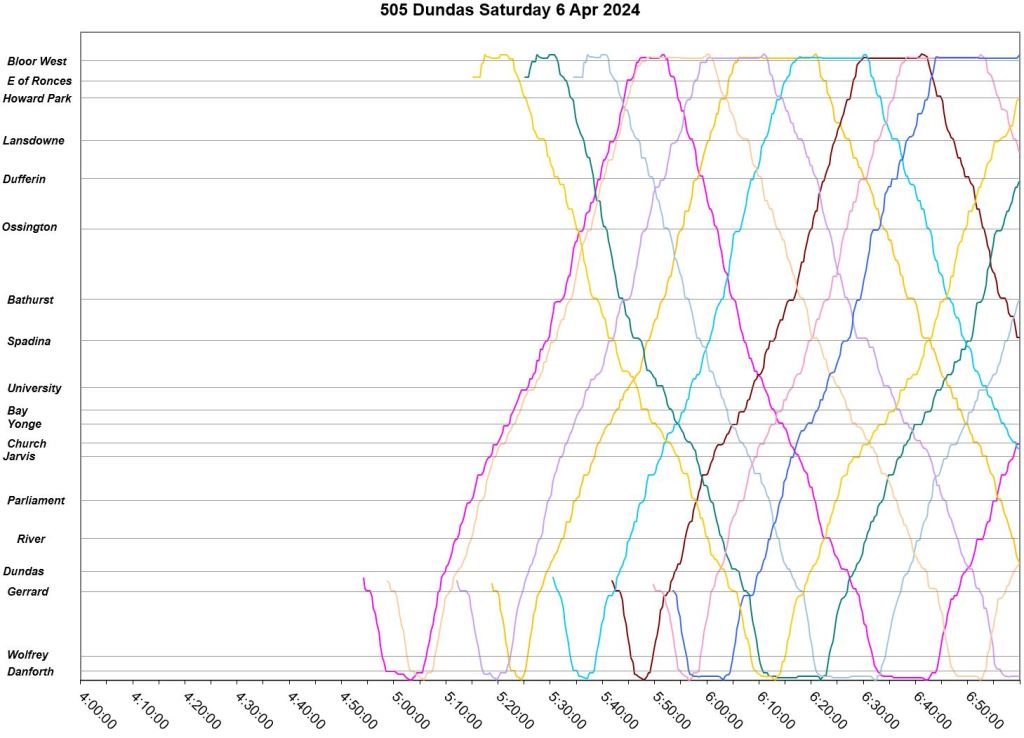
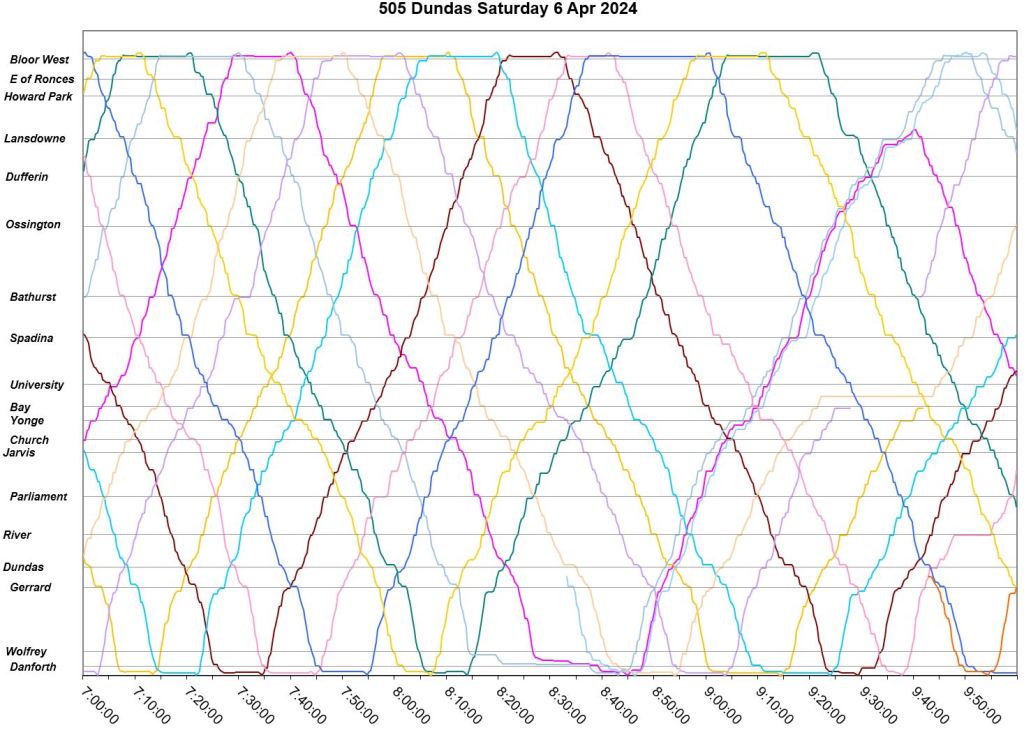
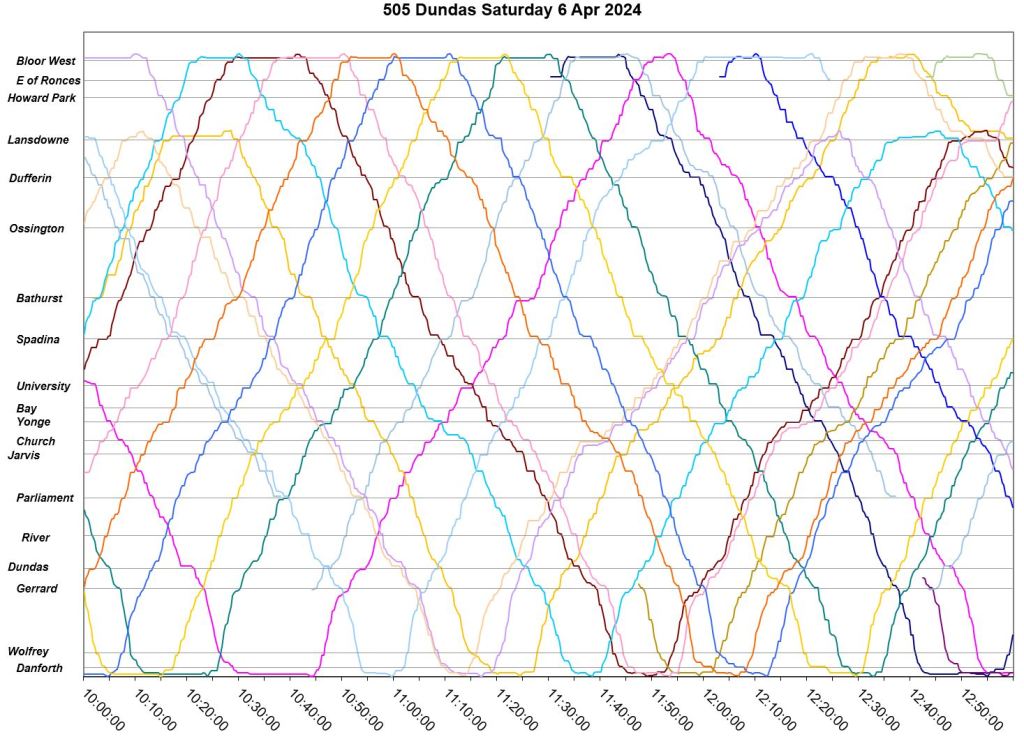
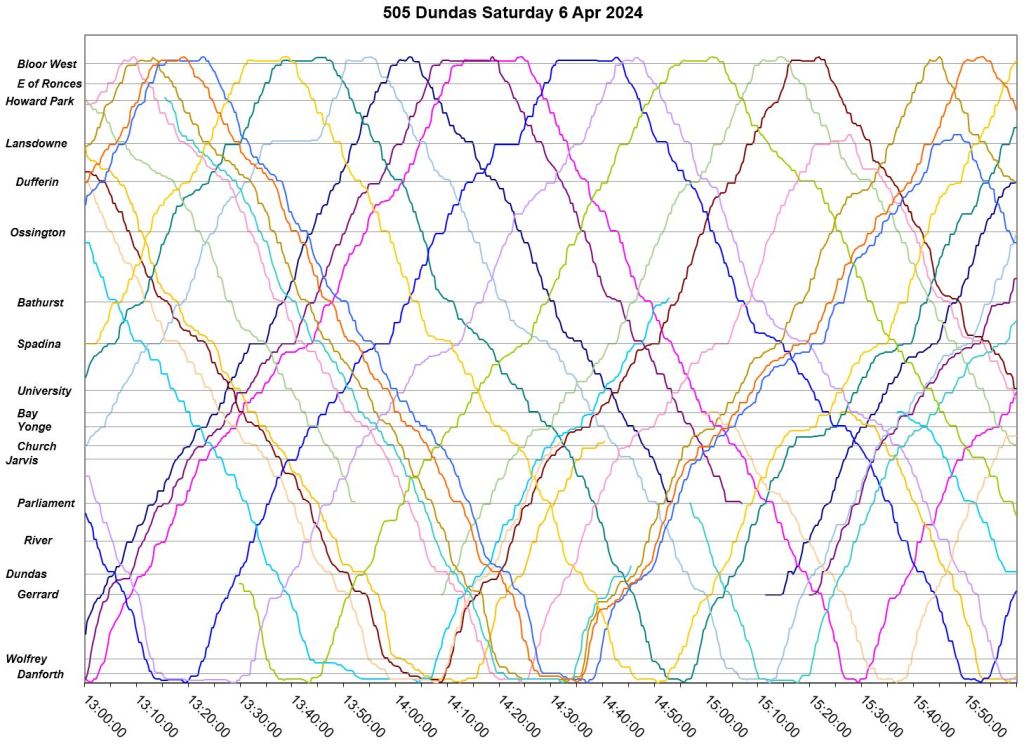

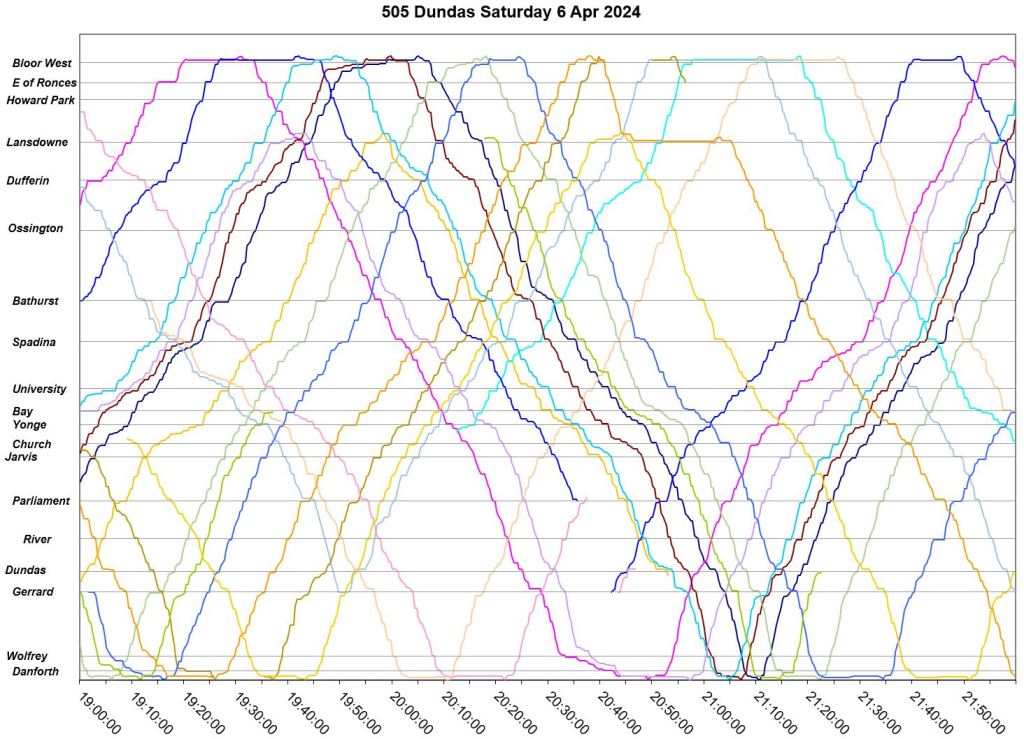
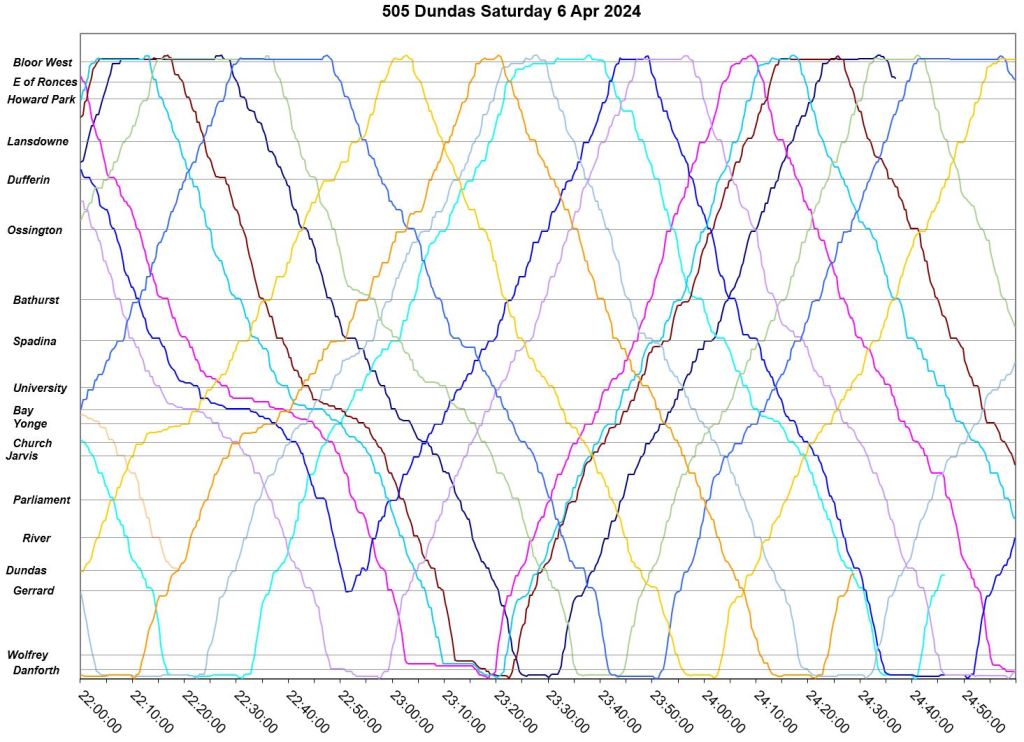
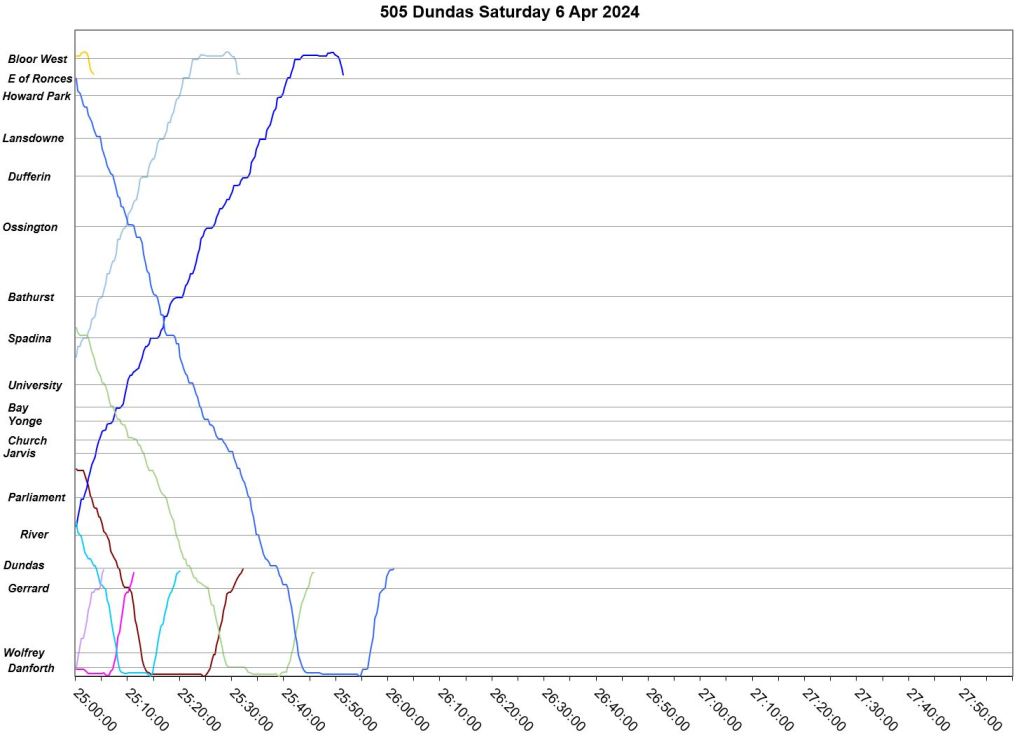
Sunday, April 7
Sunday April 7 was similar to the preceding day in many ways.
- Service is fairly reliable with little bunching until about 10am.
- After 10am, some cars operate in pairs, but these are usually spaced out at terminals for the return trip.
- In the early afternoon, several short turns at Lansdowne are used to break up bunches, but this ends at about 3pm after which there are almost no short turns and bunches remain intact.
- After 7pm, two events produce major disruptions and diversions. They are described in eAlerts as a disruptive customer at Denison Avenue, and a mechanical problem at Shaw Street. These clear by about 8:45 but the effects continue through to the end of service in spite of some short-turning to restore order.
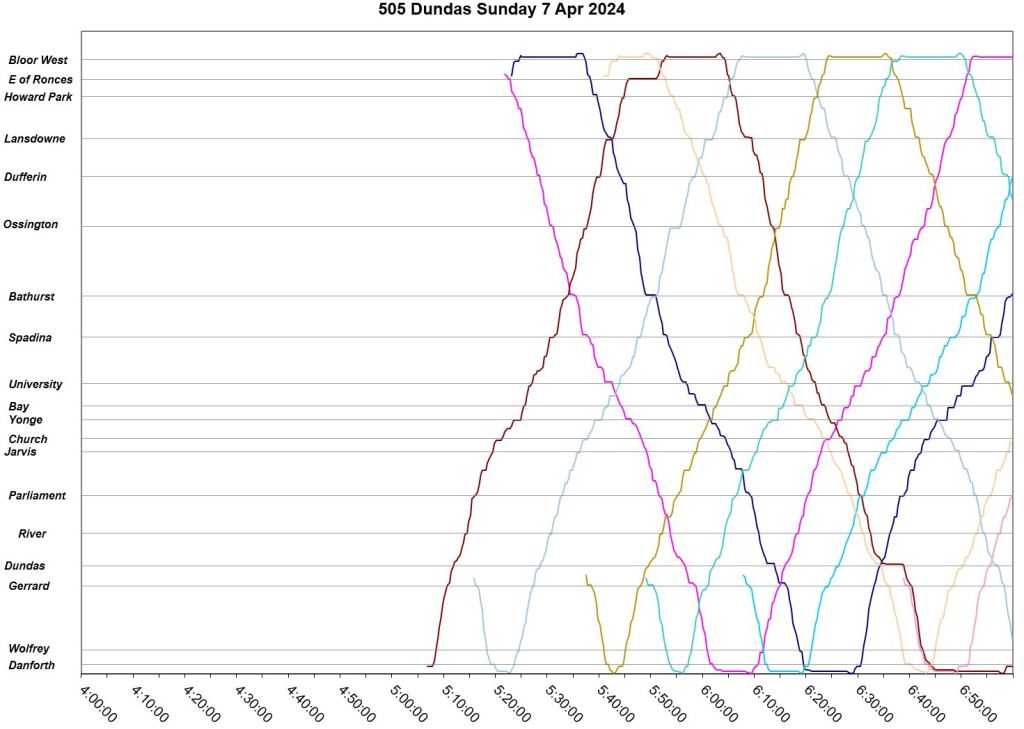
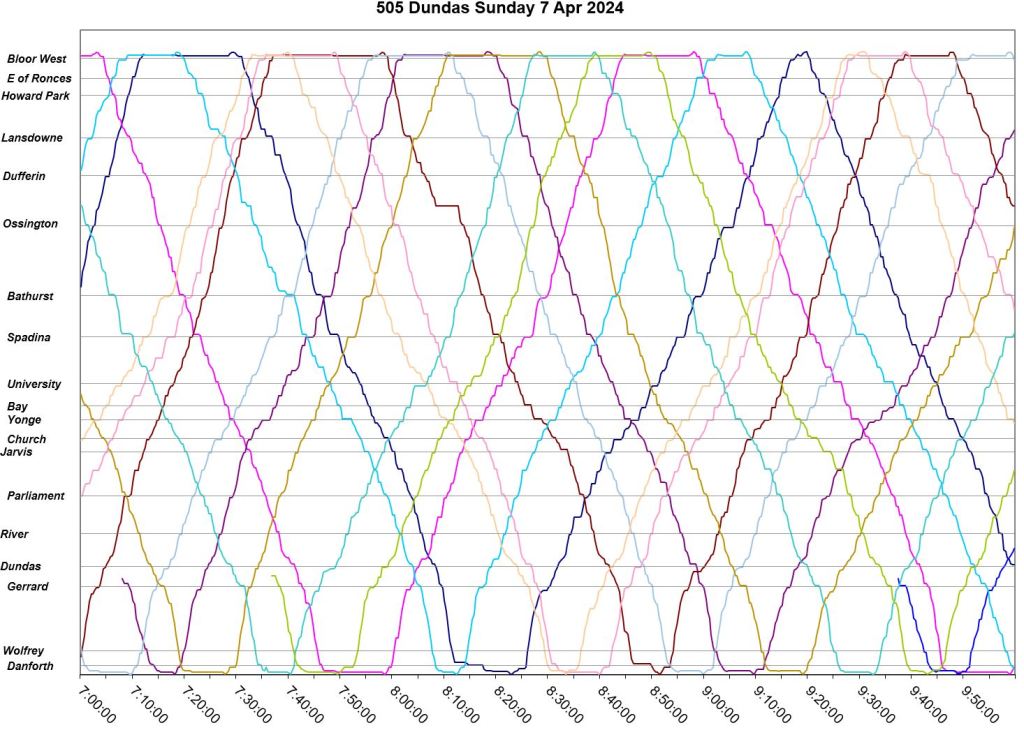
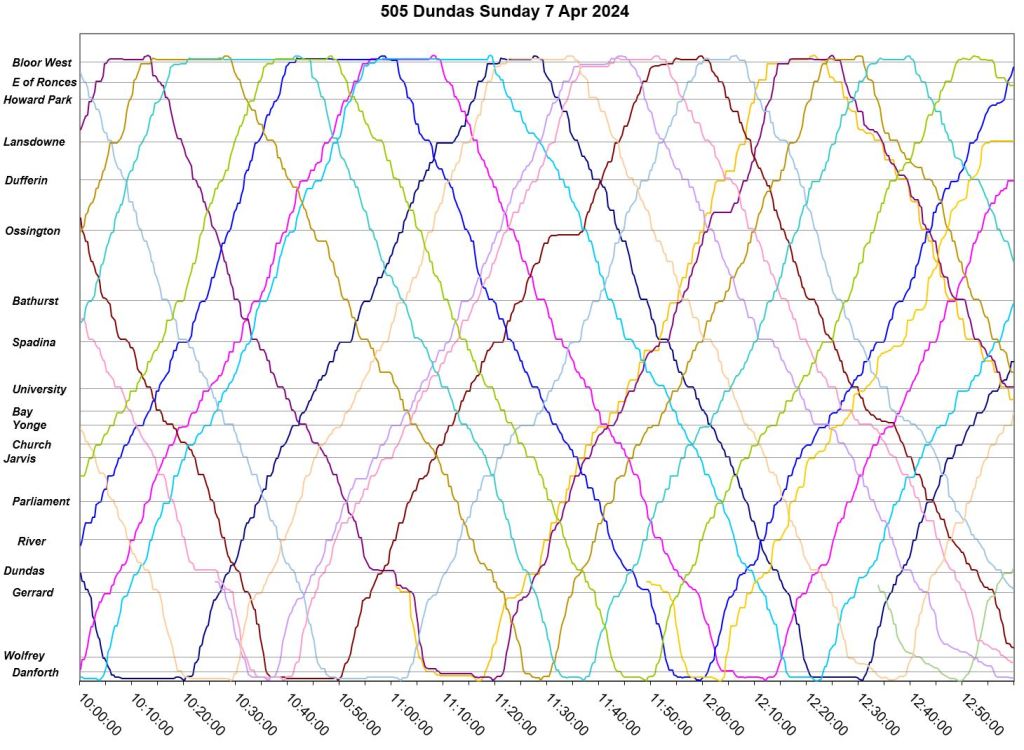
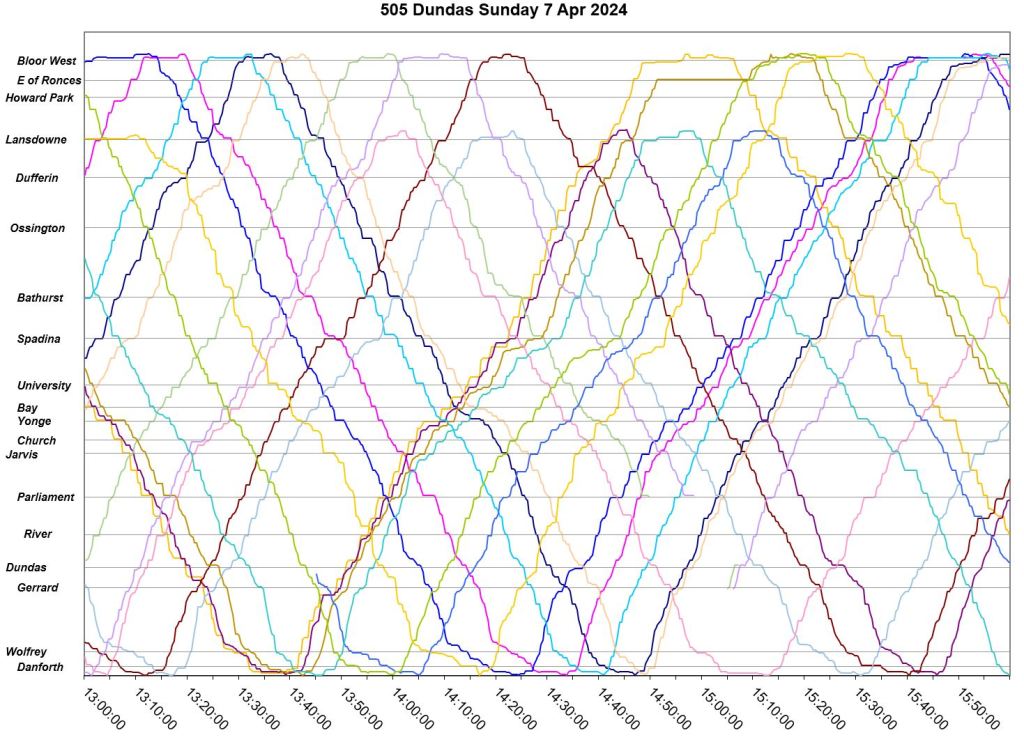
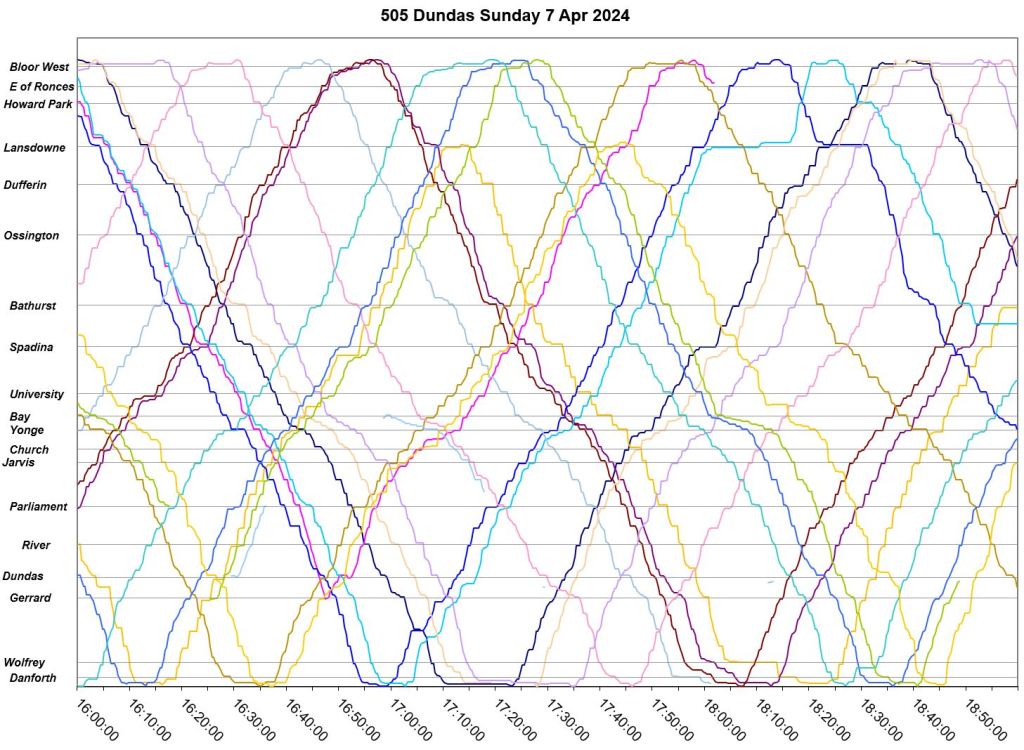
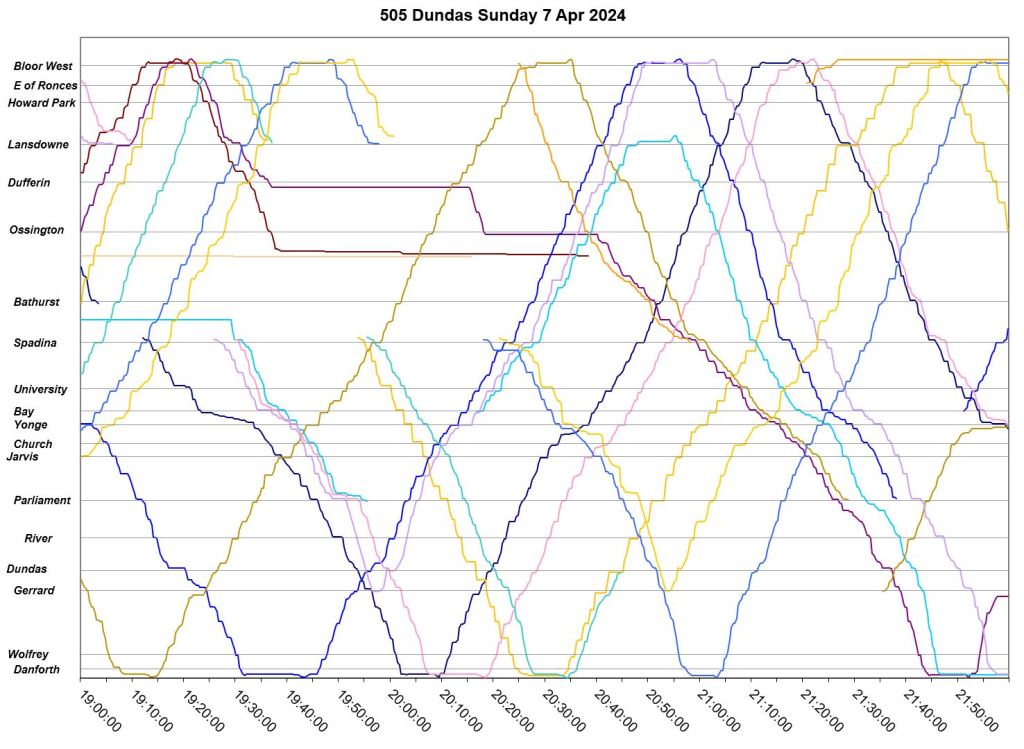

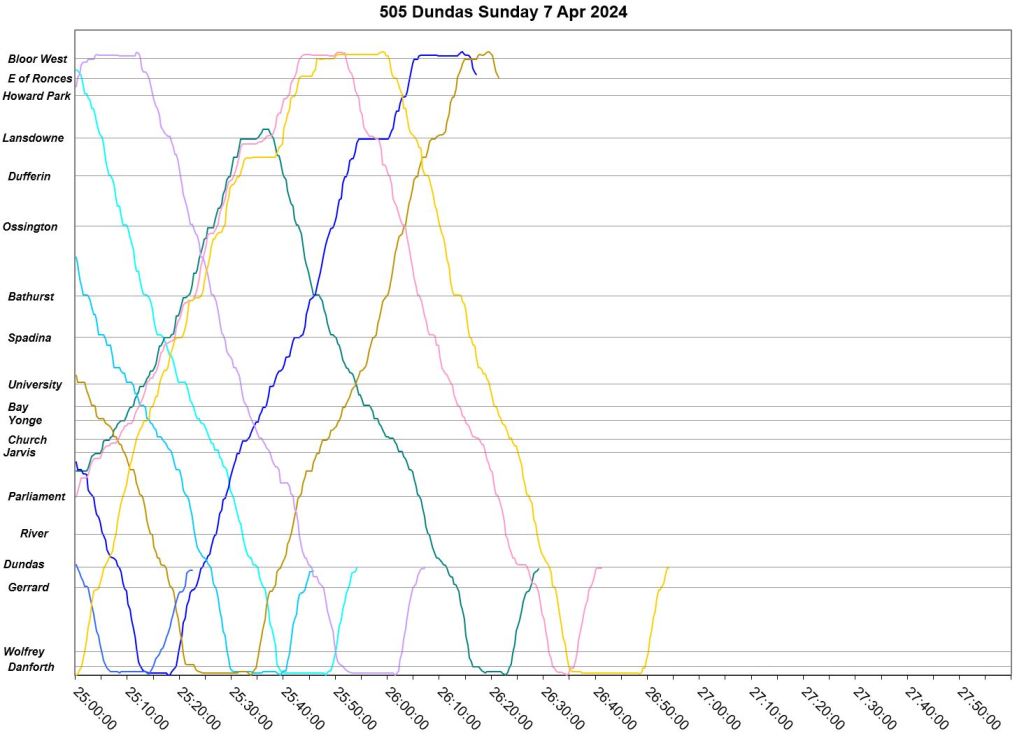
Wednesday, April 17
This day is included as an example of fairly well-behaved operation, and by contrast to the following week which was much different. Events of note:
- A collision west of Lansdowne blocked service to Dundas West Station between 7-8am.
- Congestion near Yonge both ways is evident during many periods, but it is not severe.
- Congestion westbound to Spadina occurs primarily in the early evening.
- At about 11:45pm, a car is held eastbound near Broadview for “police activity”.
- Overall there are few short turns, and most trips have terminals layovers.
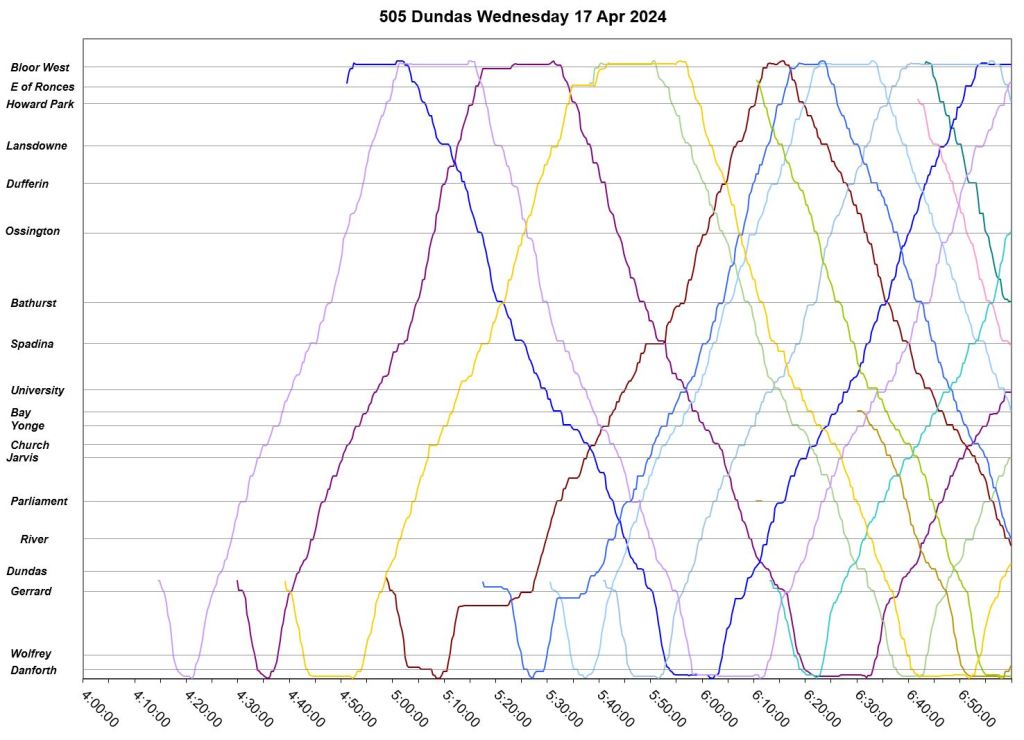
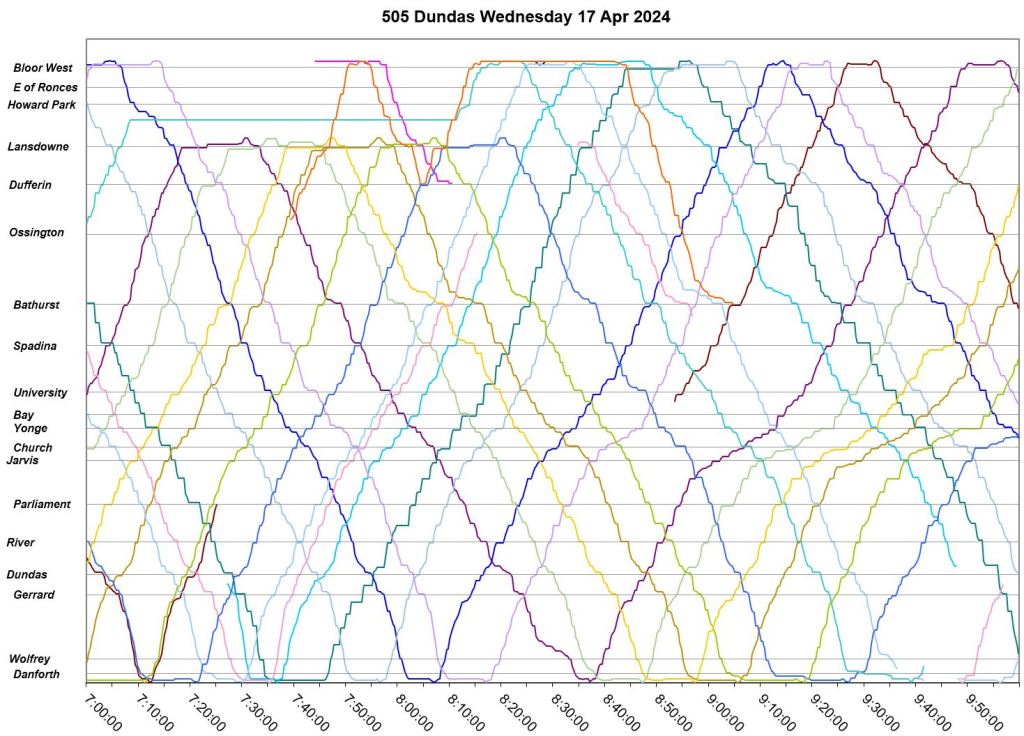
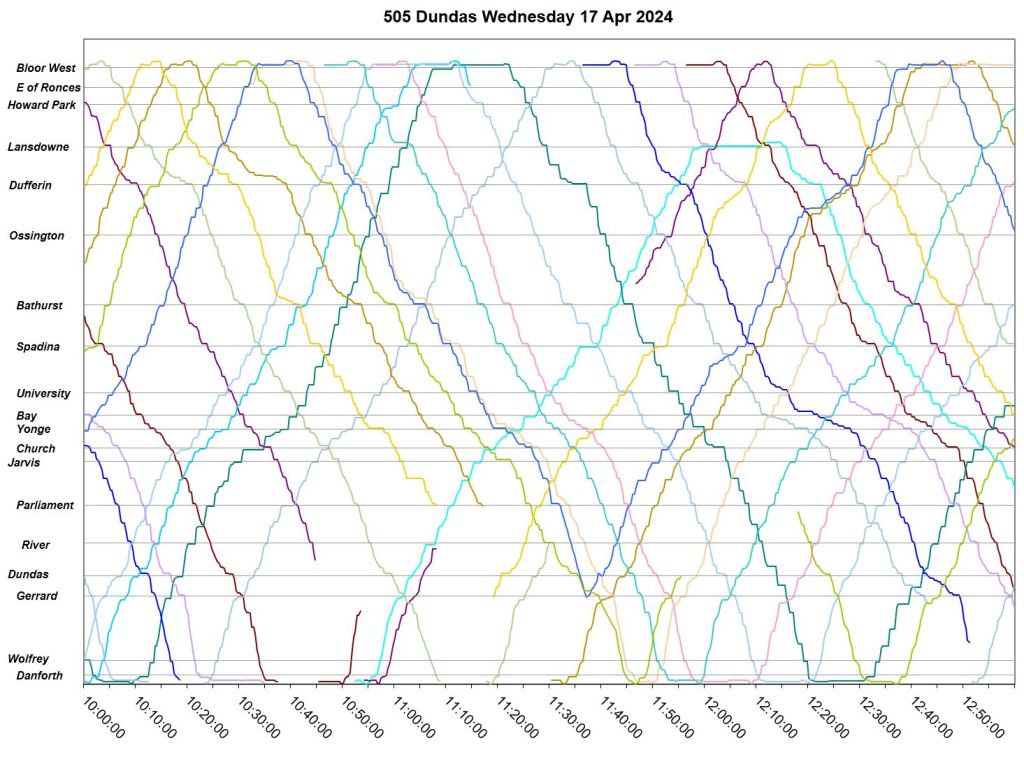
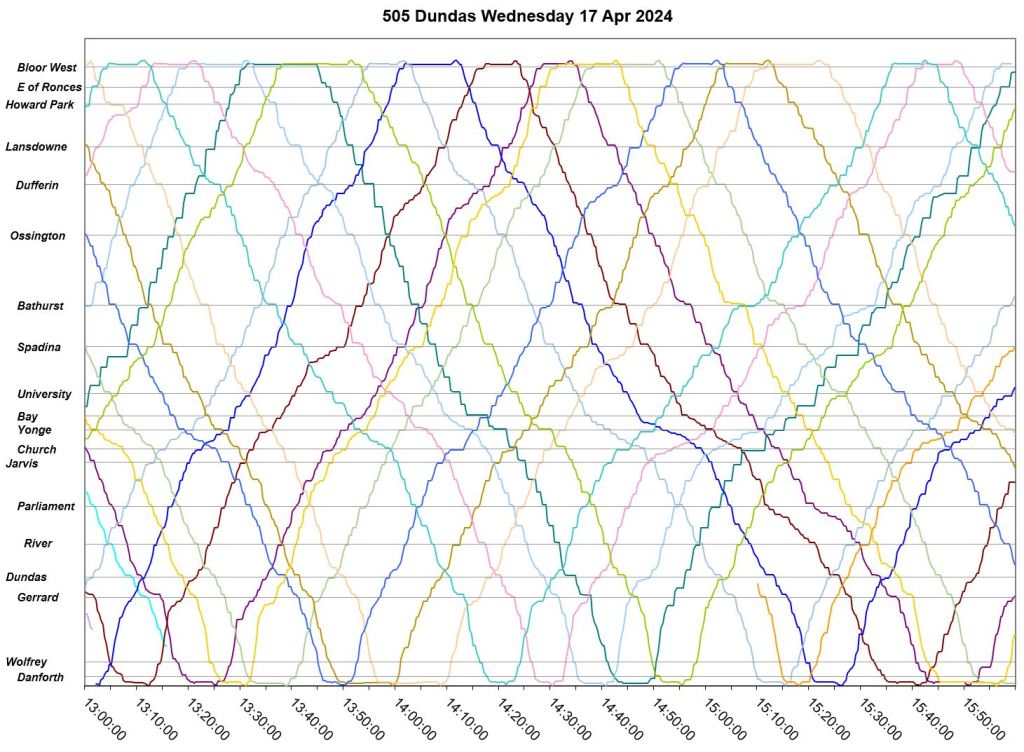
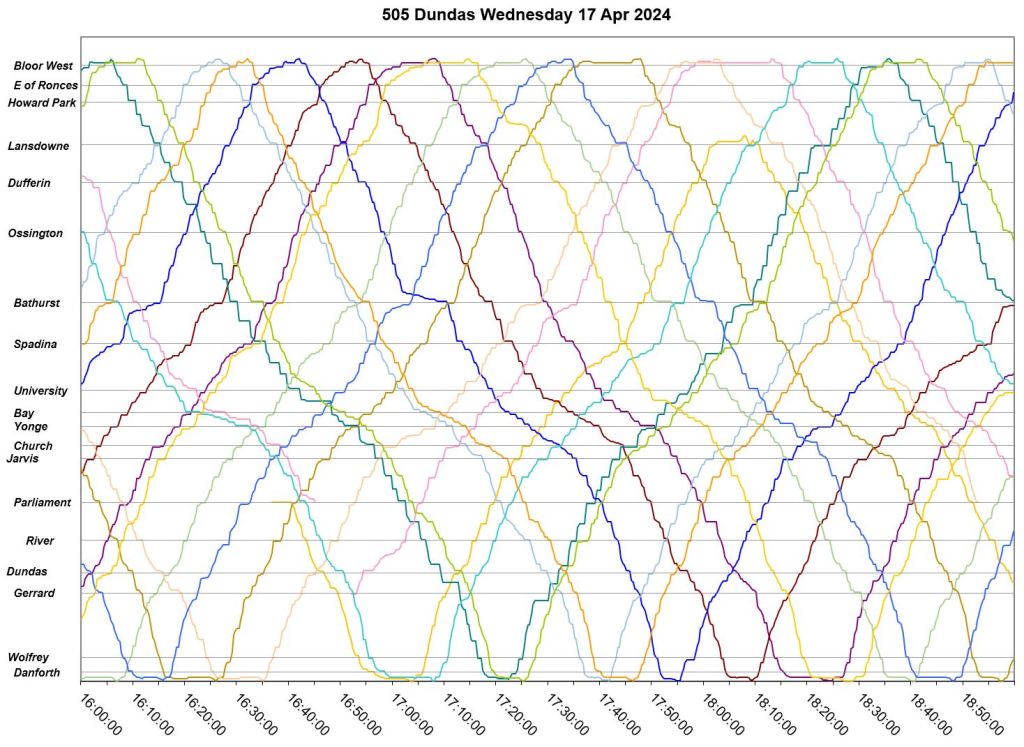
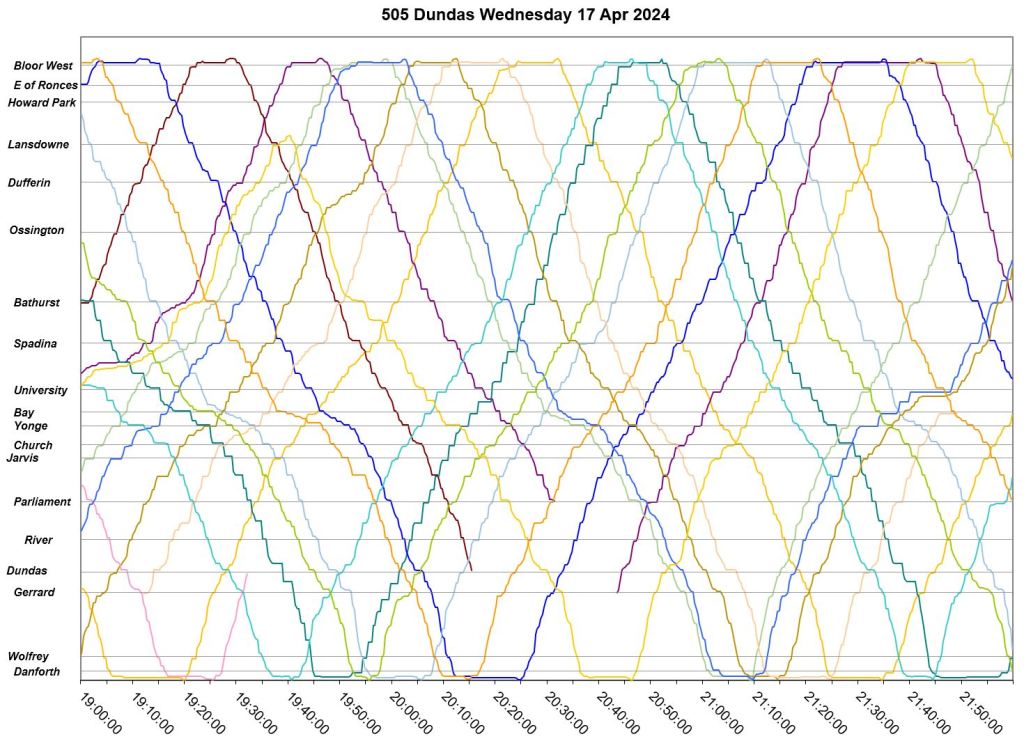

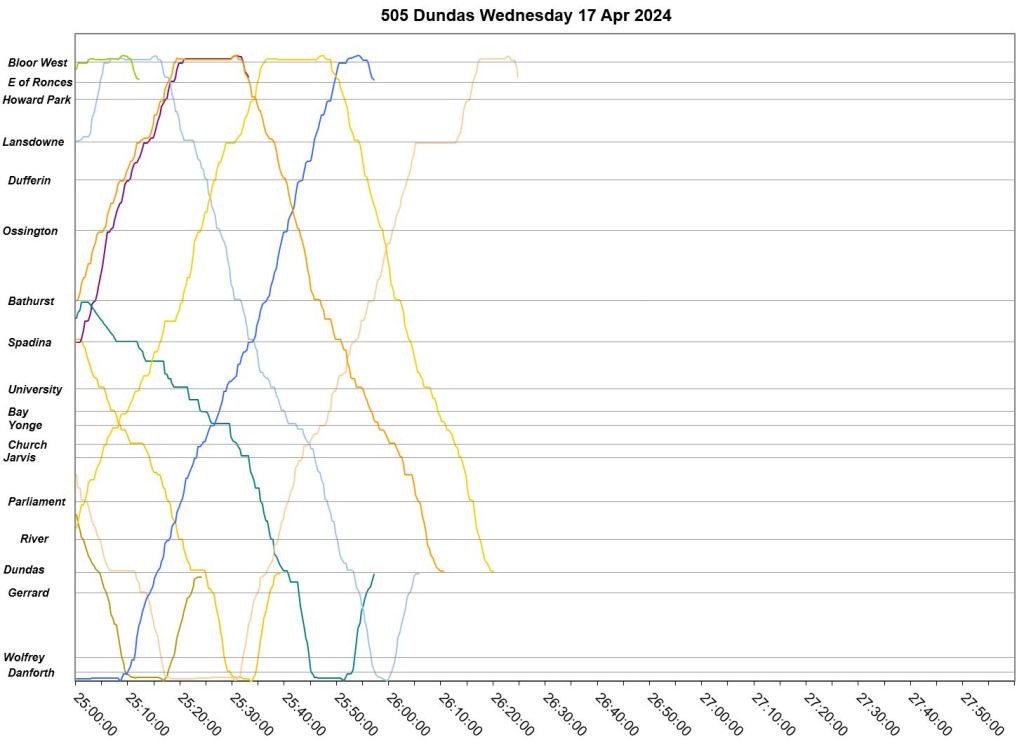
Tuesday, April 23
Events of note:
- There is some congestion eastbound at Bathurst at the end of the AM peak, but this does not occur (or to the same degree) on Wednesday and Thursday (see below).
- A cluster of three cars leaves Broadview Station at 10:50am. One leaves the route at Parliament, and the remaining pair is help briefly at Bay. One of those cars short turns at Lansdowne.
- At 12:30 service holds westbound at Yonge due to a mechanical problem (according to the eAlert). The problem car is eventually moved onto Bay Street and the remaining cars continue west.
- Through the rest of the day gaps and bunches form and break up, sometimes with short turns, and this continues to the end of service. Several of the bunches originate at terminals. They are caused indirectly by congestion enroute on the previous trip.
- There is a small period of congestion westbound to Spadina in the PM peak.
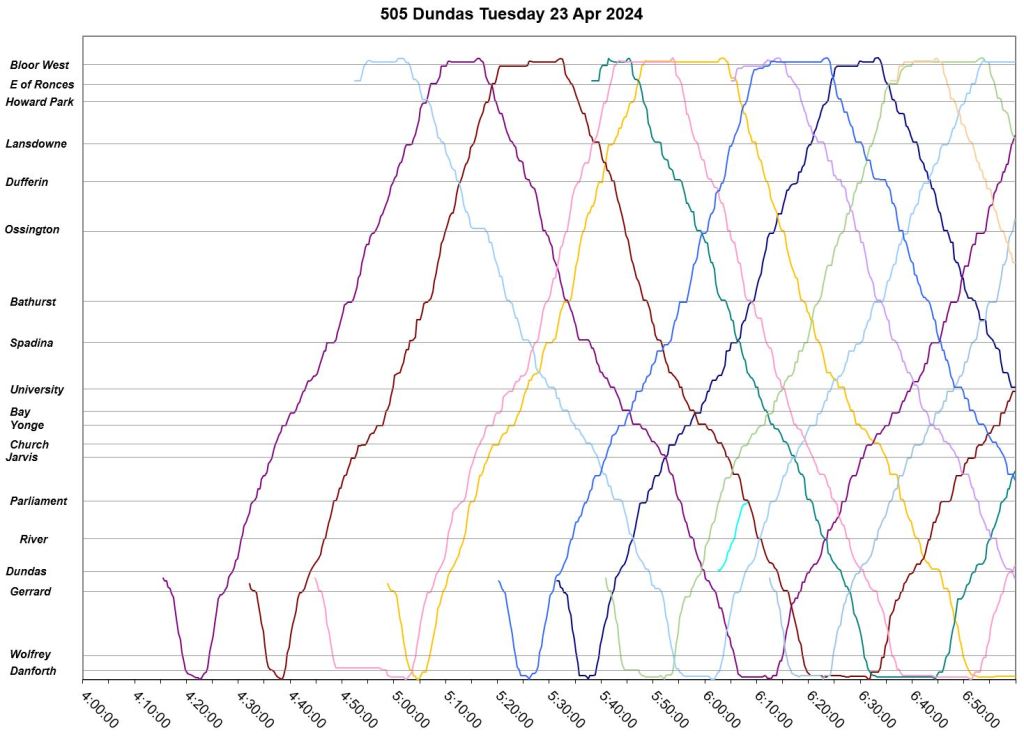
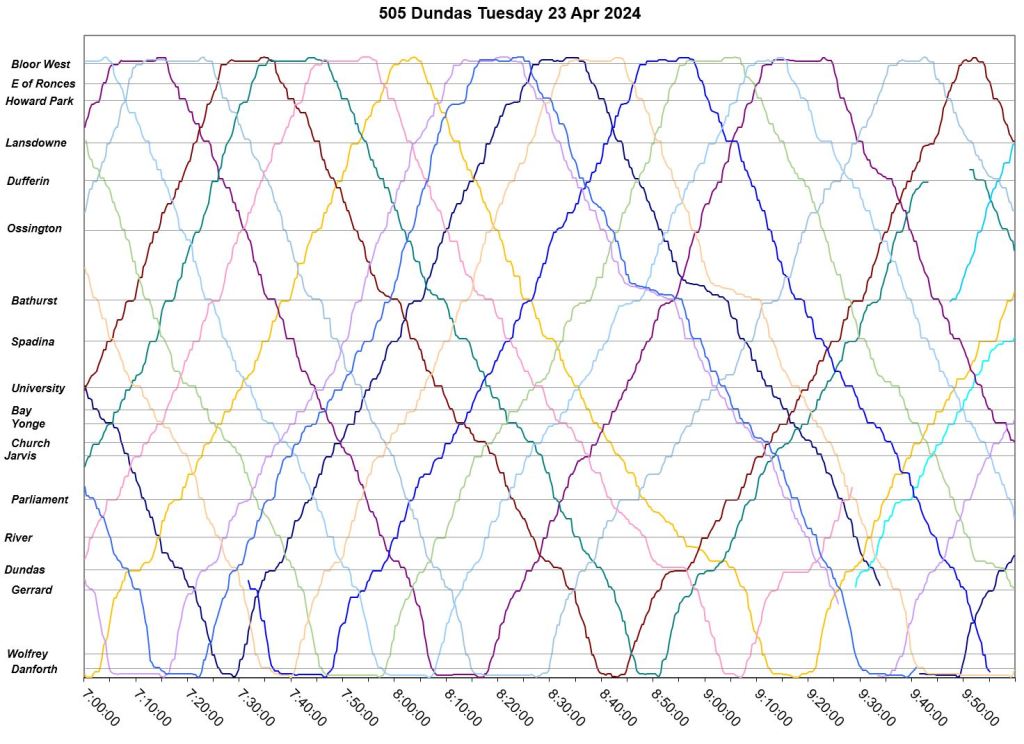
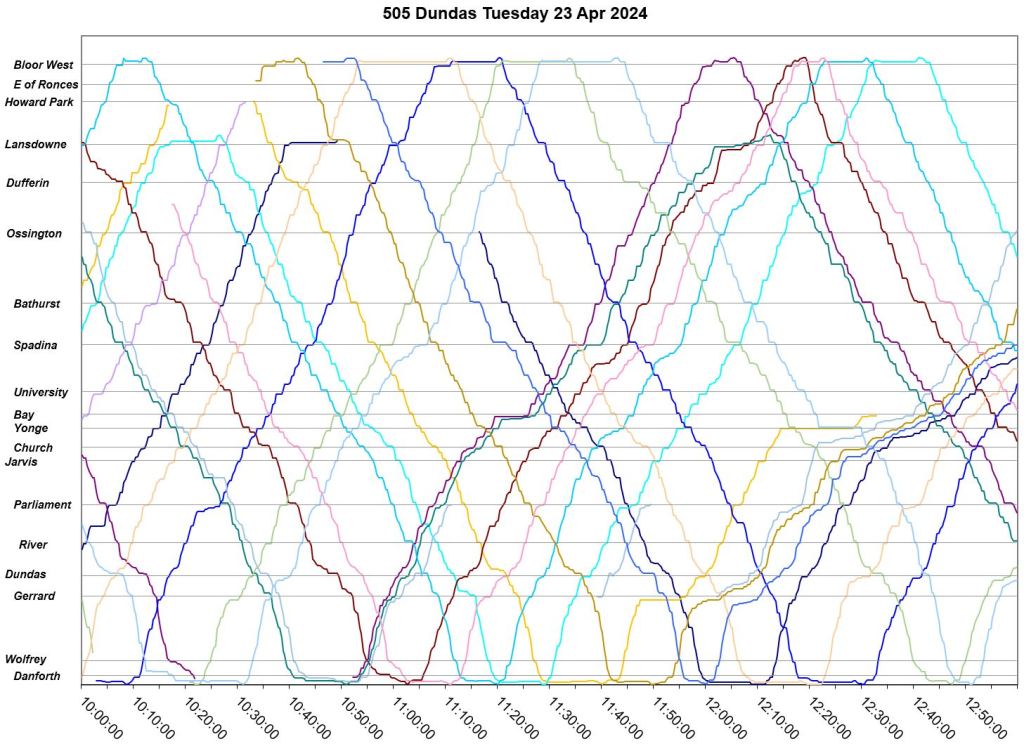
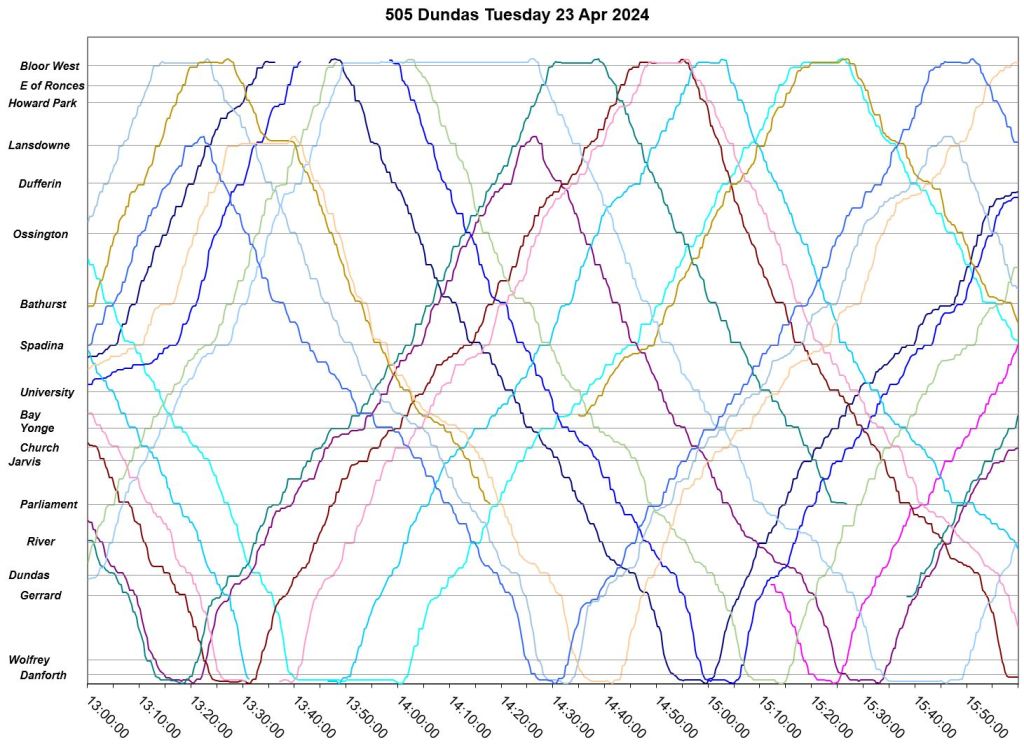
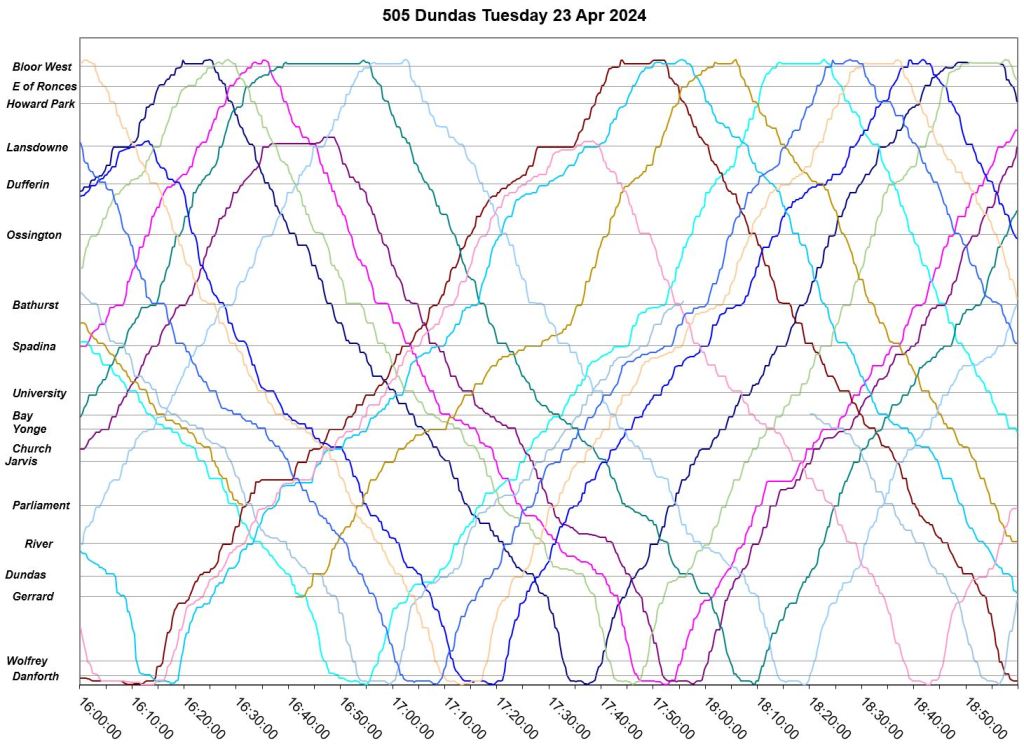
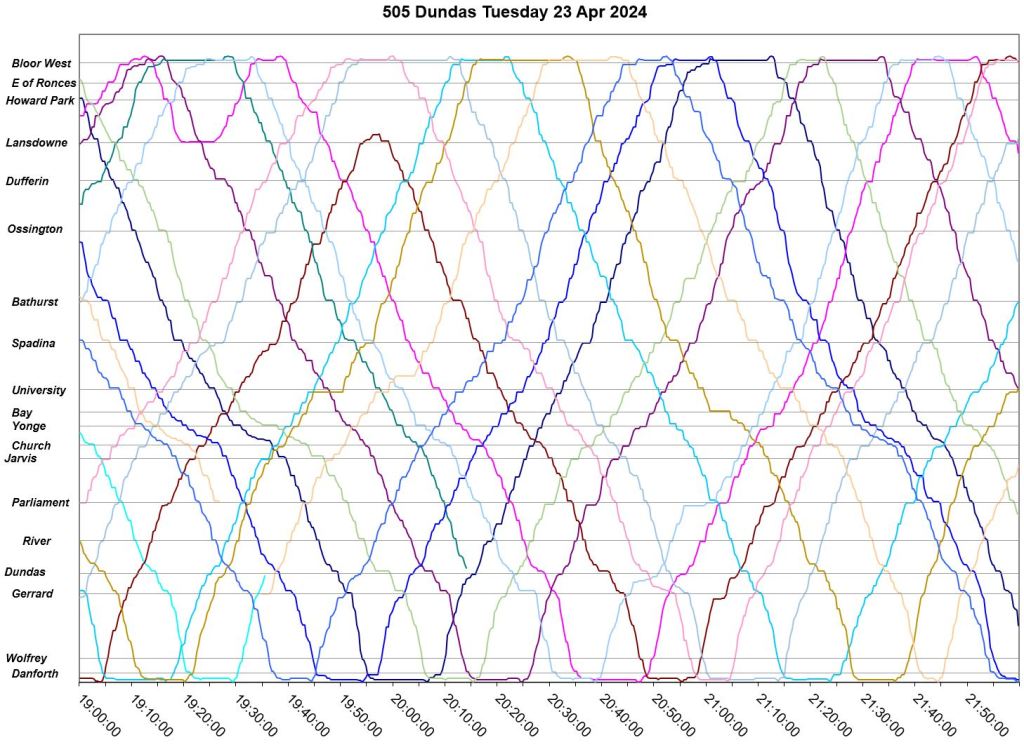
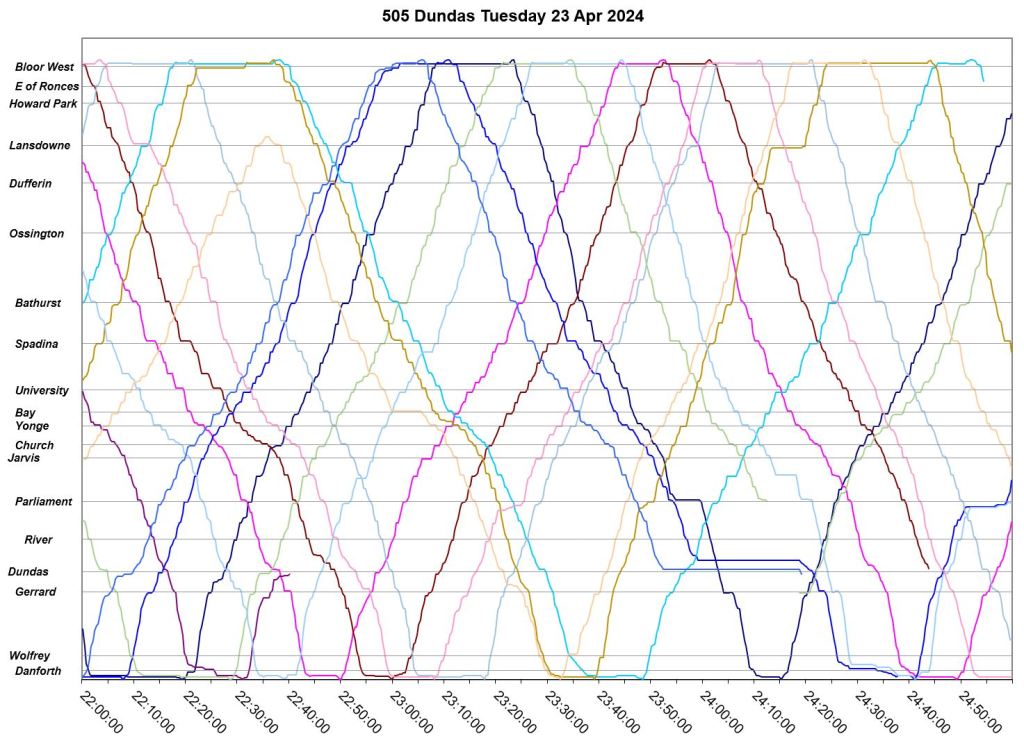
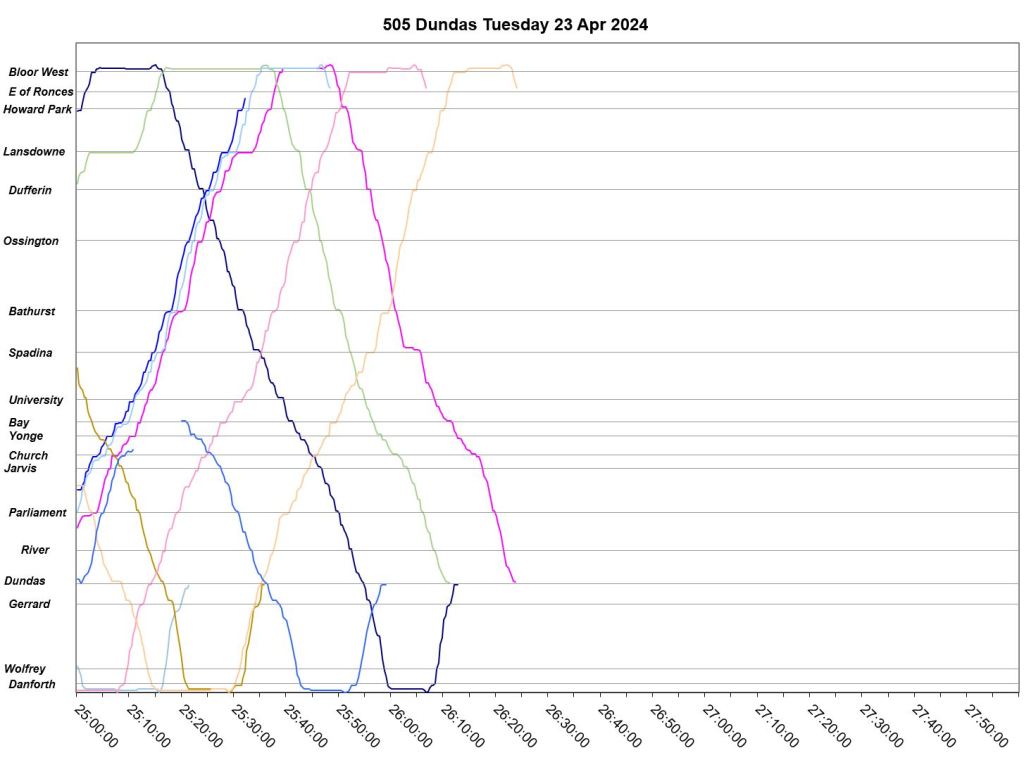
Wednesday, April 24
Events of note:
- Traffic congestion delays cars eastbound approaching University Avenue through the AM peak and morning. This pattern also appears on Thursday, April 25, but not on Tuesday, April 23.
- Westbound service is affected by congestion approaching Spadina in the PM peak, but this problem extends west to Bathurst.
- Short turns, mainly at Lansdowne but also at Parliament, are used to restore regular service throughout the afternoon and evening.
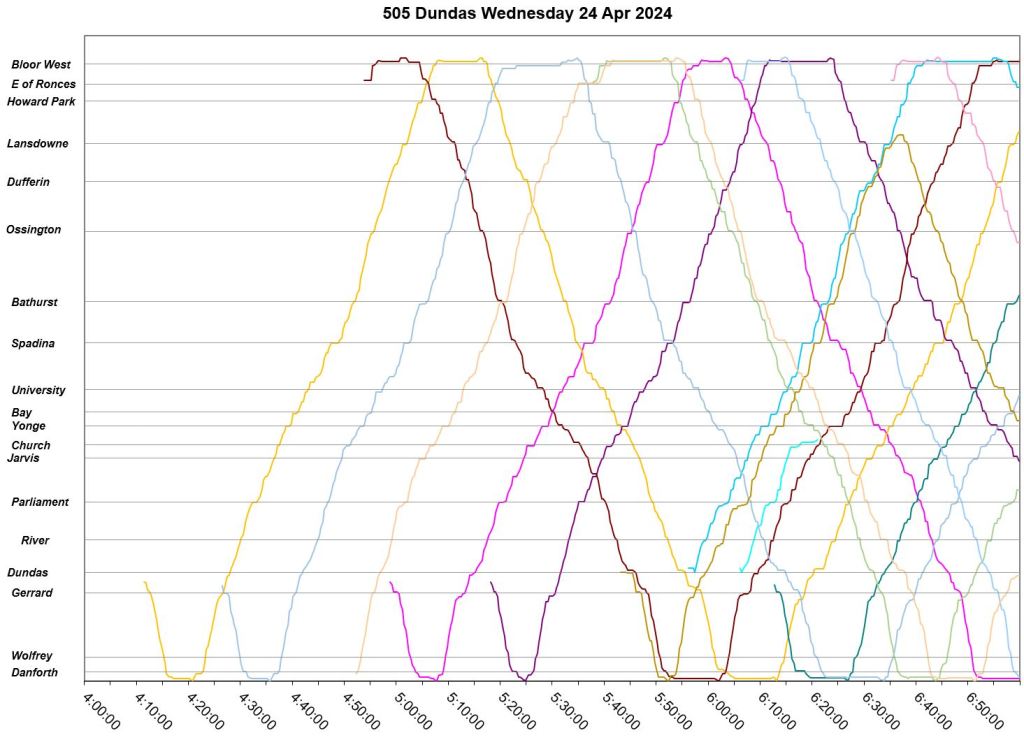
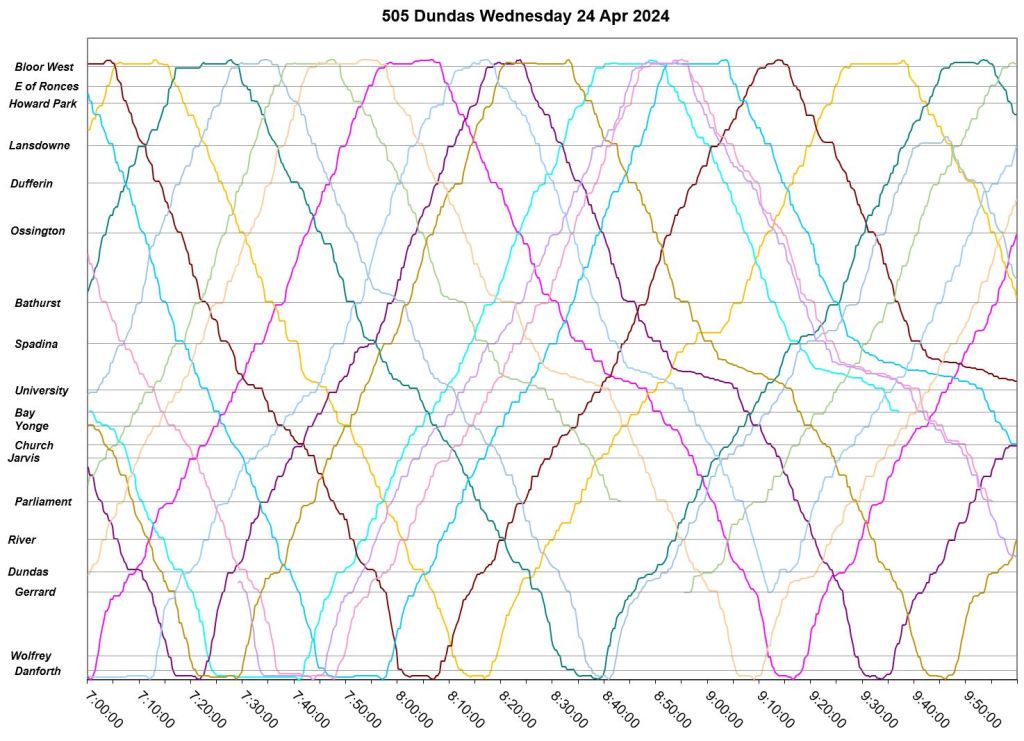
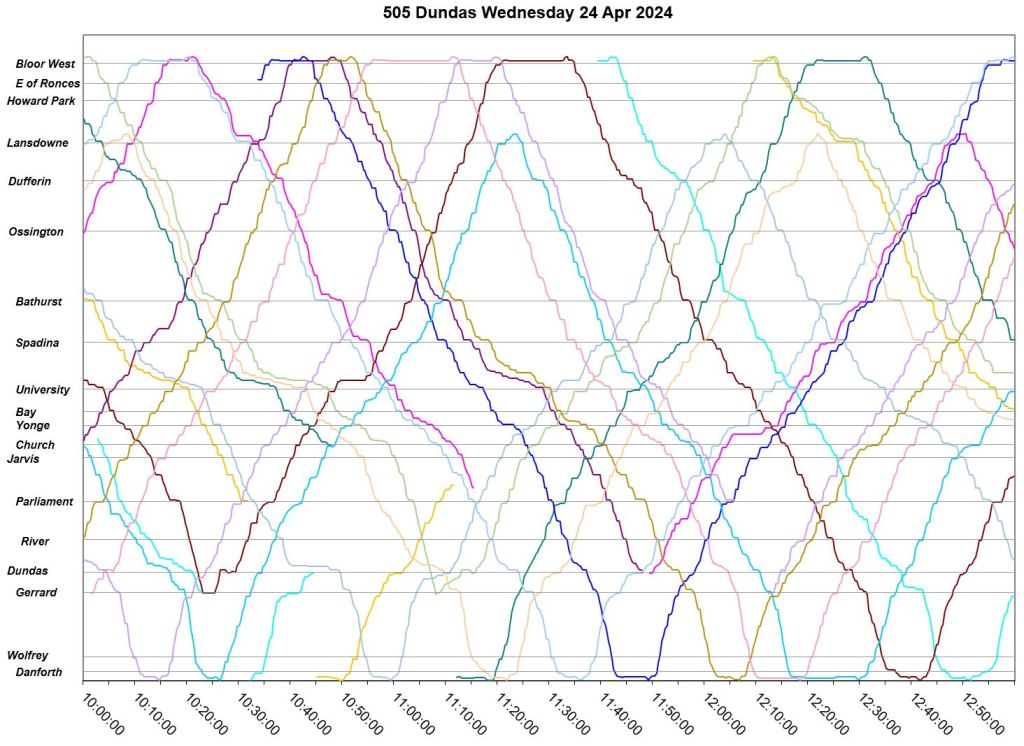
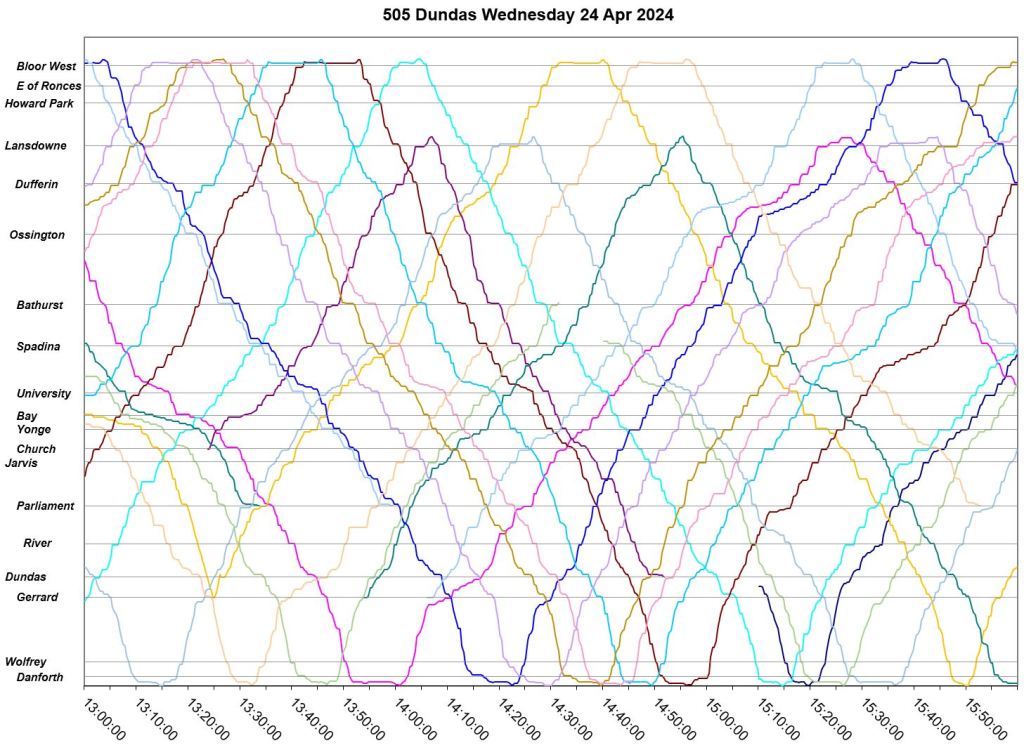
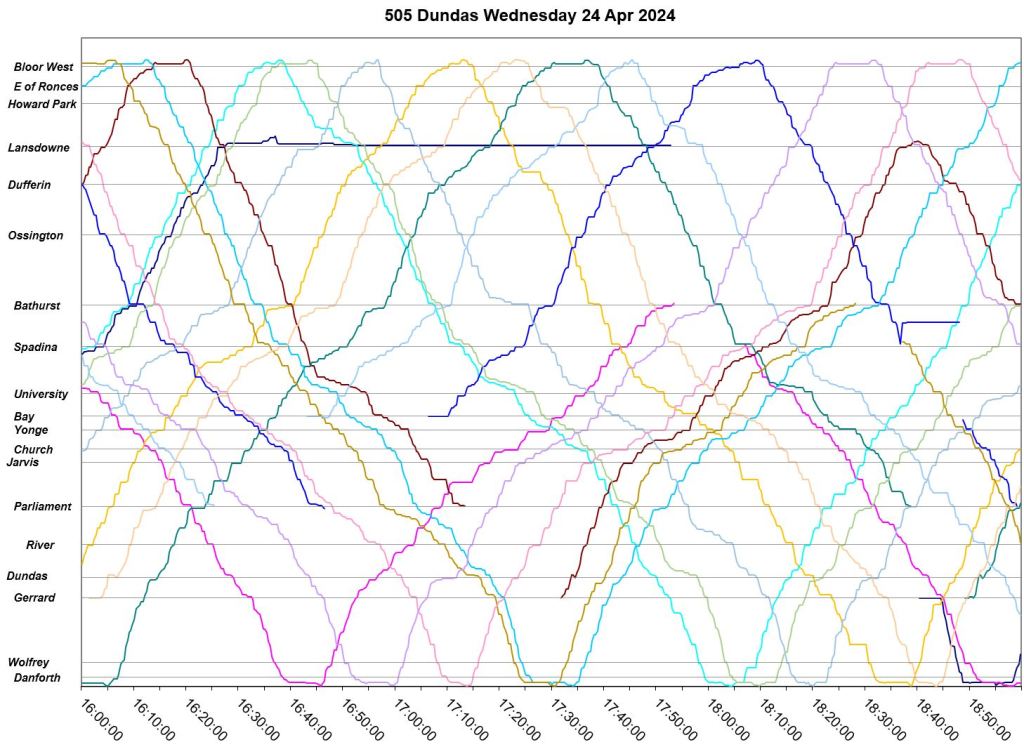
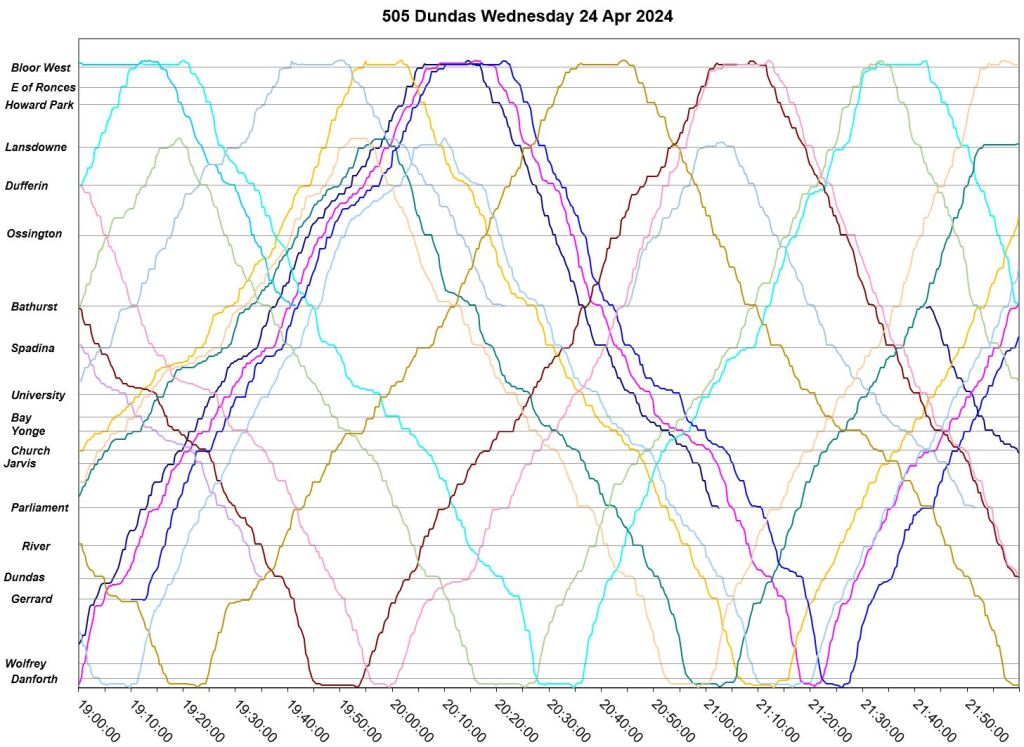
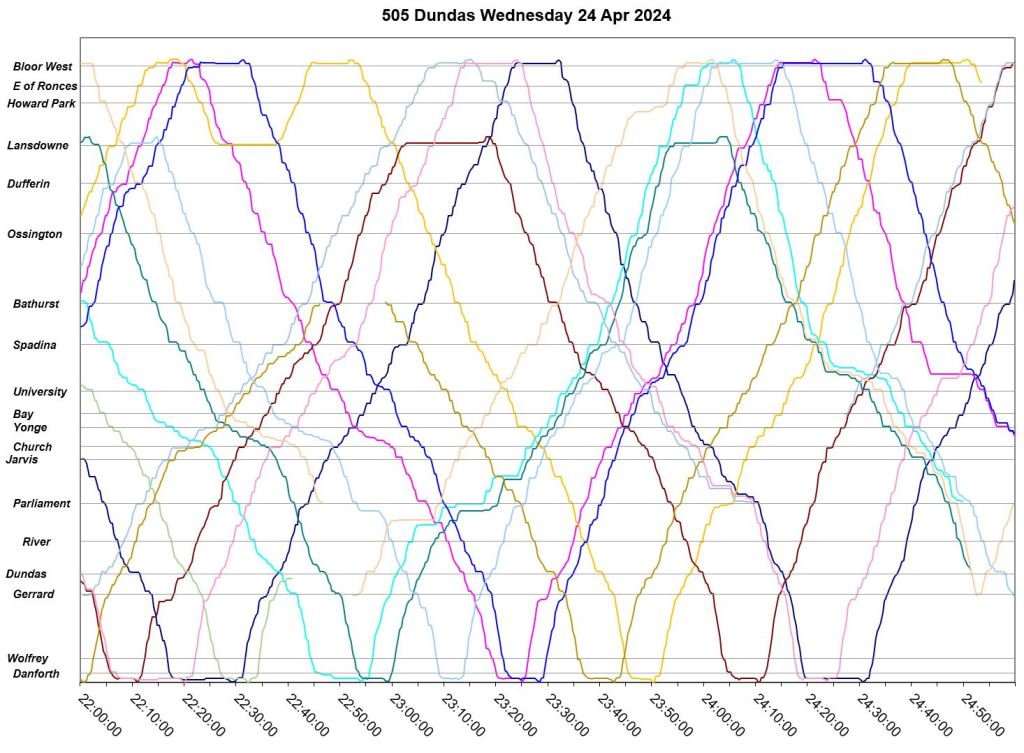
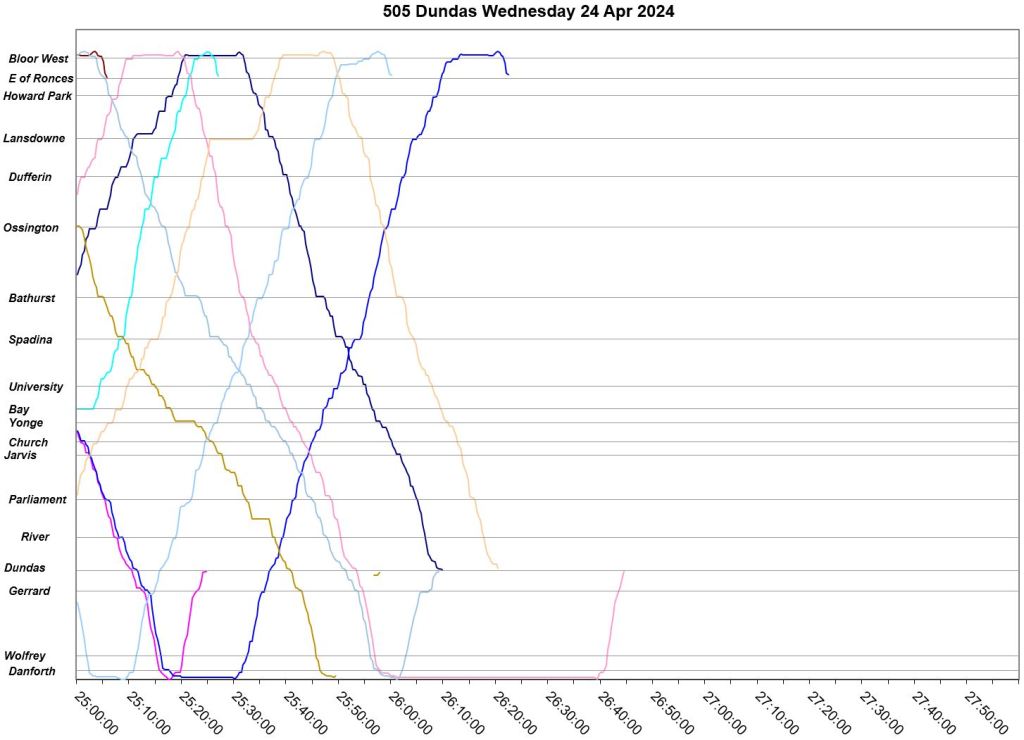
Thursday, April 25
Events of note:
- Congestion eastbound to Bathurst and to University, noted on some previous days, appears here in the late AM peak and morning.
- Congestion slows operation in the central area generally through the afternoon and PM peak, and short turns, mainly at Lansdowne westbound, are common up to the late evening.
- There is no event causing service blockage for the entire day.
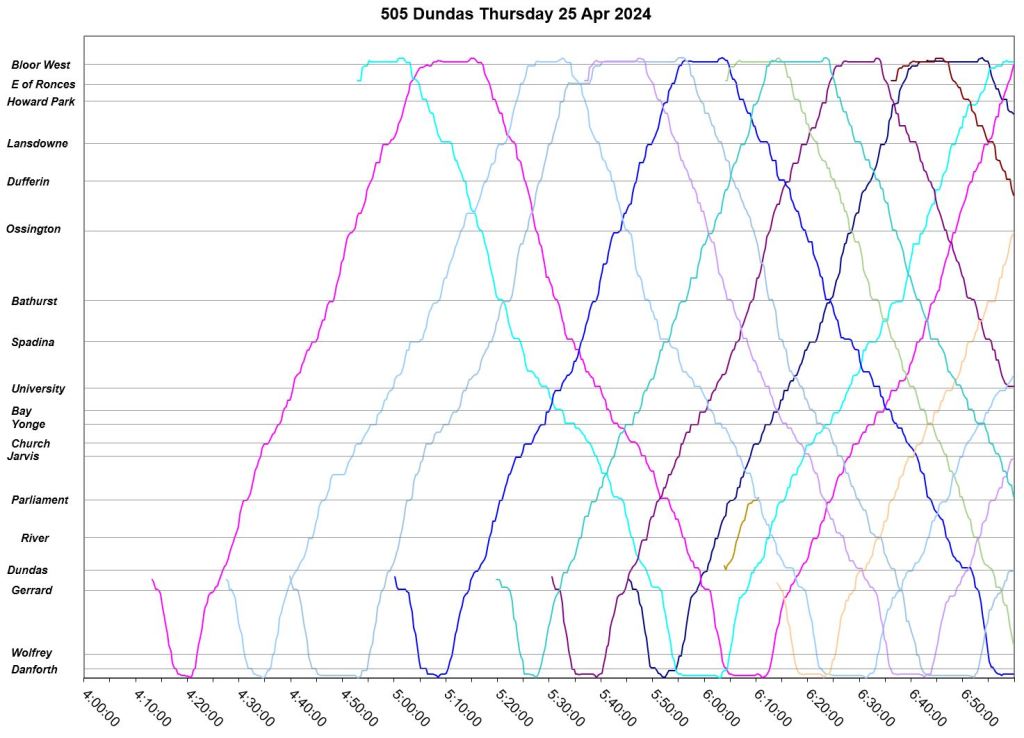
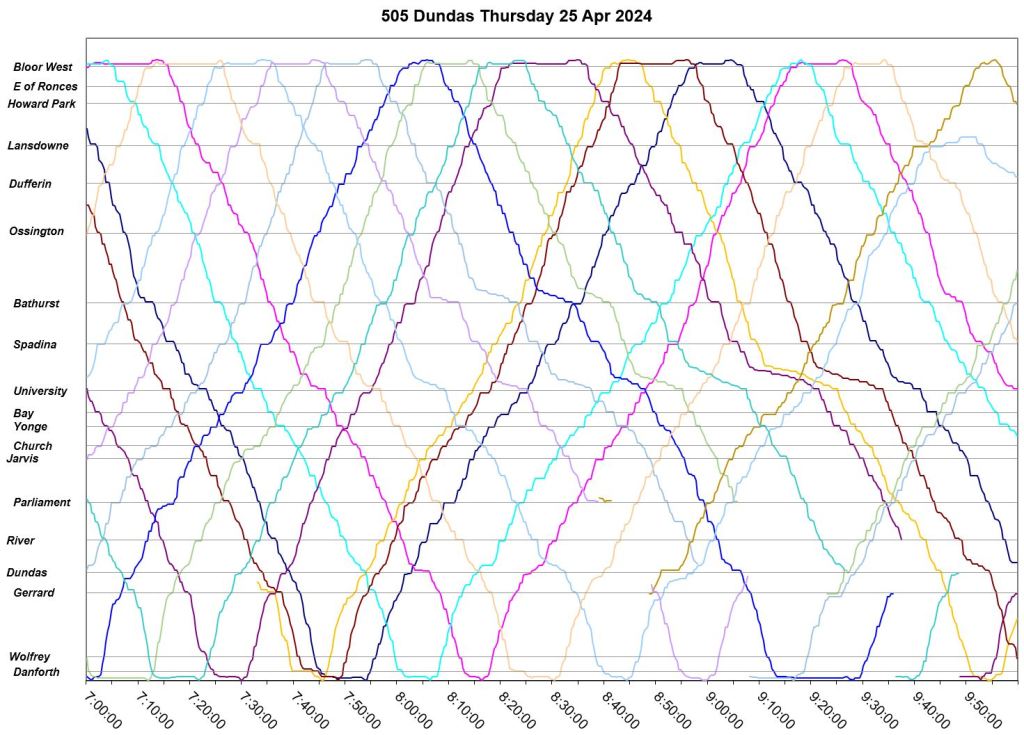
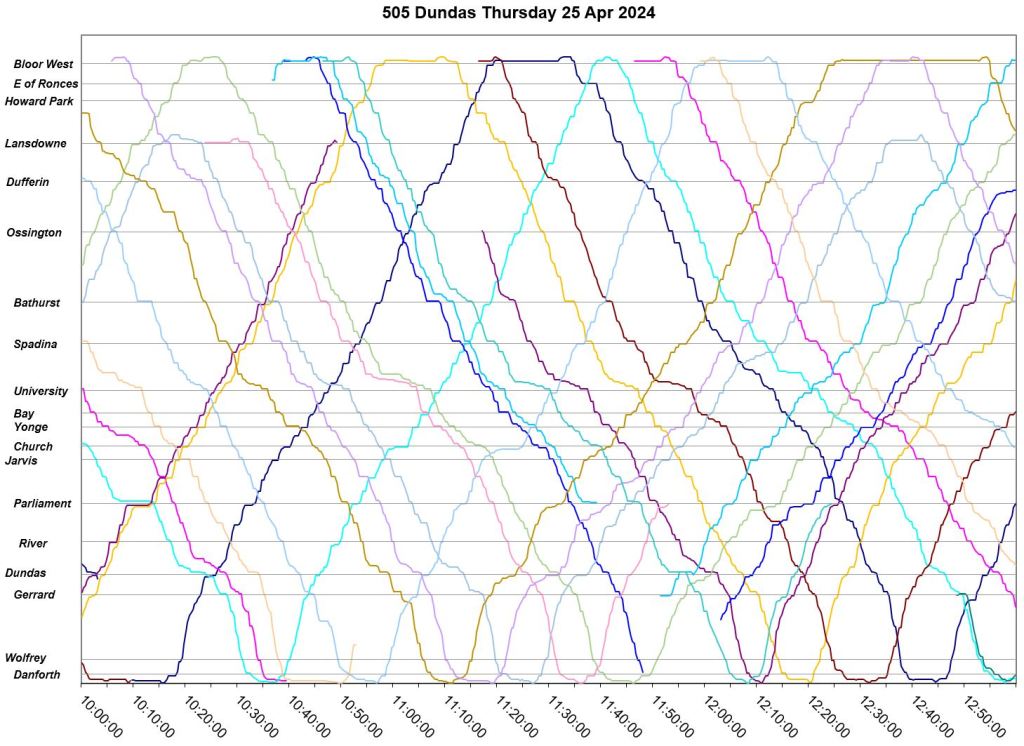
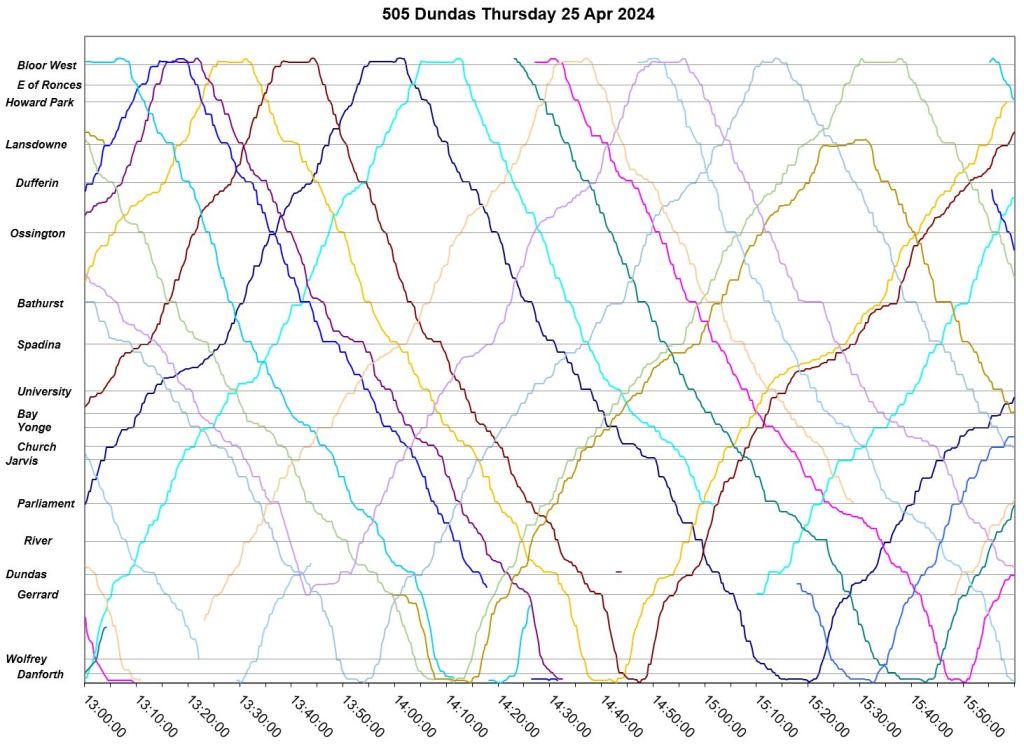
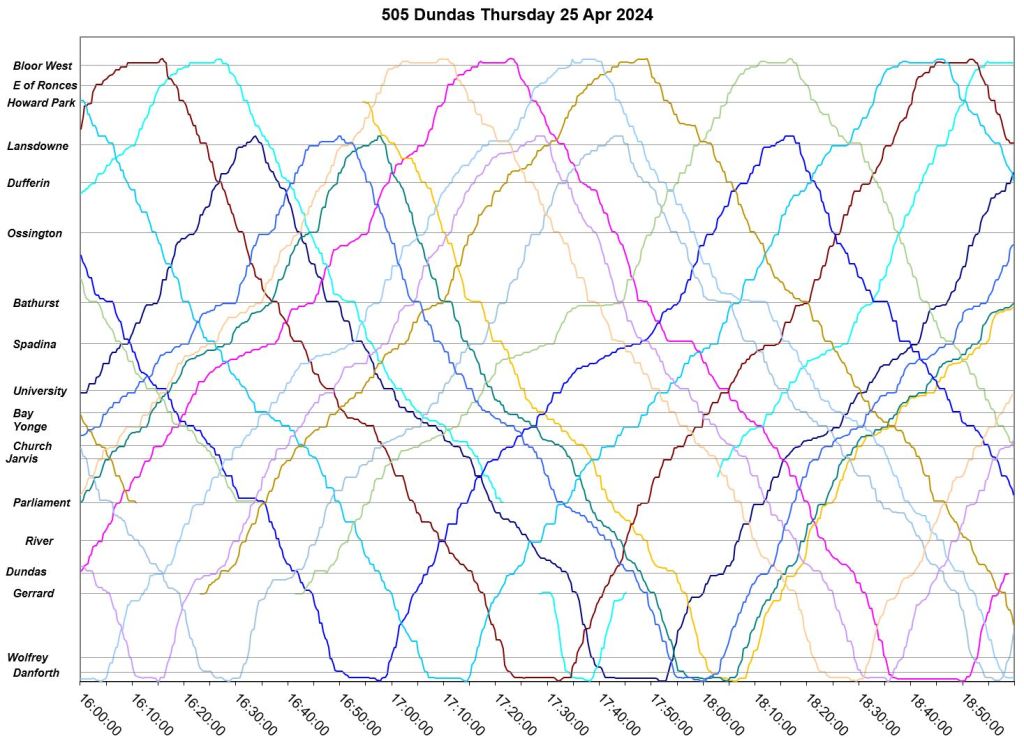
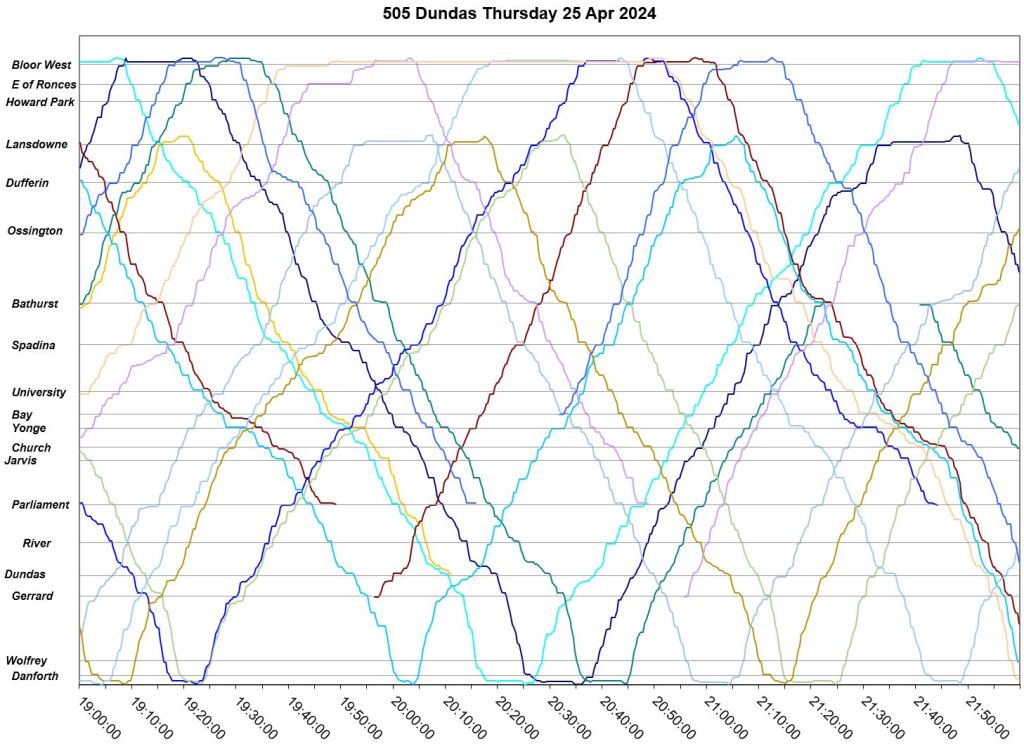
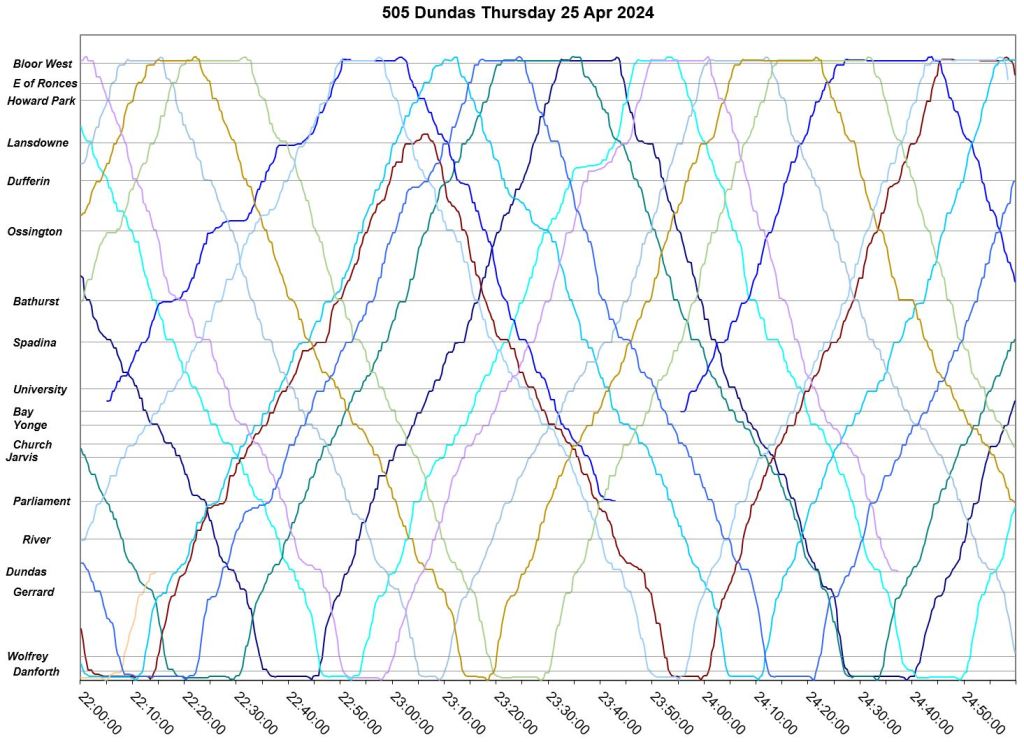
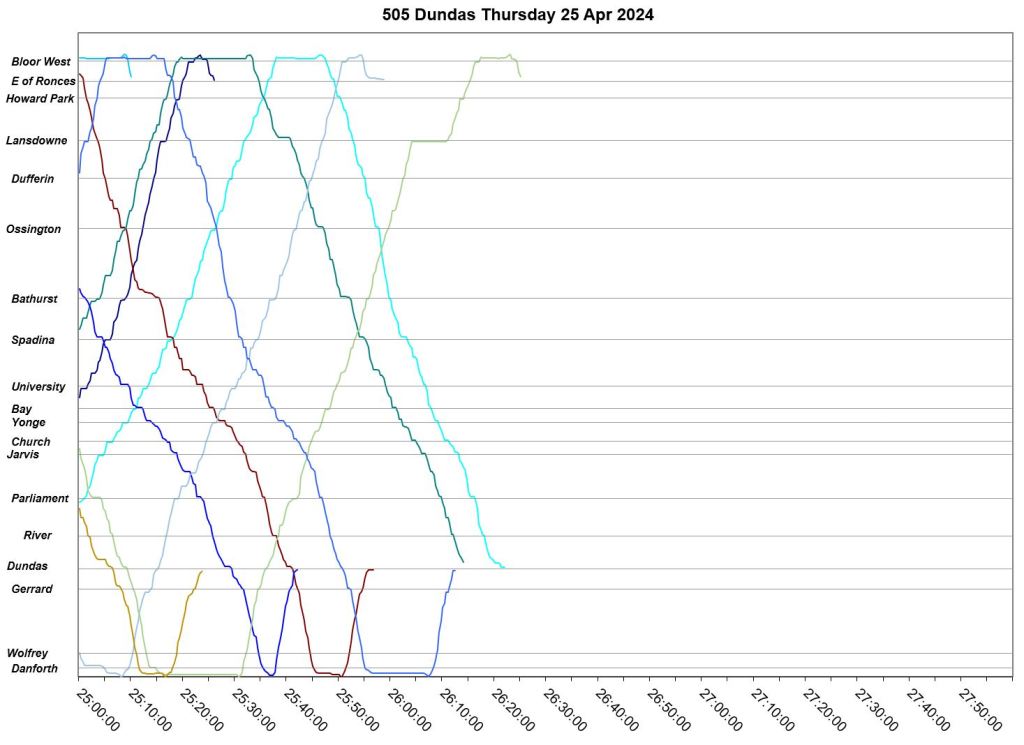
Saturday, April 27
Events of note:
- A collision (according to the eAlert) blocked service west of Lansdowne from roughly 5 to 6:45pm. Two cars were trapped at Dundas West Station, and all other service short-turned.
- Bunching continued and there was a large gap eastbound after 6pm from Lansdowne that echoed back from Broadview Station after 7pm, and again from Dundas West Station after 8pm.
- Severe congestion westbound to Spadina occurred in the early evening.
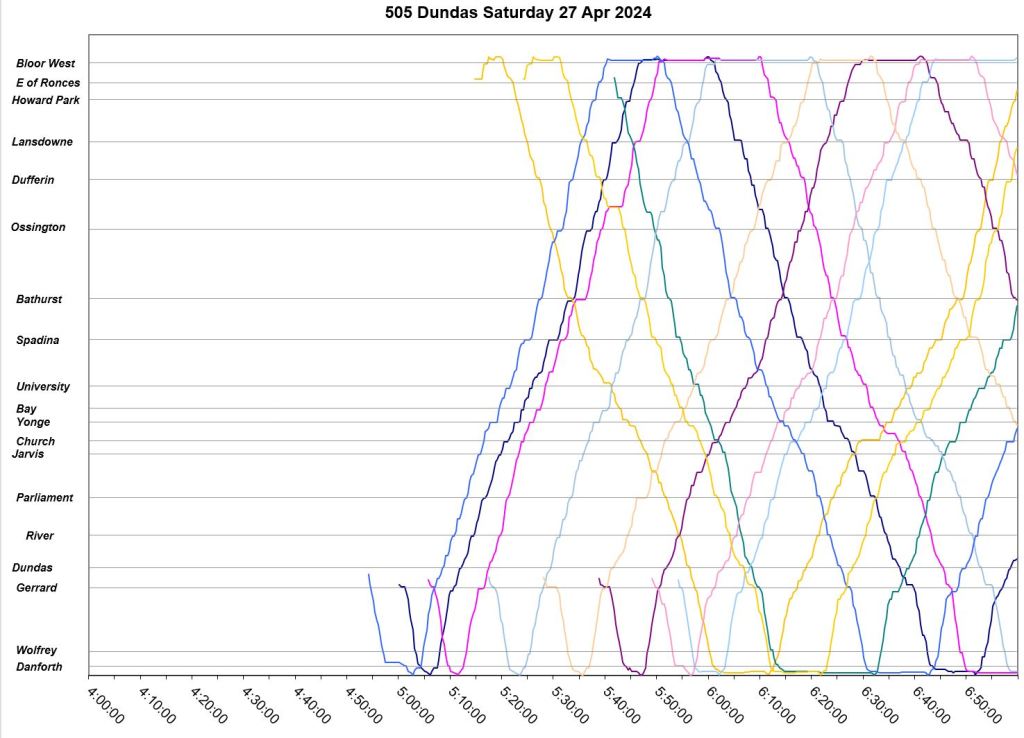
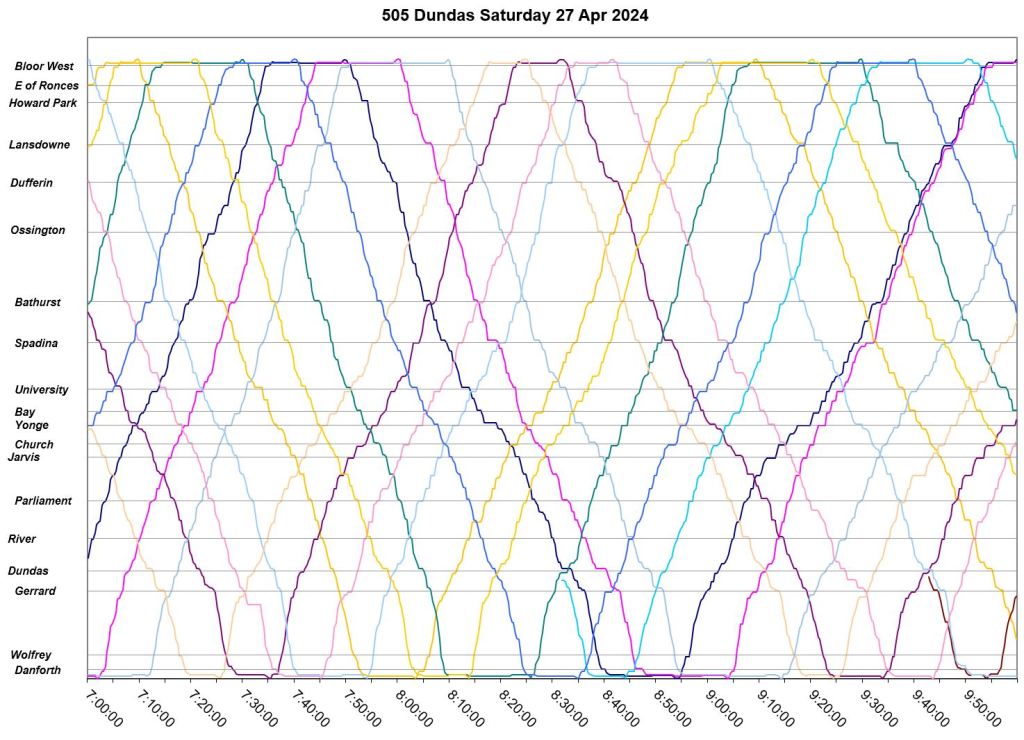
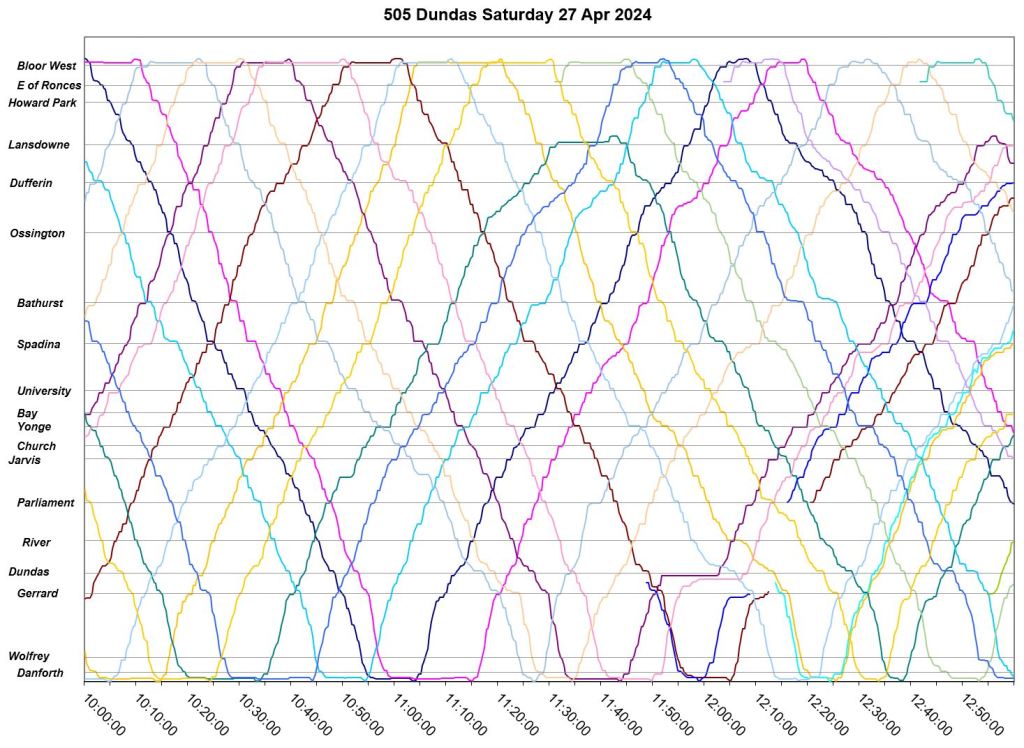
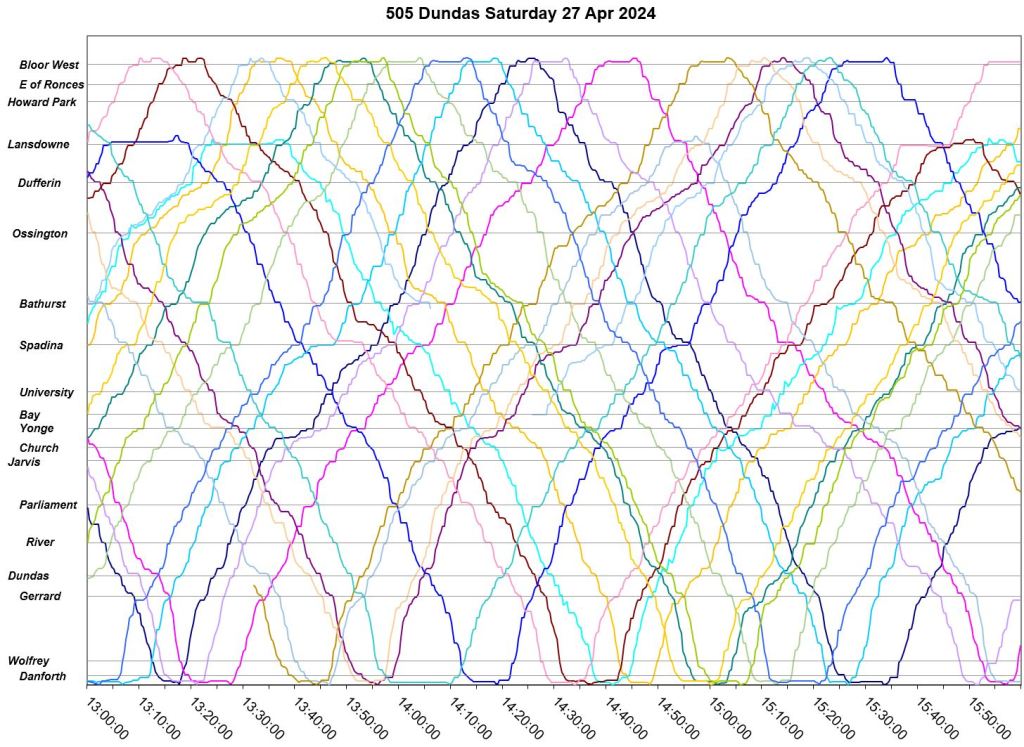
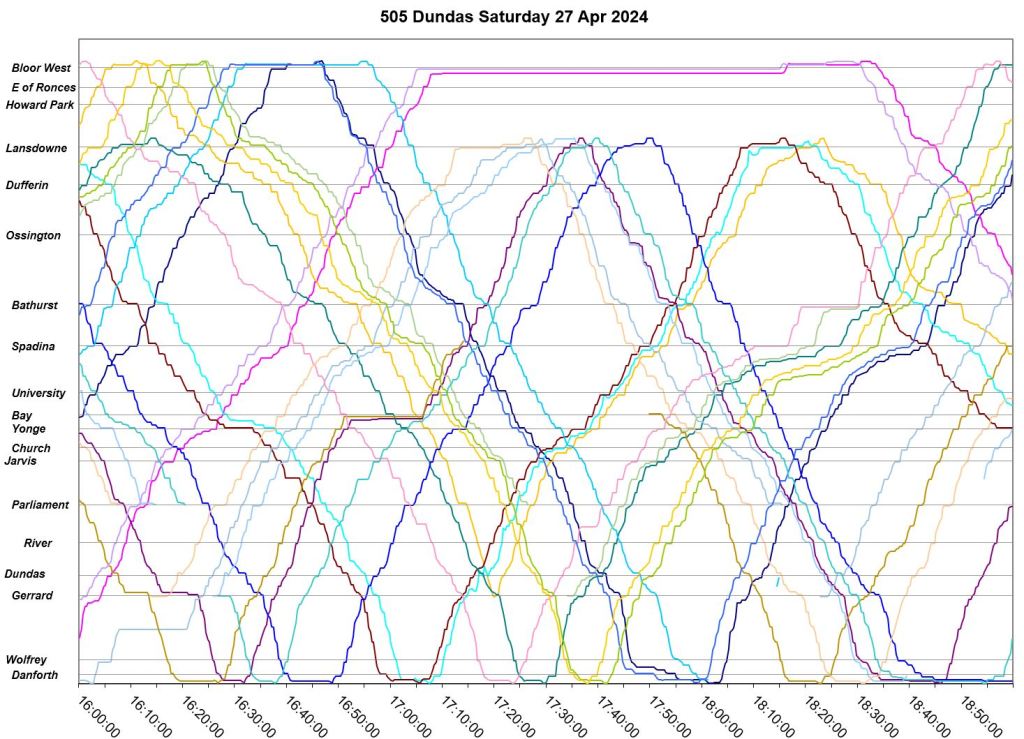
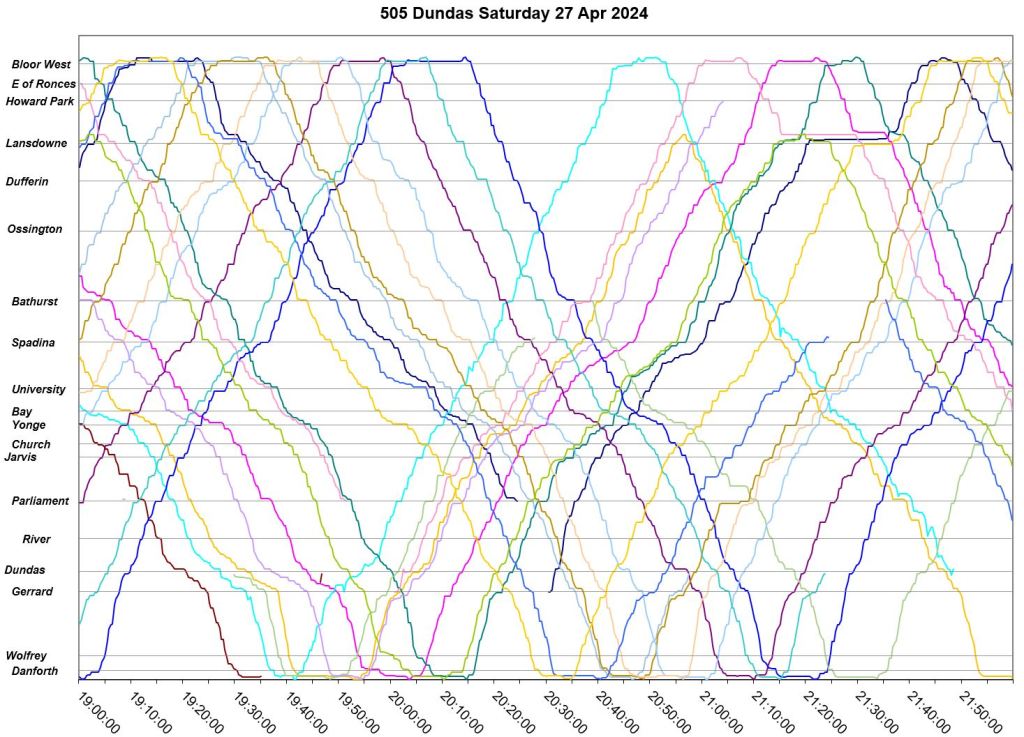
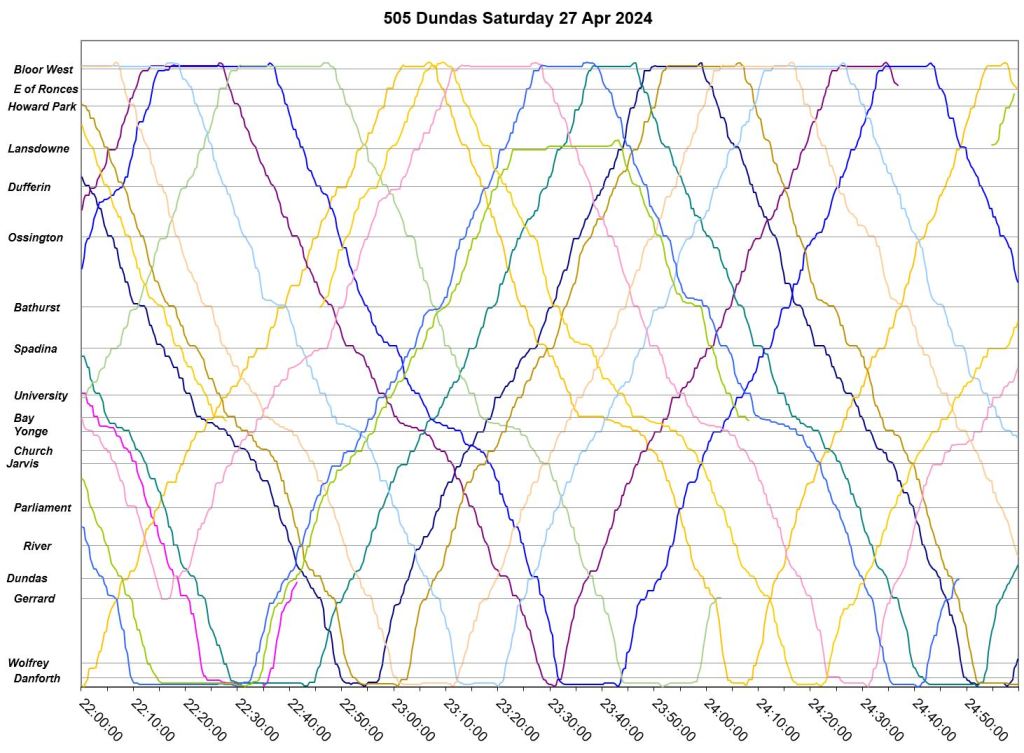
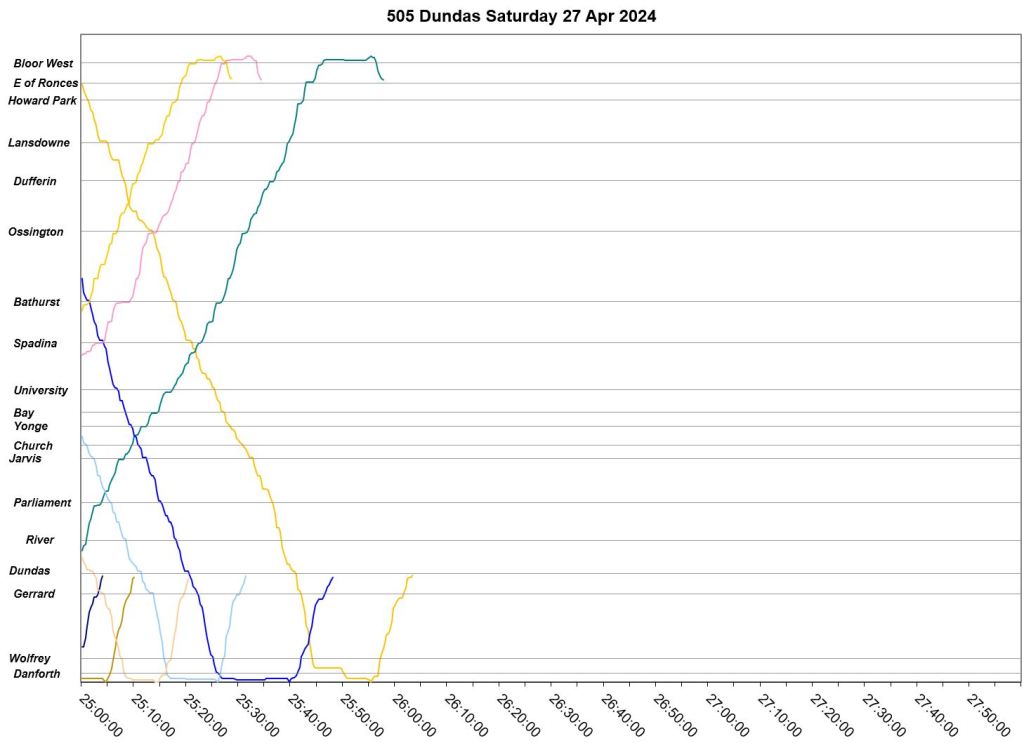
Short Turns
The TTC CEO’s Report includes statistics on short turns of scheduled service. This occurs when a vehicle turns back before reaching its destination to get back on time, sort of bunched service and fill inbound gaps. The success of this technique depends a lot on line management to ensure that cars are short turned when required and slotted back into service gaps if possible.
For several years there has been a no short turns policy, although that was denied for a time, and more recently acknowledged. Such a policy can make service worse than necessary short turns by leaving cars and buses bunched and running badly off schedule.
There are many examples in the charts above where short turns were used to break up bunching and restore better headways. That is what they are for. A common TTC scheduling technique to avoid this is to provide excess running time so that vehicles can always recover their scheduled times at terminals. There is a balancing act required between having enough travel time for typical conditions and having so much excess that vehicles dawdle along their routes and take extended layovers at terminals.
The target for short turns is 3% of all trips. Like many TTC metrics this suffers from averaging. An all-day, all-month value gives no indication of route level or time-of-of-day issues.
The charts below show the proportion of trips short turned at the common locations for 505 Dundas: eastbound at Parliament and westbound at Lansdowne. The values are derived by counting the number of trips crossing screenlines at Jarvis and Broadview eastbound, and at Dufferin and Roncesvalles westbound.
It is quite clear that the actual proportion of service that short turns is very much higher than the 3% target during many intervals. The spike for Saturdays at 5pm was caused by an extended delay where no service went west of Lansdowne. (See the operating chart for April 27 above.) Day-to-day values, particularly westbound, are often above 10%.
Note also that the weekday values late in the month are higher than early in the month. This corresponds with the segment level charts earlier where travel time values were high in Week 4 (Apr 22-26). Short turns are far more likely on days when travel times are extended.
The 3% target for short turns is probably not attainable except on the basis of very wide averaging including routes and times when service runs without incident. Such an average misrepresents the conditions real riders see on real routes.
There is also an arithmetic reality that must be faced. On a route with 10-minute service, there are only 6 vehicles/hour. Short turning one of these means that 16.7% of service does not reach the terminal. It is impossible to reach a 3% target for a granular metric looking at individual hours and individual days. This is only possible if data are averaged over a wider interval, and if very few vehicles actually short turn. The metric looks good in theory, but does not work in practice.
A related problem is that many short turns are not reported, and so the “stats” do not reflect actual operations, and exist only to make management appear to achieve notional standards. This was obvious in older versions of this metric where raw short turn counts rather than percentages were reported, but the numbers were far below actual counts in real tracking data.
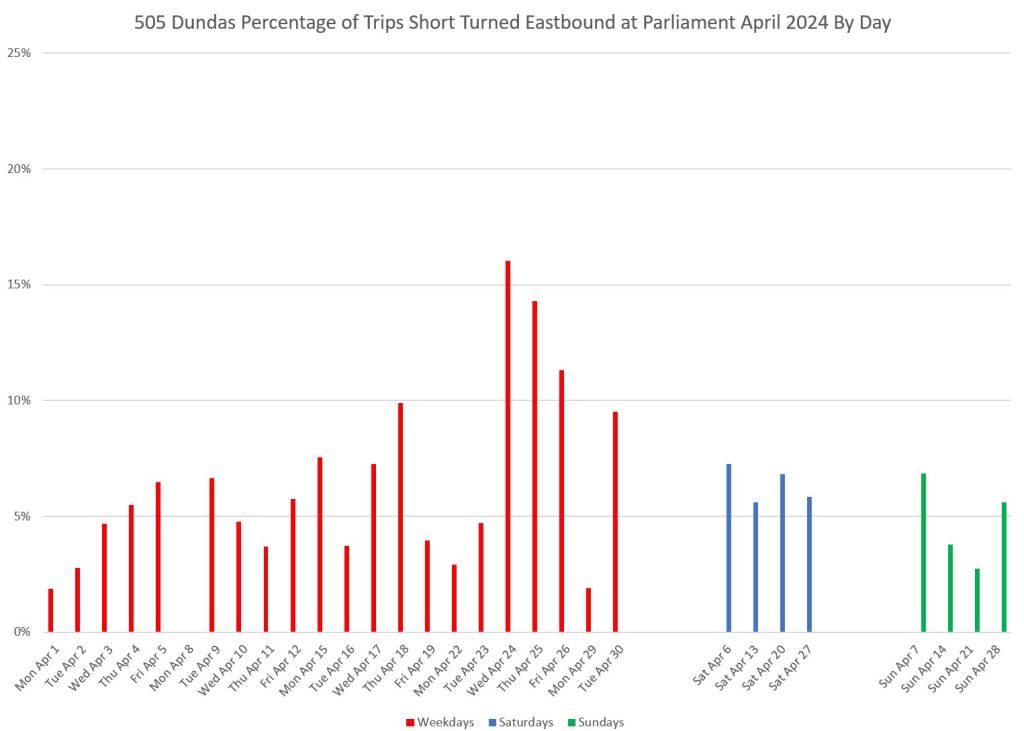

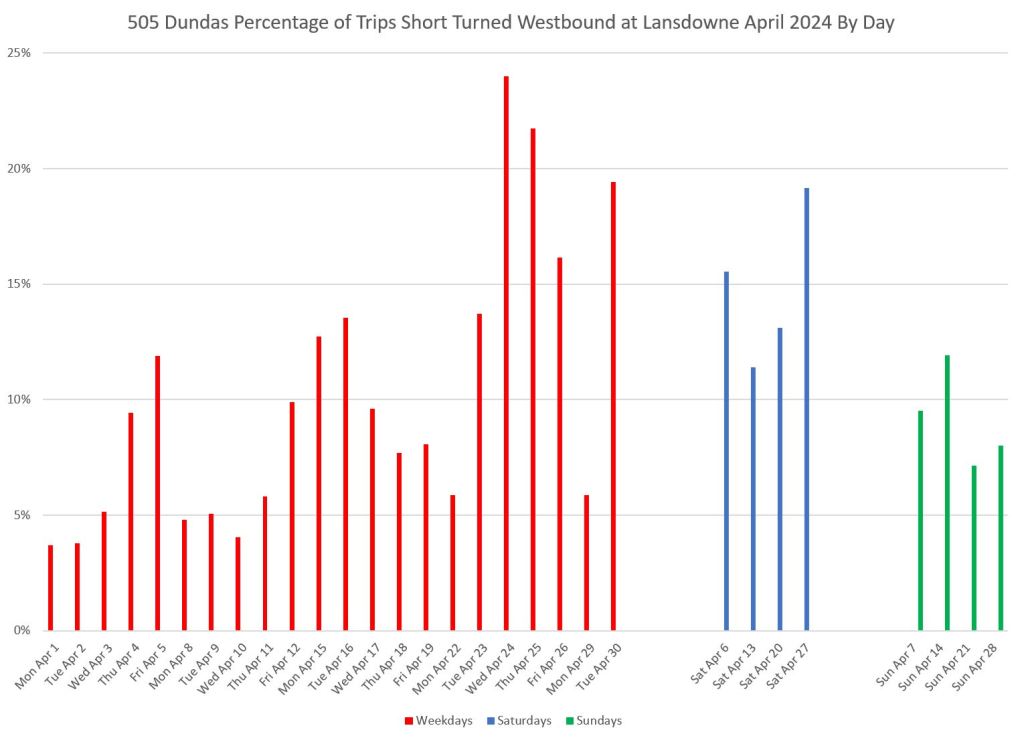


There’s usually a backup eastbound across the DVP with cars queued up to turn left to the DVP northbound on-ramp. I’m pretty sure that’s what causes the travel times to spike 1400-1800.
I’m not sure what should be done about that, but with the bike lanes, there is one lane that is through and left-turn, and it’s also the streetcar’s lane.
Steve: That’s part of it, but note that it varies by week and is highest when the extra traffic from the Queen bridge closure is added. Also, there has been a slow order on Dundas east of the bridge both ways for ages, and I suspect that the TTC has forgotten it.
LikeLike
Living close to Dundas and relying on the 505 quite a bit to get to work which admittedly is only 3 stops from my house to one stop past Bay. Going west is rarely an issue. East however as your data indicates is hopeless. I will normally walk up Bay to Dundas and just immediately give up and walk home to Church.
Something I find particularly aggravating is the lack of priority at Yonge and Dundas. Where one would think, in a logical world, that an approaching streetcar, and one present would supersede the stupid pedestrian scramble. Why a streetcar has to sit and wait out a full 3 phase signal is beyond comprehension. But like many intersections…. it seems the city simply does not care.
Just like the signal at Chestnut and Dundas which stops the streetcar. The problem in the east at Sketchbourne and Fundas is the endless supply of mentally unstable people who board and than cause issues further along the line. Simple solution here, deactivate the stops east of Jarvis to Parliament and Parliament to Jarvis. Or make it a rolling boarding. where the streetcar slows down and you have to run along side it and jump on. The people who have problems are terrible at coordination. (that’s a joke)
Steve: You had me until the last paragraph. We have already seen shelters and benches removed at “problem” stops by our oh-so-sensitive City. Also, there are people with mental health issues west of Yonge too. Maybe you don’t get out that far. In any event, what do we do? Abandon entire routes?
LikeLike